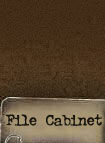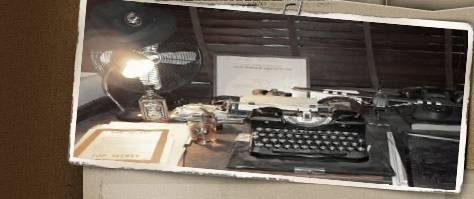|
|
| Historical images compared with
the current situations in the exact
locations.
Click on the pictures to
enlarge. |
|
Normandy Holland(2)
Ardennes
Wordwide |
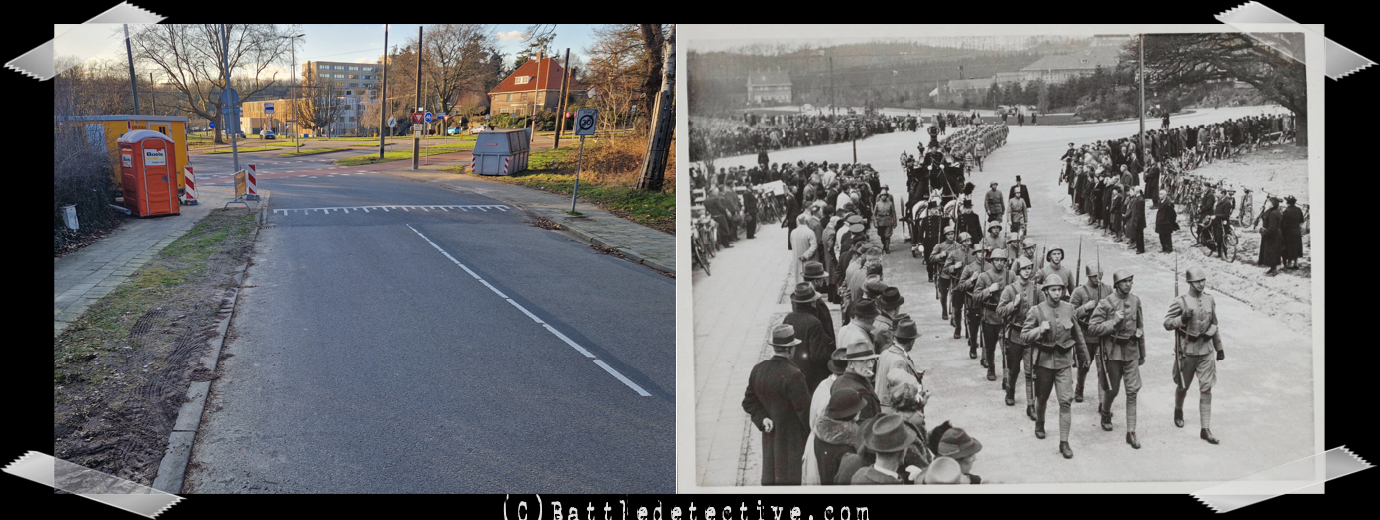 |
Arnhem, April 1940
Less than a month and a half before
the invasion of The Netherlands by
the Third Reich, two British RAF
pilots had crash-landed on Dutch
territory. They did not survive and
here we see the funeral procession
from the Gemeenteziekenhuis hospital
to the Moscowa cemetery. The pilots
were buried with military honors. |
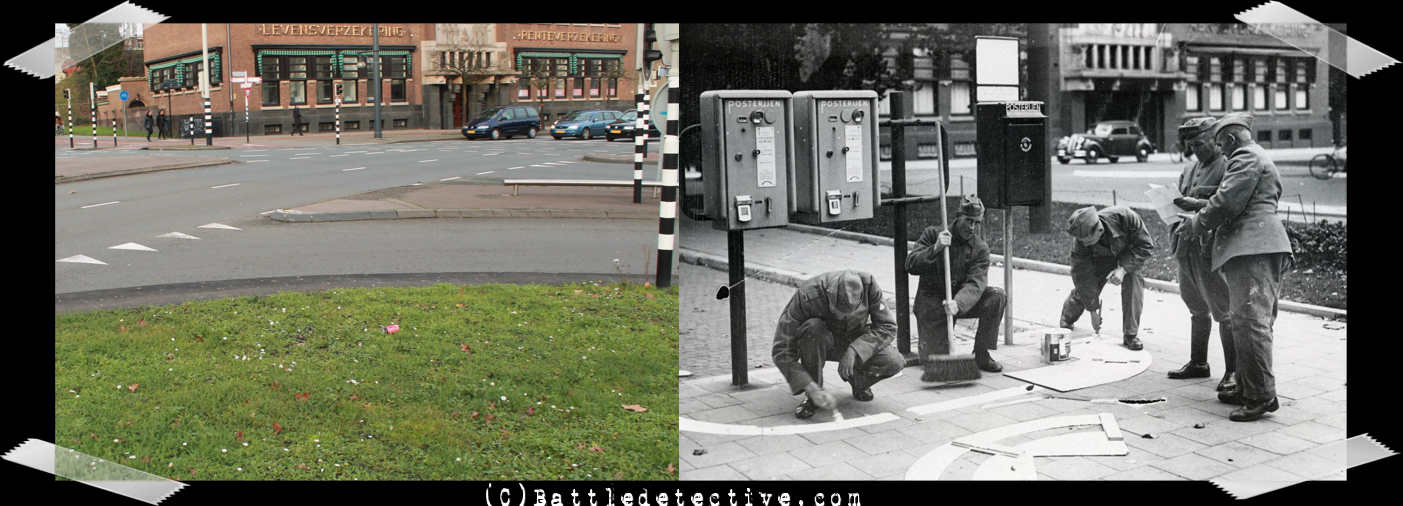 |
Arnhem May 1940
During the military mobilization in
the months before the German
invasion, Dutch conscripts take
black-out precautions on
Jansbuitensingel painting white
stripes on the pavement in front of
mail boxes and stamp vending
machines. |
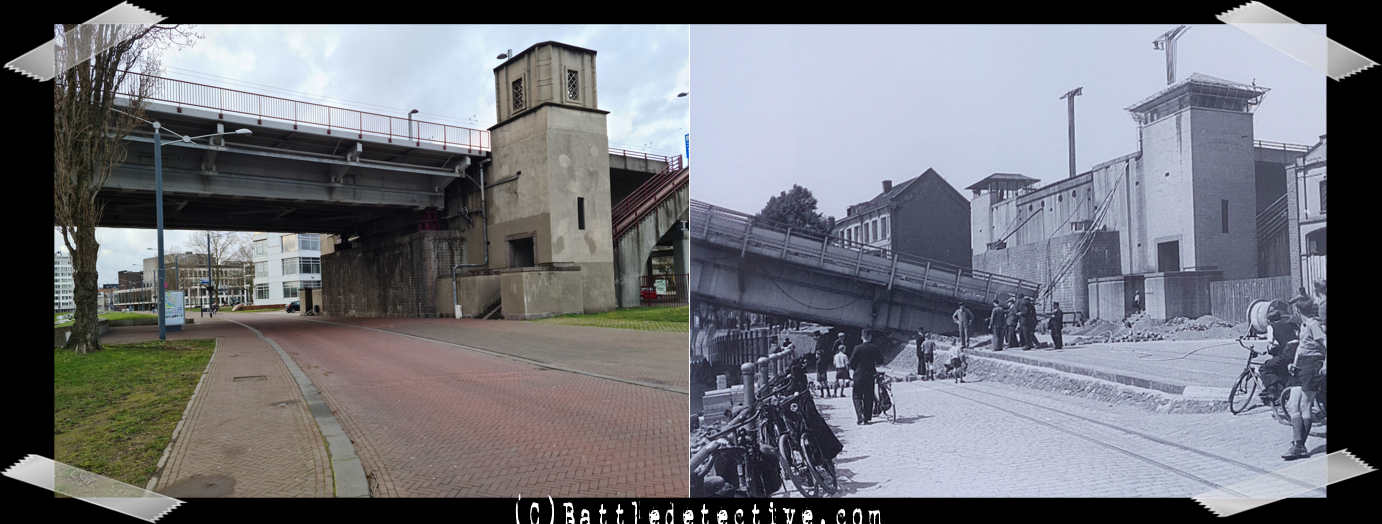 |
Arnhem May 1940
The road bridge across the river
Rhine in Arnhem has been demolished
by the Dutch military authorities
when Germany invaded the Netherlands
on May 10th, 1940.Note shelters on
the stairwell towers, originally
designed as toll boots but toll was
never charged on this bridge. |
 |
Tilburg, May 10th 1940
German motorized troops invading
the Netherlands. Right behind the
photographer is the bridge across
Wilhelmina canal which has been
blown up by the Dutch. The column
has to wait until pioneers have
built a new crossing. |
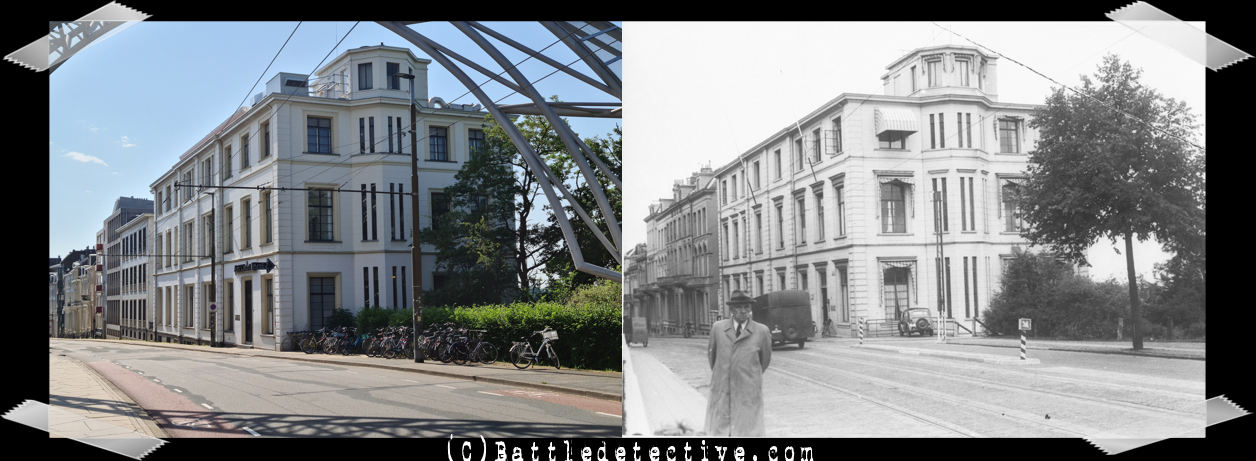 |
Arrnhem, early 1940's
Utrechtsestraat 55A (today's
number 85) was requisitioned by the
German Sicherheitsdienst to be used
as their "Aussenstelle Arnheim"
where arrested Jews, communists and
resistance fighters were
interrogated. We assume that the
photo was taken secretly under the
guise of portraying the detective in
the foreground. |
.jpg) |
Arrnhem, early 1940's
During the German occupation of
the Netherlands, pedestrians walk by
the Musis Sacrum theater on
Velperplein which has been converted
into a "Wehrmachtsheim" or Third
Reich Armed Forces Home. |
 |
Eindhoven, early 1940's
During the occupation of the
Netherlands by Nazi Germany a unit
of German soldiers marches through
Willemstraat. |
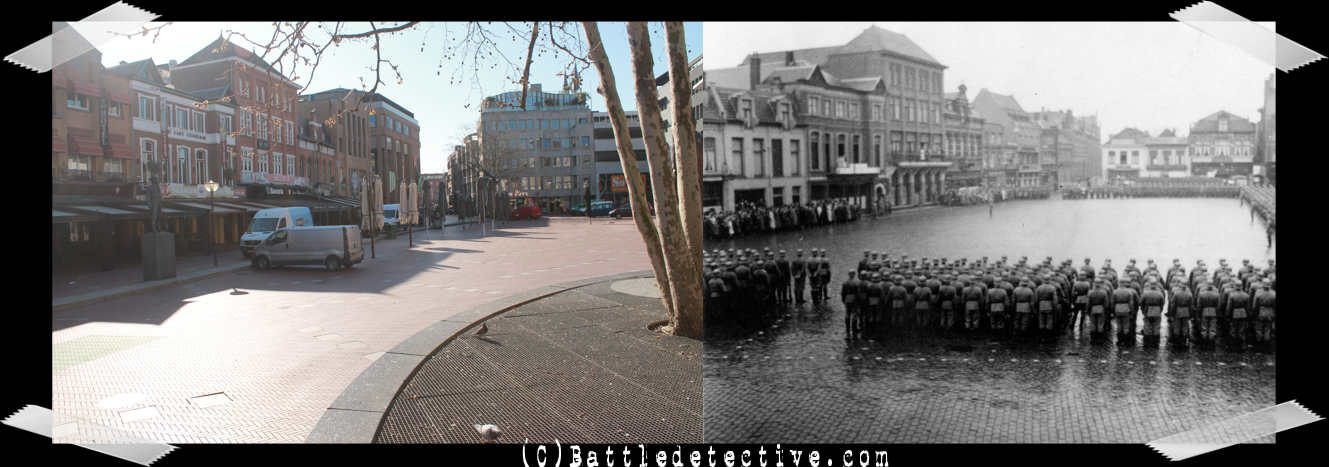 |
Eindhoven, early 1940's
German soldiers stand at
attention during a military ceremony
held on Markt. "Now-"photo taken
during the 2020 COVID-19 crisis
hence the lack of bystanders in the
center square of the city. |
 |
Eindhoven, early 1940's
On a winter day we see a van parked
on Vestdijk in the center of the
city looking south. The sign in
front of the vehicle says:
“Wehrmachtstankstelle” (German armed
forces fuel station) and “H.K.P.”
for Heeres-Kraftfahrpark (Army motor
pool). |
.jpg) |
Eindhoven, December 6th 1942
The aftermath of the RAF
Operation "Oyster" or what is known
in Eindhoven as the Saint Nicolas
bombing raid on December 6th 1942.
The targets of the operation where
the Philips Works. |
.jpg) |
Eindhoven, December 6th 1942
This is the damage done on the
factory buildings on Mathildelaan.
The postwar construction of a
parking garage across the street
makes an exact comparison
challenging. |
 |
Amsterdam, Fall of 1944
Sentry in front of the Third Reich
Kriegsmarine building on Emmaplein.
Photographer was Charles Breijer of
"De Verborgen Camera" (the hidden
camera). Note his shadow in
foreground where he's operating his
camera from his bicycle satchel. |
 |
Arnhem, 1943-1944
German
Luftwaffe operators of the
"Y"-navigation system pose on the
steps of the Christian Lyceum (Now
Montesori School) on Utrechtseweg.
The unit was stationed here from
August 1943 to September 1944. |
 |
Arnhem, September 6th 1944
A British photo reconnaissance
Spitfire of the RAF’s 541 Squadron
made a "dicing run" over the Arnhem
road bridge; the number one
objective of operation "Market
Garden". This oblique photo was shot
to examine enemy anti-aircraft and
other defense installations in the
area the bridge. Now-photo taken
from the postwar Nelson Mandela
Bridge. |
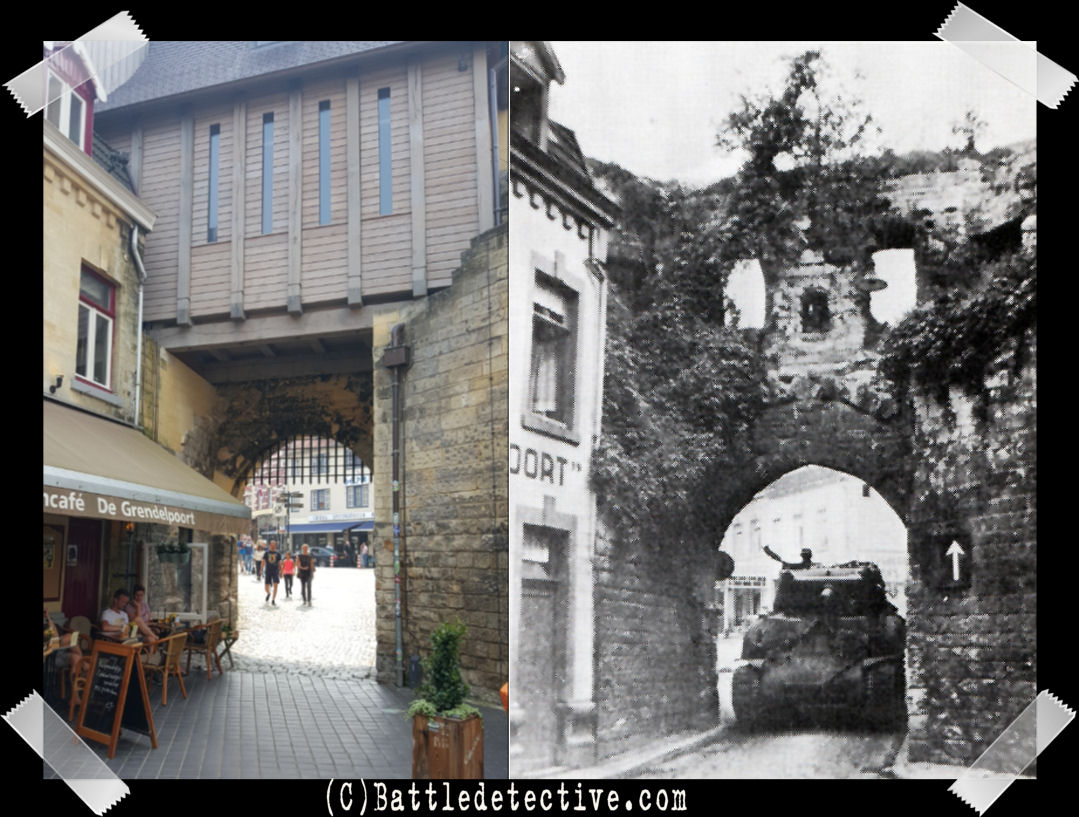 |
Valkenburg, September 17th 1944
An M4 Sherman tank of the
American 2nd Armored Division
(nicknamed "Hell on Wheels") drives
through the Grendelpoort Gate
entering the medieval downtown area
of Valkenburg in the Dutch province
of Limburg. |
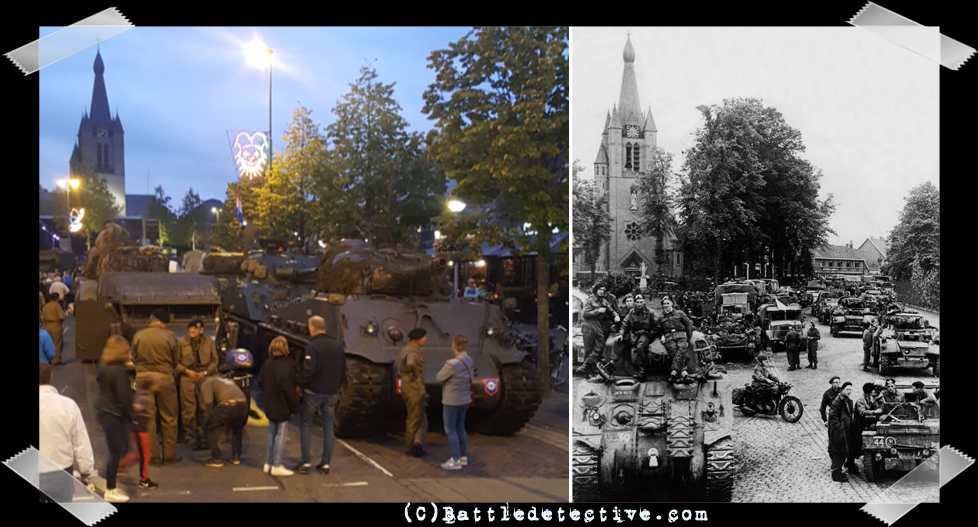 |
Valkenswaard,
September 17th 1944
On the first day of
Operation"Market Garden" the
spearhead of the British 30th
Corps, the Guards Armored Division,
stopped on Market square in
Valkenswaard to camp for the night.
The British started their attack in
the afternoon and encountered more
German resistance along "Club
Route", the route of advance, than
expected. |
 |
Valkenswaard,
September 21st 1944
British trucks and other
vehicles of the 4th Wiltshire
Regiment on Markt square later into
Operation "Market Garden".
"Now'- photo, and the previous one,
were taken on 16SEP2019 of the
Liberation Task Force during the
75th commemoration of the Operation. |
 |
Aalst, September
18th 1944
After having spent the night in Valkenswaard, the armored column of
30th Corps advances north towards
Eindhoven. In Aalst, just south of
the city, they are held up by German
88 millimeter guns at the Eikenburg
estate further up the road. |
 |
Aalst, September
18th 1944
A British M4 Sherman tank takes
cover behind a building at the
junction of Emmastraat en the main
road which leads to Eindhoven and
eventually to Arnhem. |
.jpg) |
Aalst, September
18th 1944
An Irish Guards Sherman has taken position
perpendicular to the road with its
main gun pointed north towards Eindhoven.
Flat trajectory fire from the 88s
could not reach this point, so the
damage to the bakery shop must be
caused by British artillery which
knocked out a German StuG moments
before and a hundred yards south of
this location. |
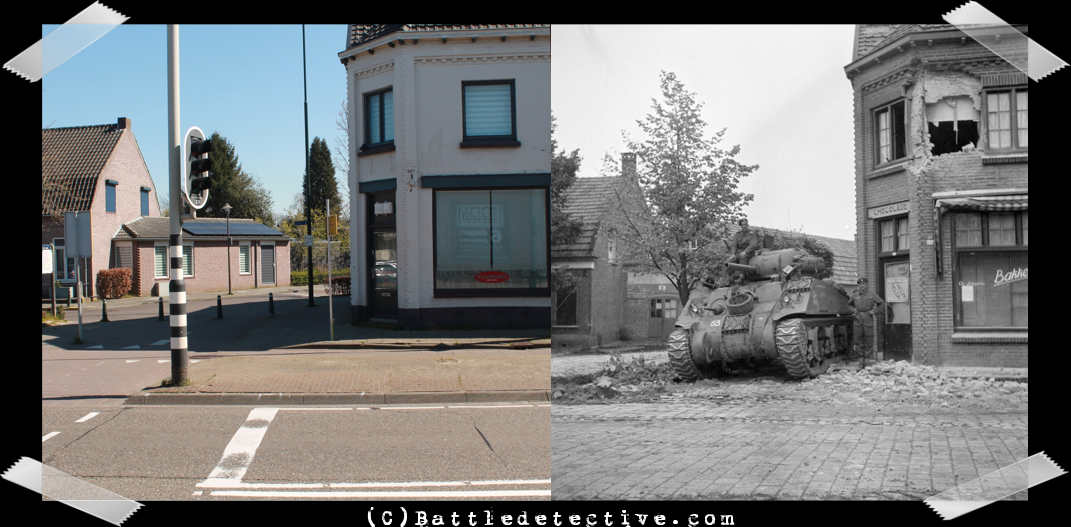 |
Aalst, September
18th 1944
Tank crew members have
dismounted from their vehicle after
forward elements of the Irish Guards
have dealt with the German 88s
up ahead. German counter attacks on
the route to Arnhem led to the
Allied soldiers dubbing this road
"Hell's Highway". |
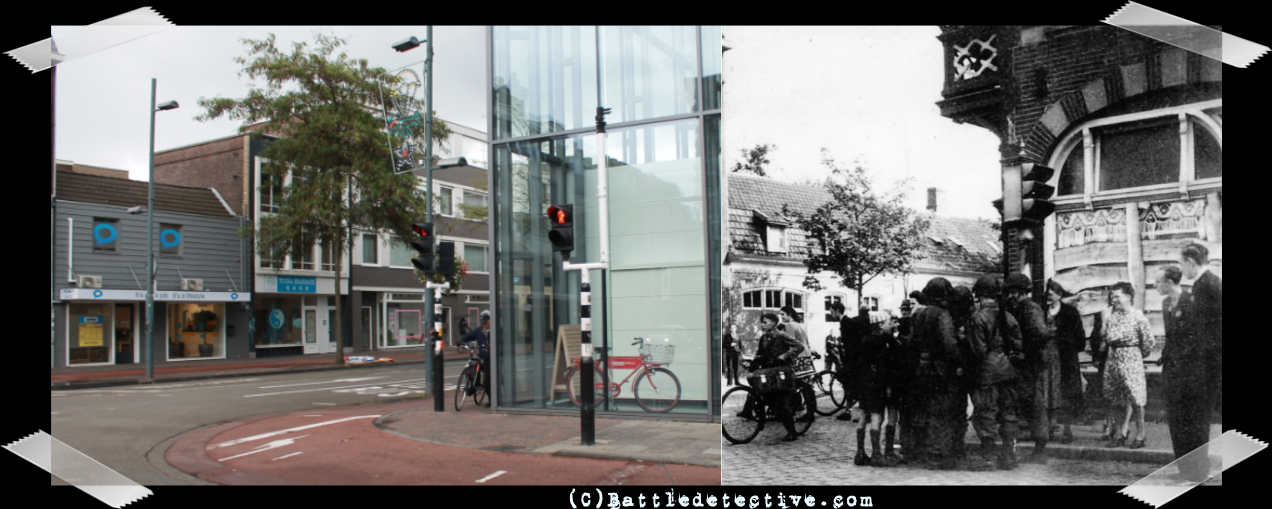 |
Eindhoven,
September 18th 1944
American paratroopers of the 101st
Airborne Division discuss tactics on
the corner of Grote Berg and Wal in
Eindhoven. The building on the right
was a tobacco shop and in
today's glass building is the office
of a student housing rental agency. |
 |
Eindhoven, September 18th 1944
An American paratrooper of the
101st Airborne division patrols
Prins Hendrikstraat passed house
number 51 while Mr. A. Dankers tells
a young boy in a party hat to make
way. |
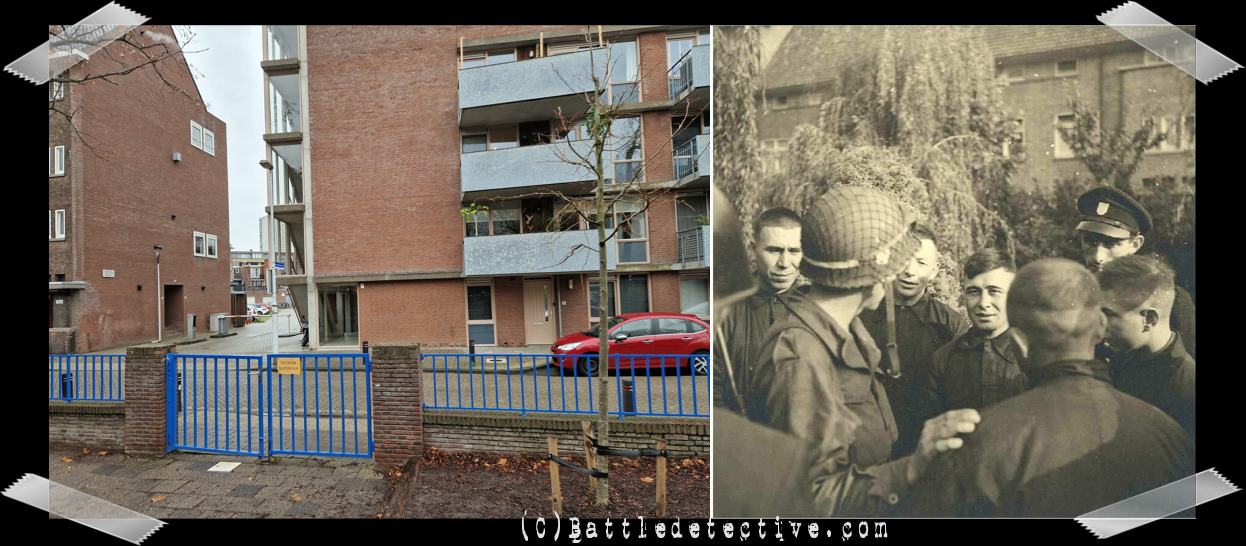 |
Eindhoven, September 18th 1944
Russian soldiers who had been
working as volunteers at the nearby
German Luftwaffe air base are taken
to the school on Don Boscostraat
that was used as a Prisoner of War
cage.
For a background story about these
Russian HiWis see
Case File
# 12 |
.jpg) |
Eindhoven, September 18th 1944
German soldiers taken prisoner
by troops of the American 506th
Parachute Infantry Regiment and
local PAN Resistance fighters at
various locations in the city, are
taken to a school building to be
held captive. Today the building is
still in use as a school for
Montessori method of education. |
.jpg) |
Eindhoven, September 18th 1944
German prisoners of war are
ordered to enter the school building
to be held captive inside.
|
.jpg) |
Eindhoven, September 18th 1944
The POW's are led in the gymnasium
of the school and are see here
sitting on beds. On the left,
a Sergeant First Class of the 506th
Parachute Infantry Regiment walks
by. On the right an Eindhoven Police
officer with black uniform talks to
what seems to be the only SS man in
this group of POW's. |
.jpg) |
Eindhoven, September 18th 1944
The soldier sitting on the table
fourth from the right and looking
away from the camera belongs to an
SS unit judging from the Reichsadler
patch on his left sleeve.
We were granted access to this room
by school staff. For privacy
purposes, people in the "Now-"photo
have been removed digitally.
|
 |
Eindhoven,
September 18th 1944
On Aalster Weg citizens cheer at the
crew of a British Sexton
self-propelled artillery vehicle of
30th Corps moving towards the center
of the city. It is about to pass the
St. Jozef Hospital on the right,
marked with large red crosses
against air raids. |
 |
Eindhoven,
September 18th 1944
Almost the same location as in
the previous comparison but now on
the parallel road with access to the
Hospital. Crowds can be seen behind
the landscaping in the boulevard
as they welcome troops of the
British 30th Corps into their city. |
 |
Eindhoven,
September 18th 1944
On Stratumsedijk, a British film
camera operator of the Army Film and
Photo Unit (AFPU; sits on the hood
of his jeep and seems to be
directing some action that he is
about to document. On the building
in the background the Dutch national
red-white-and-blue flag is already
flying over Eindhoven which has just
been liberated this day. |
 |
Eindhoven,
September 18th 1944
A well camouflaged British
"Staghound" Mk I armored car stacked
with ammunition crates rather than
extra fuel drums, is parked on
Bilderdijklaan. The building in the
background was the German "Wehrmachtskommandantur". |
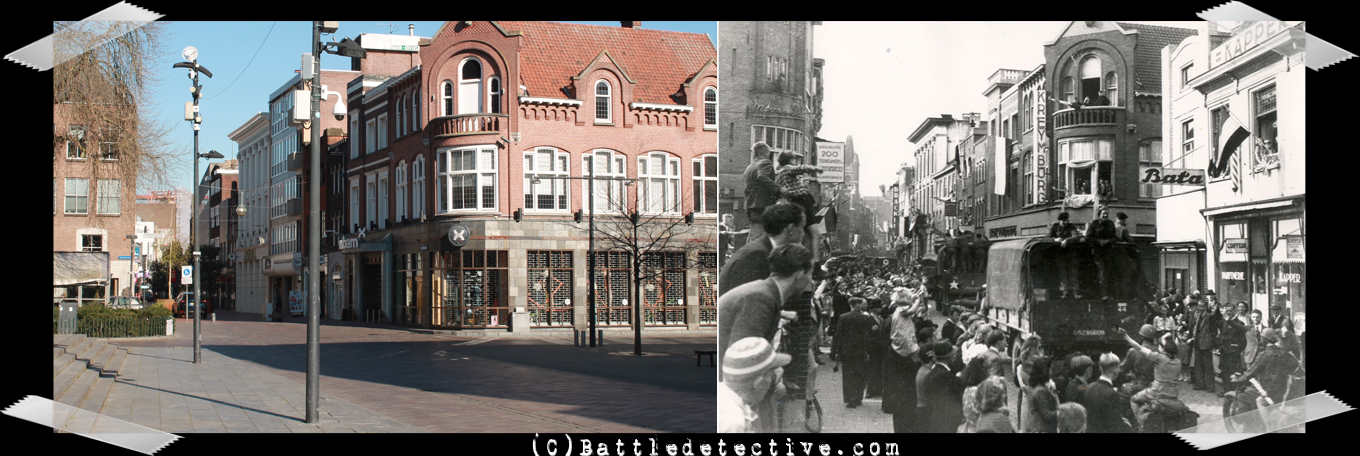 |
Eindhoven,
September 18th 1944
British dispatch riders and
trucks of the Armored Car Regiment
on their way north pass Saint
Catharina Church on Stratumseind
waved on by liberated citizens. |
 |
Eindhoven,
September 18th 1944
British tanks drive north
through the center on the day the
city was liberated. Freed from Nazi
oppression, the Dutch national flags
are flown everywhere. Our "Now-"
photo was not taken from an upstairs
window but by means of a ladder and
a long monopod. |
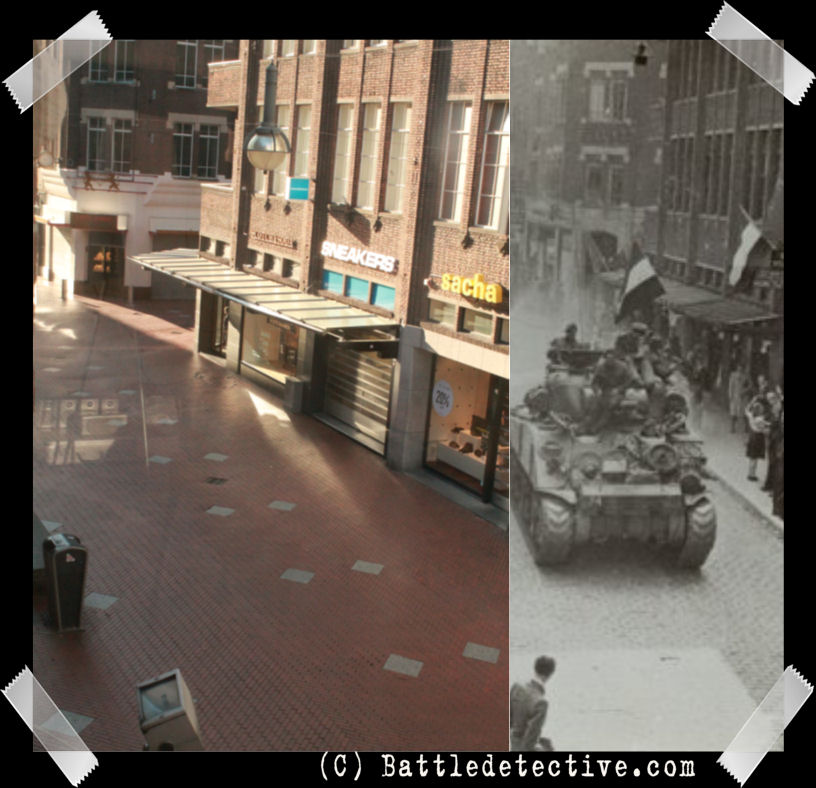
|
Eindhoven,
September 18th 1944
An M4 Sherman tank of the
British 30th Corps rolls north on
Demer in downtown Eindhoven.
"Now-"photo was kindly taken by
staff of the Ziggo customers shop.
Demer is a shopping area for
pedestrians only today. |
 |
Eindhoven,
September 1944
On Geldropseweg, a British
Churchill tank speeds by towards
Geldrop. Because of the
tactical road signs tied to the tree
we assume that this photo is taken
just a day or two after the
liberation of Eindhoven on September
18th 1944 when maintaining the speed
of the advance on the Main Supply
Route was still the highest
priority. |
 |
Son,
September 17th-19th 1944
General Taylor established the 101st
Airborne Division HQ in the catholic
community center Saint Cornelius in
Son from September 17th until the
20th, 1944. Today the building
houses the Vestzak Theater. |
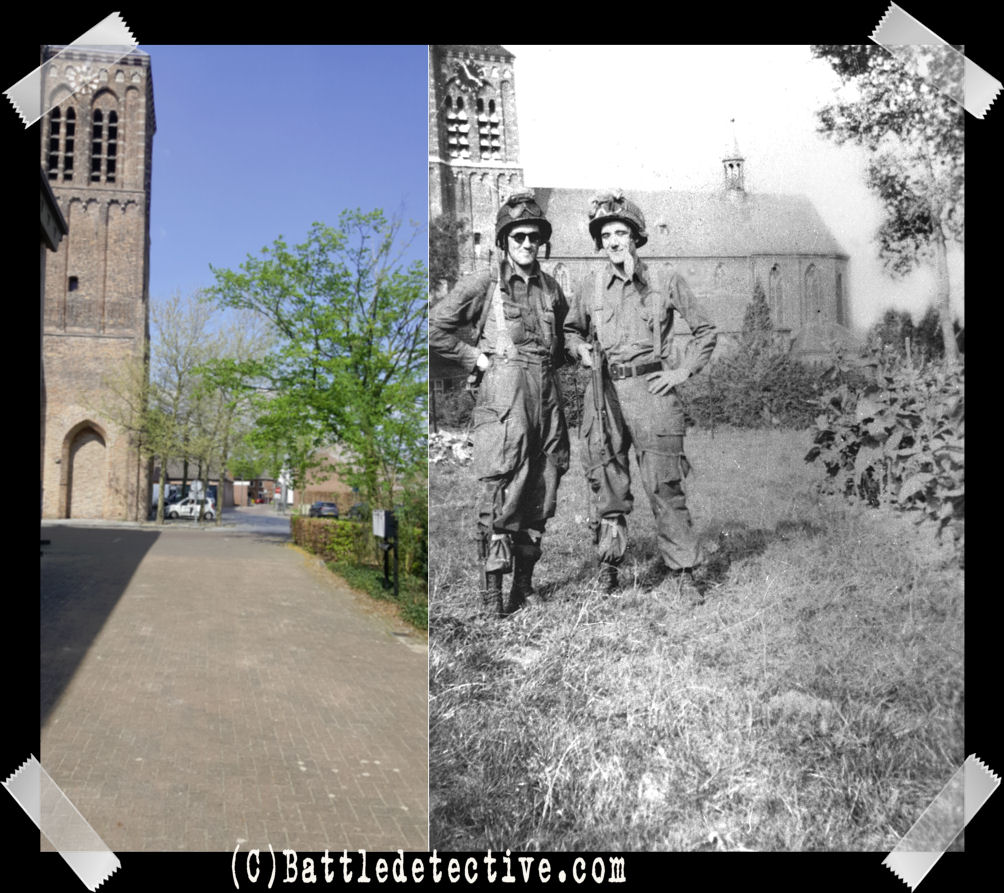 |
Son,
September 17th-19th 1944
Staff Sergeant William E. Kiley
of Division G3 (Operations) and
Military Policeman Private First
Class Paul B. Teator, guard the HQ
situated behind the cameraman. The
church in the background sustained
so much damage during a fire in 1958
that only the tower was left intact.
A new catholic community center on
the field where Kiley and Teator had
their photo taken makes a good
"Now-"comparison difficult.
|
 |
Son,
September 19th 1944
A Sherman tank of the British
XXXth Corps speeds in northern
direction passed Hotel De Zwaan (The
Swan) and the town hall of Son.
Note the air recognition panel on
the engine deck of the tank to
identify it as an Allied vehicle to
fighter planes providing air support
to the operation. |
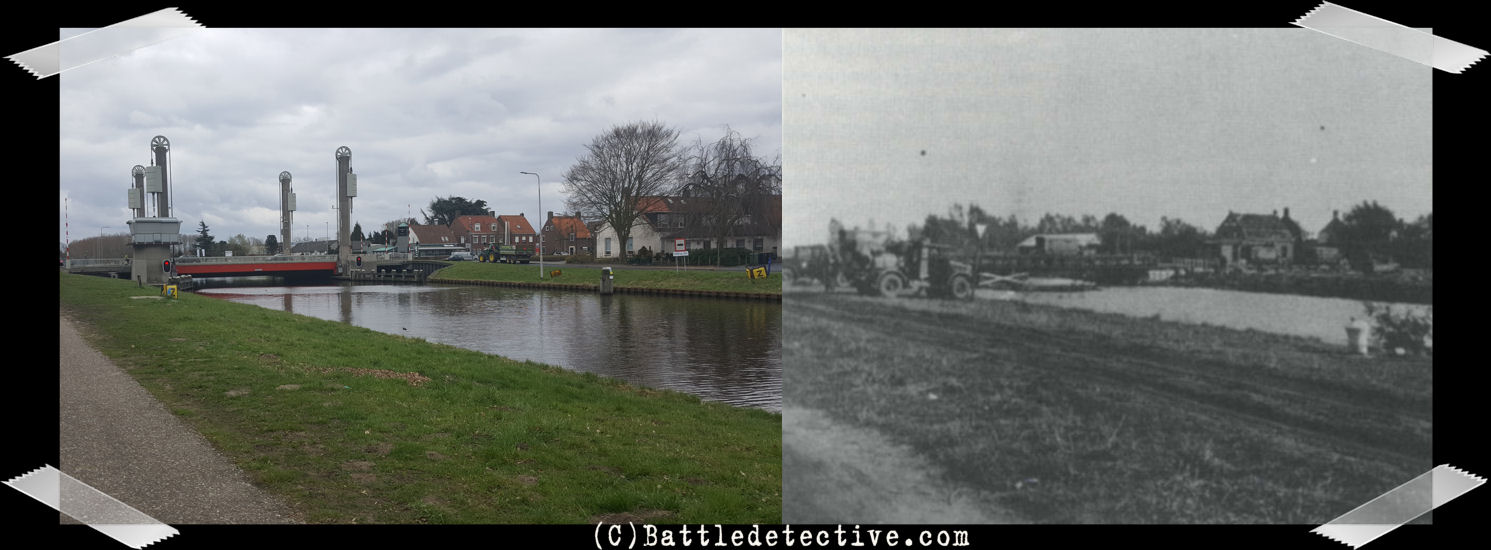 |
Son,
September 19th 1944
British Royal Engineers have built a
Bailey Bridge across Wilhelmina
Canal where on the first day of
Operation Market Garden the road
bridge was blown up by the Germans
seconds before American paratroopers
could capture it. |
 |
Son,
September 20th 1944
The German 107th Panzer brigade
strikes at the corridor from Bourg
Leopold in Belgium towards Arnhem.
Two British trucks are hit in the
distance and medical staff
transporting wounded soldiers in
southern direction take cover is a
roadside ditch.
|
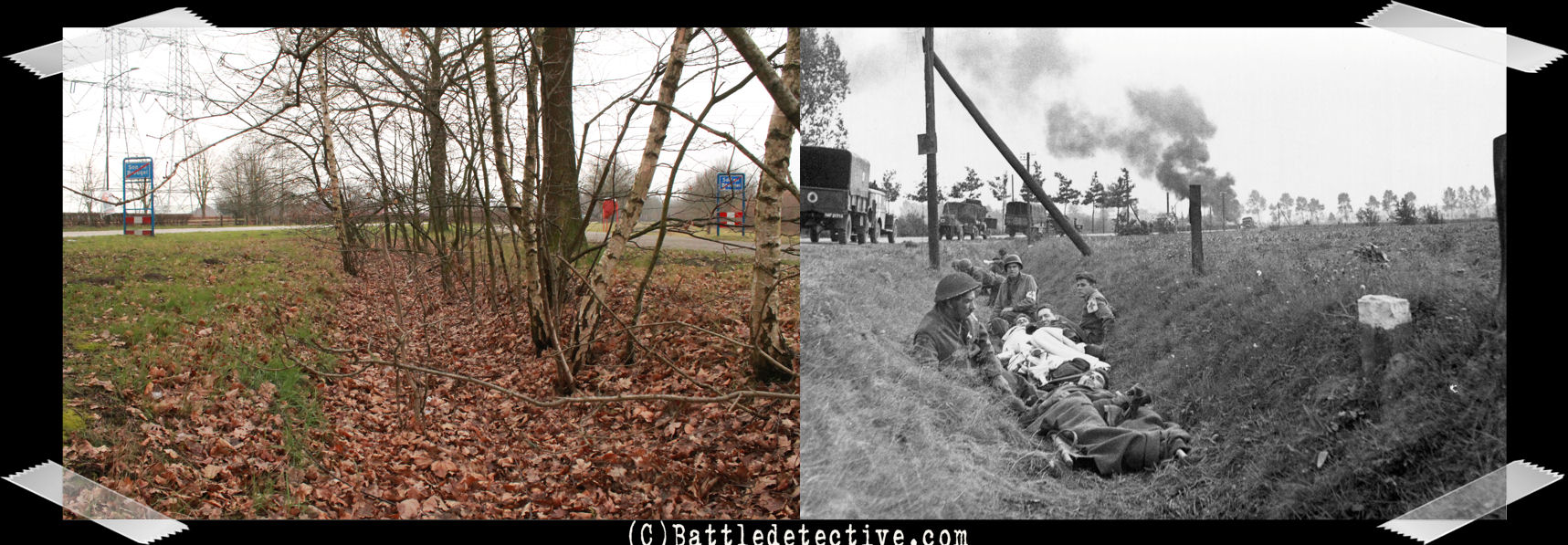 |
Son, September
20th 1944
Among the men taking cover in
the ditch was a British Army Film
and Photo Unit member who took these
photos. The enemy fire is coming
from the East; from the left in the
picture.
|
 |
Son, September
20th 1944
American medics have taken the
wounded on their stretchers from the
ambulances and put them in the
ditch. Note that these are colored
soldiers in the segregated US Army
of the 1940's. These photos are
iconic for what was later named
"Hell's Highway". |
 |
Son, September
20th 1944
A British anti-aircraft unit
with Bofors guns, moves north and
passes the burnt trucks which have
been pushed in the ditch on the east
side of the road. The ditch is full
of Jerry cans with fuel. |
.jpg) |
Mariaheide, September 22nd 1944
Carnage after a German attack
further north along Hell's Highway
close to Veghel. A truck and two
40mm Bofors anti-aircraft guns of
408 Battery Royal Artillery 123rd Bn,
The City of London Light
Anti-Aircraft Regiment, "E" Troop
(named "Ells-Bells" and "Ellzapoppin"
by their crews) are knocked out by
German tanks. |
.jpg) |
Mariaheide, September 22nd 1944
On that day, a German
counter-attack blocked the route of
advance of the British 30th Corps in
their advance towards Arnhem during
Operation "Market Garden". |
.jpg) |
Mariaheide, September 22nd 1944
Two more photos of the damage
done to the Bofors canons and a
truck of "E" Troop, 408 Battery
Royal Artillery 123rd Bn, The City
of London Light Anti-Aircraft
Regiment in Mariaheide in September
1944. |
.jpg) |
Mariaheide, September 22nd 1944
These images show the level railway
crossing in the background and
American paratroopers riding by in
trucks. At least one photo is taken
from the back of these trucks. |
 |
Veghel, September 17th
1944
Two paratroopers of 1st
Battalion, 501st Parachute Infantry
Regiment and a citizen of Veghel
with a drink. The "Then-" photo was
in black and white originally and
has been restored in color. Note the
letter "G" in a lighting bolt on the
life preserver, representing the regimental nickname "Geronimo". The
paratrooper on the left wears an M42
parachutist jacket under his M43
uniform. |
 |
Veghel, September 1944
Paratroopers of "G" Company of
the 327th Glider Infantry Regiment
relax in the back yard of the Van
Dooren family farm in the hamlet of
Dorshout. This unit was the 101st
Airborne Divison's reserve in this
area on September 29th and 30th. |
 |
Veghel, September17th
1944
After having crossed Wilhelmina
Canal on Sluis Straat in Veghel, men
of 2nd Battalion of the 501st
Parachute Infantry Regiment assemble
to enter Veghel. The men in the
foreground have been identified as
members of the Regimental
intelligence section. The photo was
taken by the divisional photographer
Al Krochka. The sign on the left
says: "Veghel For Industry.
Information: Mayor". |
 |
Sint Oedenrode,
September 20th-24th
1944
Henkenshage Castle; Division HQ
after the building in Son was
damaged by artillery fire; see
above. In the foreground in the
"Then-"photo T/4 George E. Koskimaki;
radioman of |
 |
Sint Oedenrode,
September 23rd 1944
Brig. Gen. Gerald J. Higgins,
assistant division commander of the
101st Airborne and Lt.Gen. Miles C.
Dempsey, commander of the British
2nd Army, in the court yard of
Henkenshage Castle. Here, a day
later, Dempsey and lt. Gen. Brian
Horrocks of 30th Corps made the
decision to withdraw the British 1st
Airborne Division from Arnhem. |
 |
Eindhoven, September 1944
Soldiers of the 101st Airborne
Division pose on the corner of
Woenselsestraat and Frankrijkstraat.
They came into Eindhoven in the
division's "sea-borne tail" and not
by parachute or glider. |
 |
Elst, October 1944
A comparison often reenacted by
battlefield tourists.
Captain Richard D. Winters,
commanding "Easy" Company of the
506th Parachute Infantry Regiment (a
unit made famous by Stephen Ambrose
's book "Band of Brothers) poses in
front of the gateway into the "Landgoed
Schoonderlogt" estate. During the
battle of the Betuwe region, known
to the American soldiers as "The
Island",' this farm served as
Regimental Headquarters of the
506th. |
 |
Arnhem,
September 17th 1944
Firefighters in action on
Bakkerstraat after the RAF targeted
military installations in the area,
prior to the airborne landings of
“Market Garden”. In Arnhem several
Dutch Army barracks, occupied by the
Germans, were hit but there was
collateral damage as well. |
 |
Renkum, September
17th 1944
Still from a film shot by Army Film
and Photograph Unit cameraman Mike
Lewis on LZ/DZ “X”. “Now” photo
taken from the modern day golf
course with the trees of Klein
Amerikaweg in the background. |
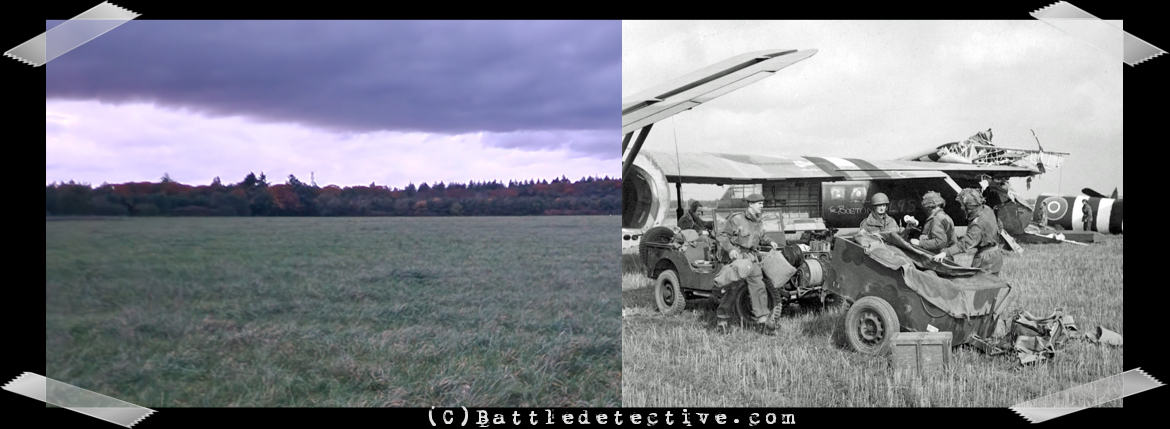 |
Wolfheze,
September 17th 1944
LTCOL Thompson (2nd left), CO of 1st
Airlanding Light Regiment, helping
to unload HQ Royal Artillery
equipment from a damaged Horsa
glider on LZ “Z”. The Horsa had its
wing-tip torn off when it collided
with the neighboring glider moments
before landing; these were the first
two gliders to land at Arnhem. |
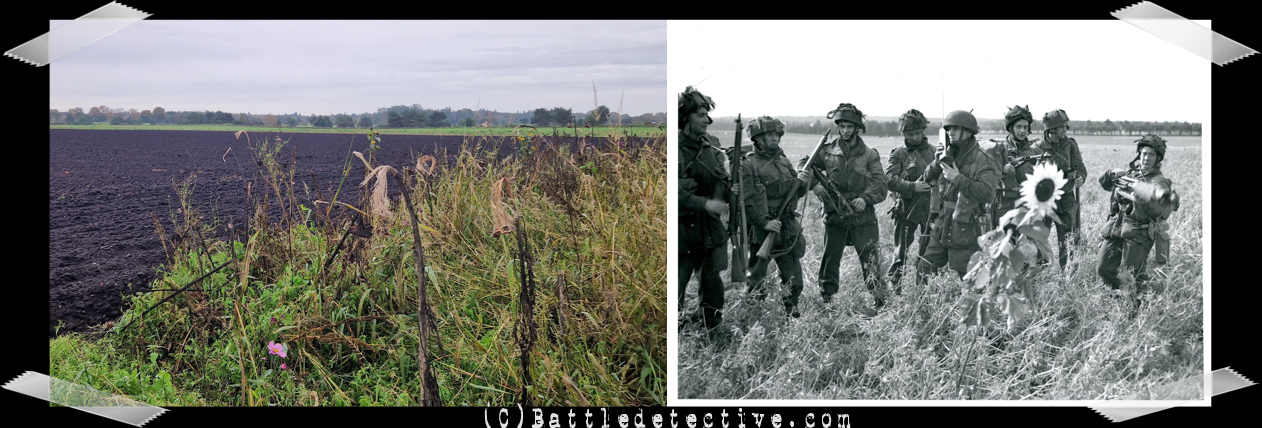 |
Renkum, September
17th 1944
Paratroopers of “C” (Lines) Section
of Divisional Signals are assembling
on Drop Zone “X” near Telefoonweg.
The soldier on the right is
just about to lift a heavy Vickers
.303 machinegun on his shouldersOn
the right rear background Klein
Amerikaweg can be seen. |
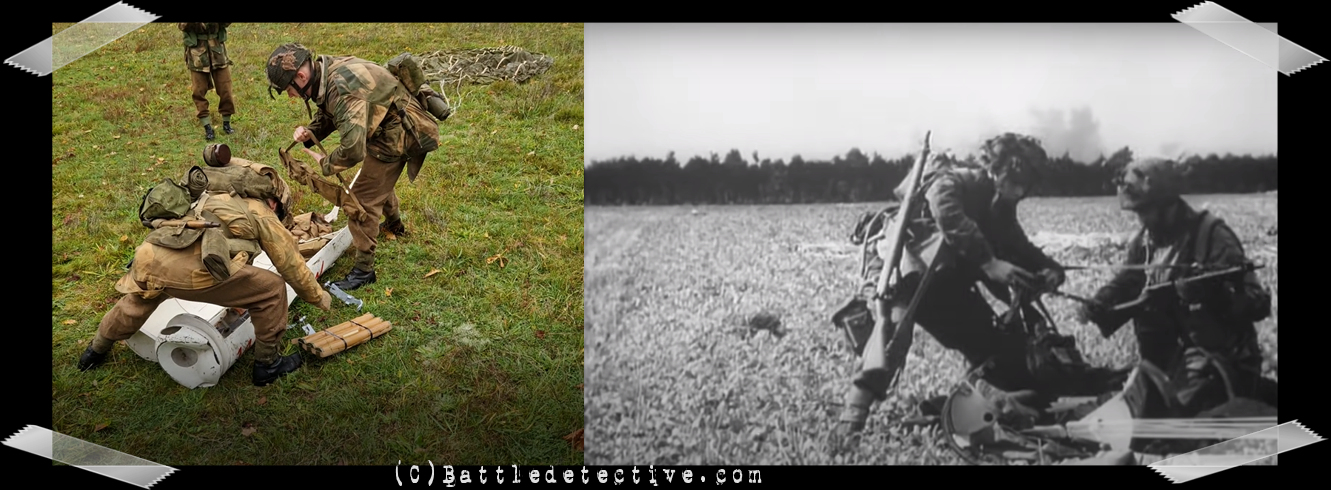 |
Renkum,
September 17th 1944
Still from a film shot by Army Film
and Photograph Unit cameraman Mike
Lewis on LZ/DZ “X”. Two paras from
1st Parachute Brigade remove weapons
from a CLE Delivery container. “Now”
photo on almost the same location
(with Klein Amerikaweg to the left
just outside the shot) and the scene
reenacted by men of
War Department. |
 |
Wolfheze,
September 17th 1944
German prisoners of war being
escorted for interrogation by
Sergeant Steve Smith of Division HQ.
On the right mr. Van Sluys looks on
wearing his Sunday best as he has a
day off from work at the Wolfheze
lunatic asylum. This dirt track is
at the rear of the asylum. Note the
barrel of a British 17-pounder
anti-tank gun at left. |
 |
Wolfheze,
September 17th 1944
On Duitsekampweg Trooper Fred Brawn,
C troop Recce Sqdr. Mans a Bren Gun
in the background. In the foreground
Troopers Jimmy Cooke and Ray Evans
of HQ Troop Recce Sqdr. Man a PIAT
anti-tank weapon. |
 |
Wolfheze,
September 17th 1944.
Infantry of 1st Bn, the Parachute
Regiment take position in a bomb crater close to the
level railway crossing in Wolfheze
which is located behind the
cameraman. The men are covering
Wolfhezerweg near the junction with
Johannahoeveweg. Note similar water
piping exposed in our "Now-photo
taken on 2JUN2025.
Earlier it was assumed that this
location was further north. |
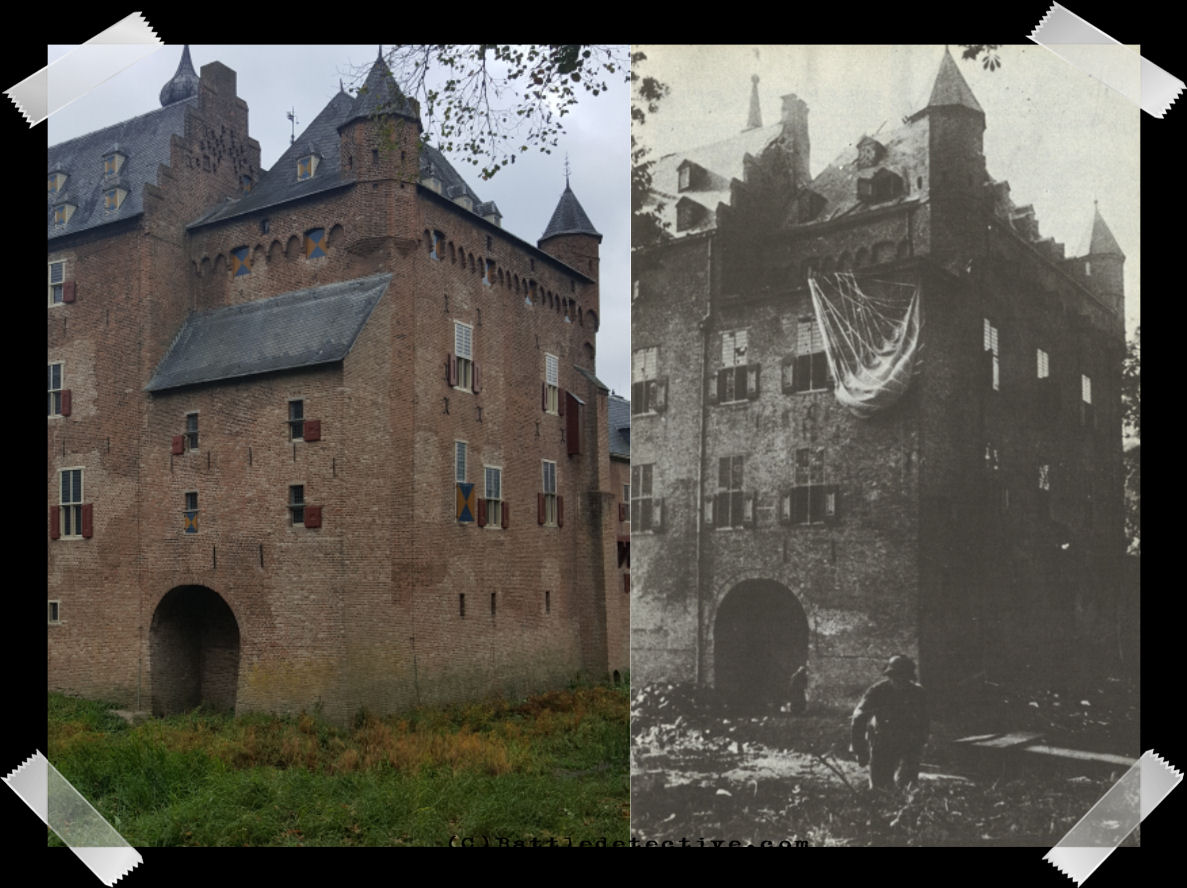 |
Doorwerth Castle,
September 18th 1944
A British resupply container has
landed on the castle roof and German
soldiers rush to it, to retrieve its
contents. |
 |
Oosterbeek,
September 17th 1944
British AFPU photo of Gefreiter
(corporal) Jozef Willeke who drove
the Citroën staff car of general
Kussin straight into the route of
advance of the British No.5 Platoon,
"B" Company, 3rd Parachute Battalion
on the first day of Operation
"Market Garden".
More details on the incident can be
found
here. |
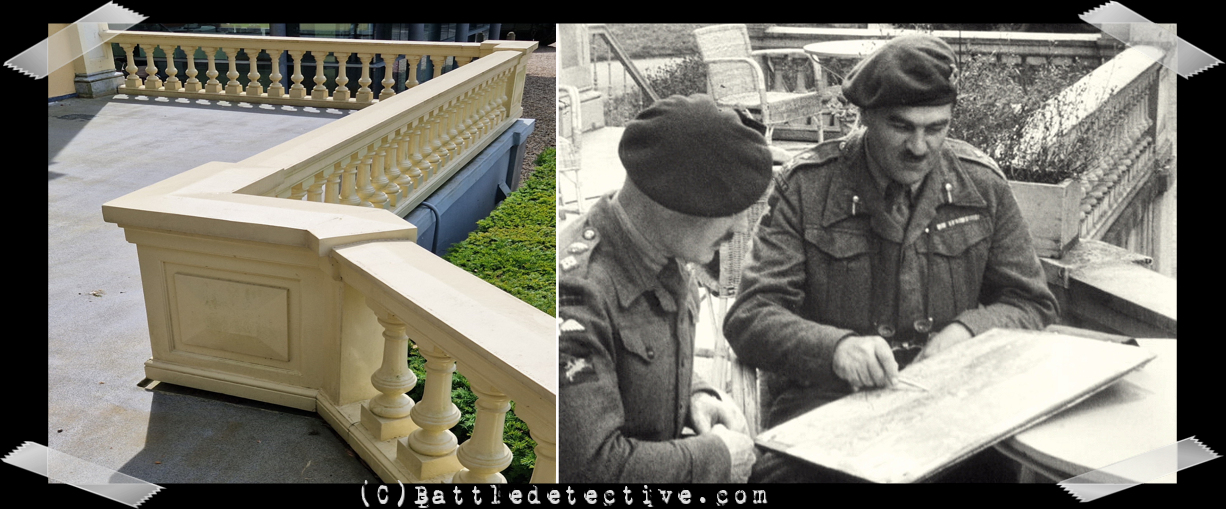 |
Oosterbeek,
September 19th 1944
On the front terrace of the
Hartenstein hotel Major-General Roy
E. Urquhart discusses the positions
of the various units of the 1st
British Airborne Division and those
of the opposing German forces with
his Chief of Staff,
Lieutenant-Colonel Charles B.
Mackenzie. . |
 |
Arnhem, September
1944 Medical staff and Red Cross
volunteers talk to the driver of one
of the ambulances and passenger cars
bringing military casualties from
both the German and British side to
the hospital. |
.jpg) |
Arnhem, September
19th 1944
German infantry pull a cart or
artillery piece off the ferry ramp,
East bank of the Pannerdensch Kanaal.
With the northern approach of Arnhem
bridge in British hands, the
elements of the German 2nd SS Panzer
Korps north of the river Rhine could
only reach the area south of Arnhem
by ferry sites at Huissen and
Pannerden. |
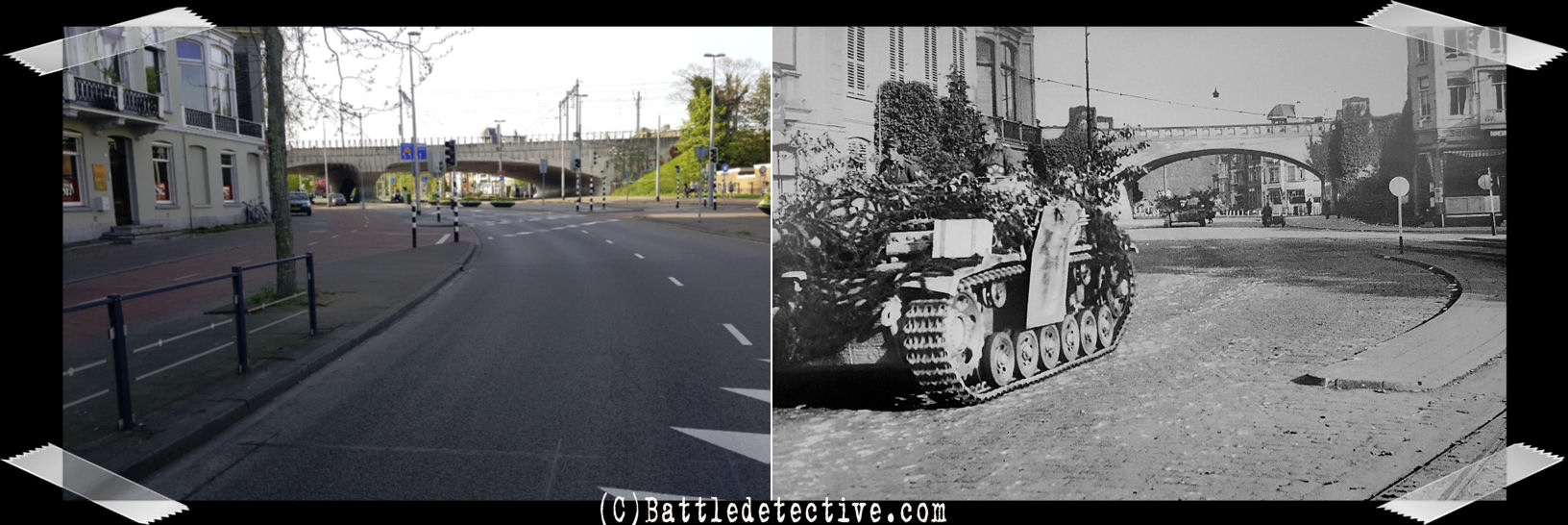 |
Arnhem, September
19th 1944
The following 4 photos were
taken by German "Kriegsberichter"
Jacobsen and show the arrival of 10
StuGIII self-propelled guns in
Arnhem and their advance eastward to
the Oosterbeek perimeter. This is on
Velper Plein. |
 |
Arnhem, September
19th 1944
Self-propelled guns of the
Sturmgeschütz Abteilung 280 drive
east from Velperplein on
Willemsplein. Half of the unit
advanced to Oosterbeek via
Utrechtseweg (the high road) and the
other half via Onderlangs (the low
road). |
 |
Arnhem, September
19th 1944
SS grenadier infantry follow the
StuG's while embedded Luftwaffe war
correspondent Erich Wenzel (with
riding boots and officer's cap)
snaps the previous "Then-"photo. |
 |
Arnhem, September
19th 1944
Onderlangs in Arnhem. British
paratroopers surrender en masse to
SS troops with self-propelled guns
in September 1944. Note para,
apparently killed in action while
trying to jump a garden fence but
got stuck on it with his equipment. |
 |
Arnhem, September
19th 1944
A German Army "Kriegsberichter"
photographed a British casualty on
Onderlangs in close up. This
paratrooper was killed while getting
stuck on a garden fence with his
equipment. |
.jpg) |
Arnhem, September 19th 1944
On Utrechtseweg East of the Museum
SS grenadiers accompany a
Sturmgeschütz self-propelled gun.
Note soldier in foreground with a
captured British Mark V Sten Gun. |
 |
Arnhem, September 19th 1944
British airborne troops of the
South Staffordshire Regiment
surrender to SS-troops. Note shell
holes in the building in the center
of the photo and the German 20
millimeter Flak 48 anti-aircraft gun
in the foreground which was
accidentally crushed by a
Sturmgeschütz III self-propelled gun
of Kampfgruppe (Battle Group)
Möller. |
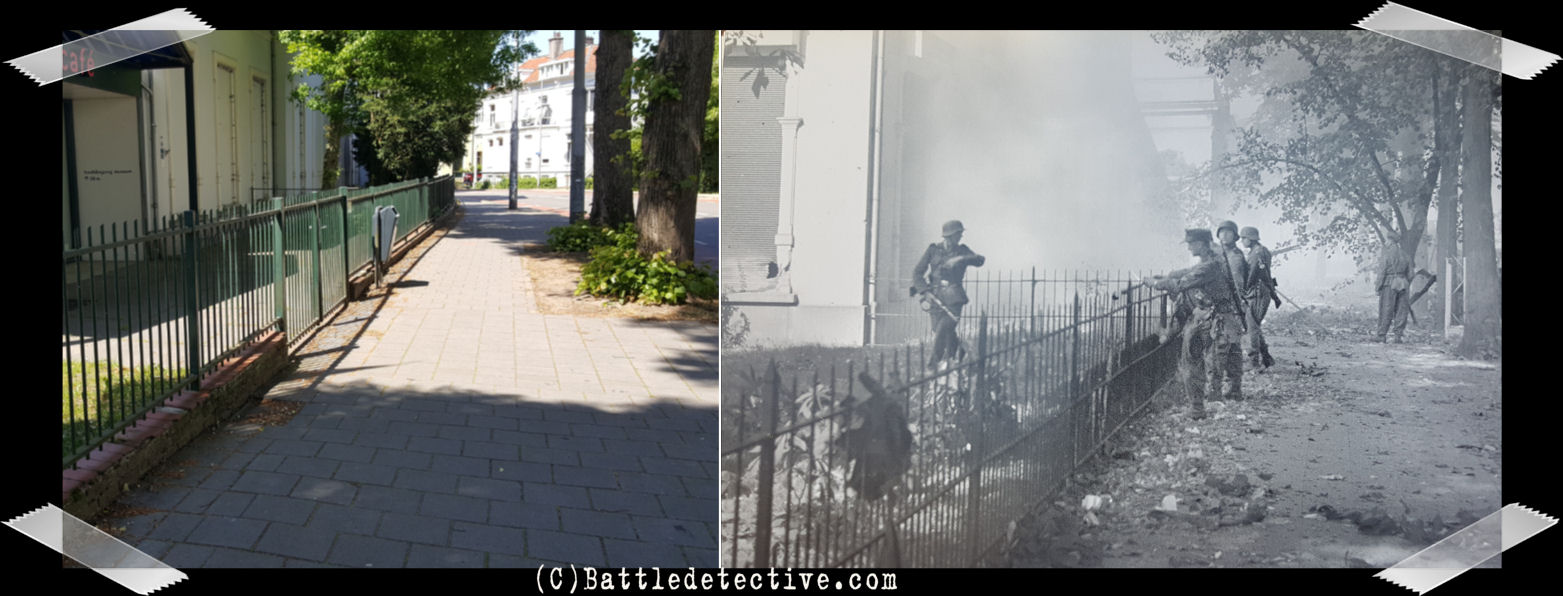 |
Arnhem, September 19th 1944
Grenadiers of an SS unit cross the
fence of the Arnhem Museum on
Utrechtsestraat. The building at that
time was defended by British troops
from the South Staffordshire
Regiment. |
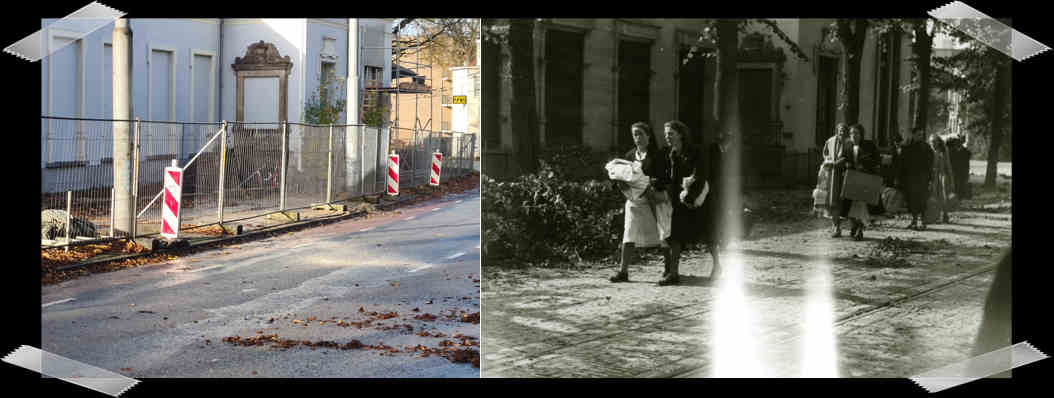 |
Arnhem, September 19th 1944
Medical staff and walking patients
are evacuated from the nearby
Elisabeths Gasthuis hospital and are
seen here at the Arnhem Museum.
Note the nurse at left carrying a
bundle which may contain a baby. |
 |
Arnhem, September 19th 1944
British Airborne troops who have
just surrendered, take a moment of
rest on the steps of a house on
Utrechtsestraat right across the
street from the museum. Today this
house, which was defended by No. 9
Platoon of “A” Company, the South
Staffordshire Regiment has number
70. The arm rail on the right has
been altered after the battle to
make room for a larger door.
|
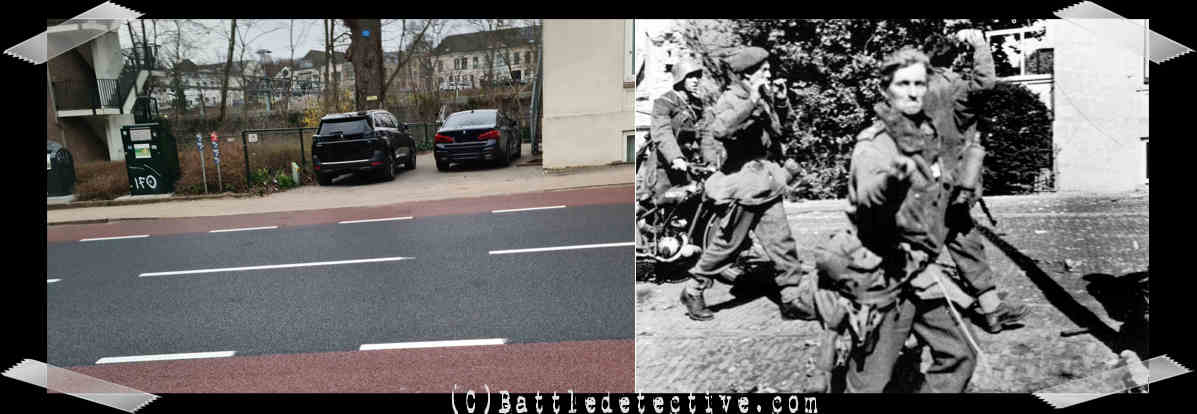 |
Arnhem, September 19th 1944
Lieutenant Jack Reynolds,
commander of the Mortar Platoon of
the 2nd Battalion South
Staffordshire Regiment and his men
have just surrendered. Once he
spotted a German “Kriegsberichter”
taking his photo he made a
two-fingered gesture. |
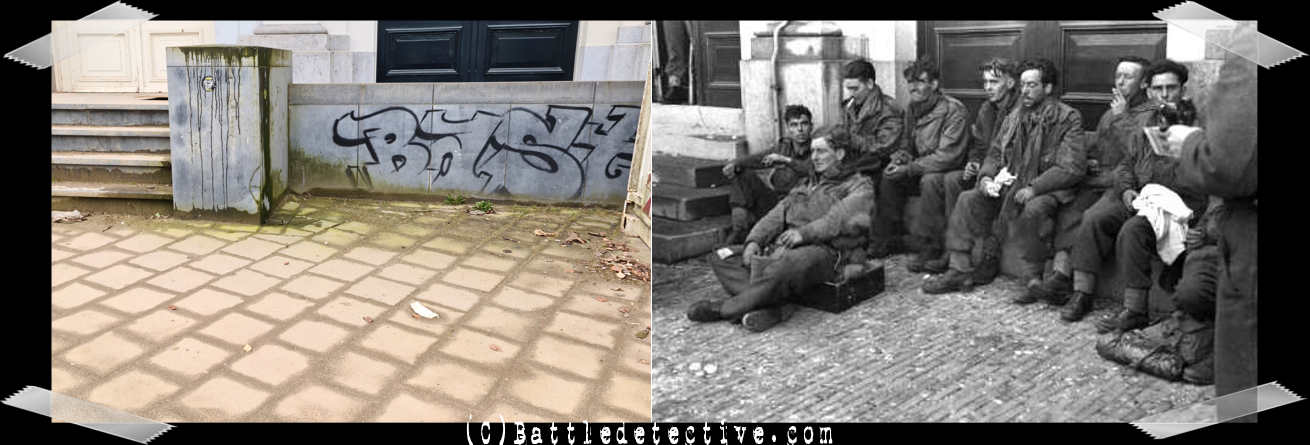 |
Arnhem, September 19th 1944
British soldiers of 2nd
Battalion The South Staffordshire
Regiment rest on the steps of the
Museum shortly after they were taken
prisoner. Sitting in a wooden box on
the left is Lieutenant Jack
Reynolds, commander of the Mortar
Platoon.
|
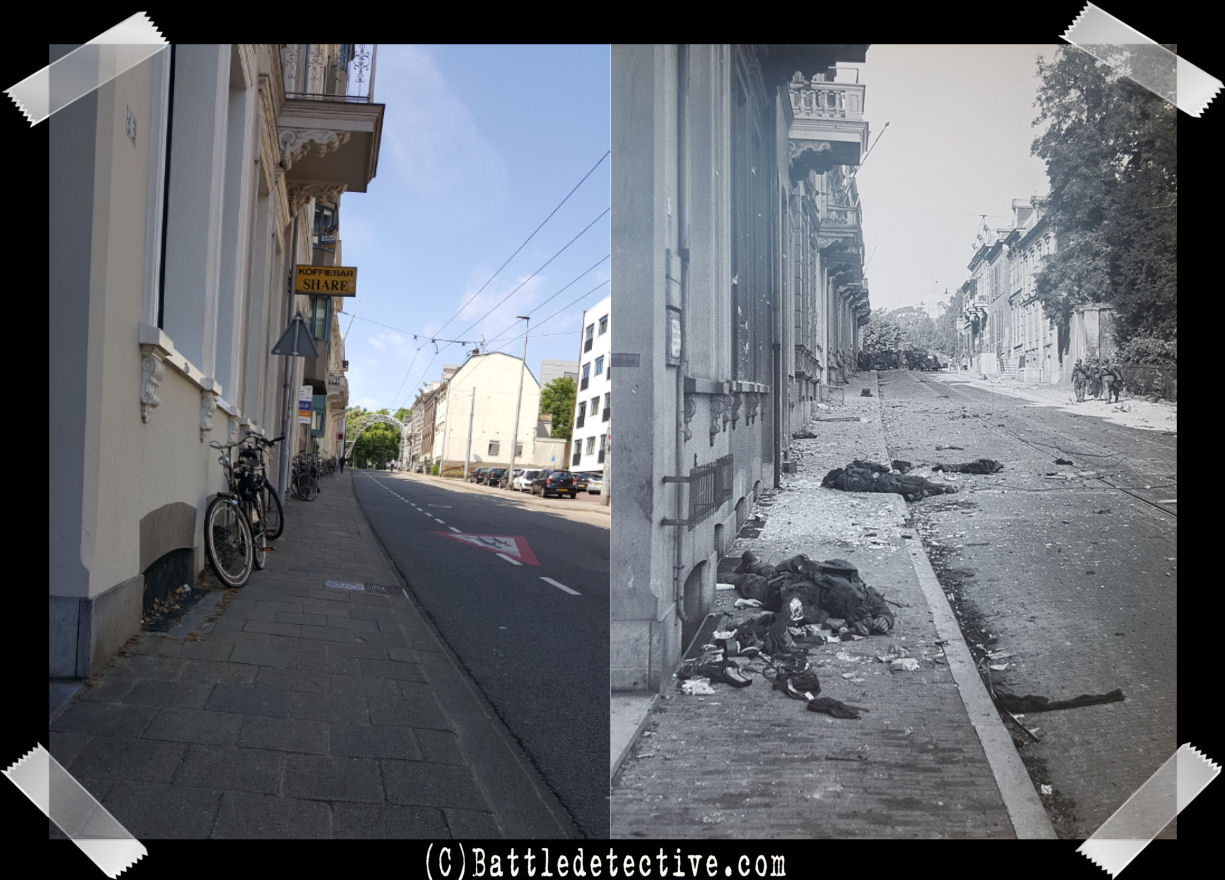 |
Arnhem, September 19th 1944
SS-men move east on Utrechtsestraat and
have passed the bodies of PVT Norman
Shipley and Lance CPL William Loney
of "C" Company, 2nd Parachute
Battalion. Both were killed two days
earlier, acting as scouts when their
battalion moved towards Arnhem
bridge.
|
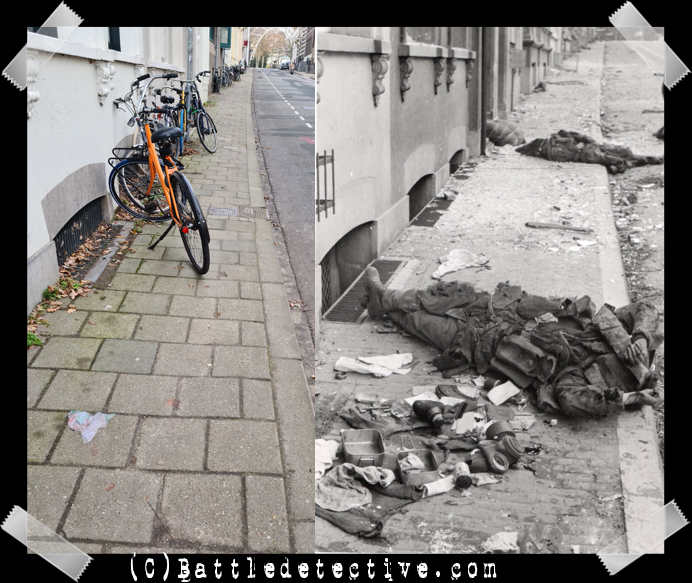 |
Arnhem, September 19th 1944
The bodies of PVT Norman
Shipley and Lance CPL William Loney
on the sidewalk of Utrechtsestraat
photographed in more detail. |
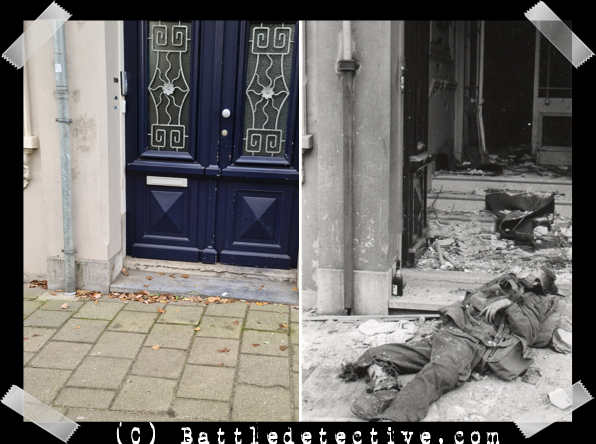 |
Arnhem, September 19th 1944
The gruesome sight of one of the
casualties of "C" Company, 2nd
Parachute Battalion at the doorway
of a house on Utrechtsestraat. |
 |
Arnhem, September 19th 1944
On the corner of Johan de
Wittlaan and Boulevard Heuvelink
Luftwaffe Kriegsberichter
Jacobsen photographs a 2cm Flak 38
gun crew sent from Deelen air base
to support the 9th SS Panzer
Division to retake Arnhem bridge
which is just a few streets away in
the direction where the gun is
pointing. |
 |
Arnhem, September 19th 1944
Jacobson took a picture of his
colleague Erich Wenzel seen here
sipping from a bottle of wine. De
Wittlaan has hardly changed since
1944 but the tram rails in the
street on the left are gone now. |
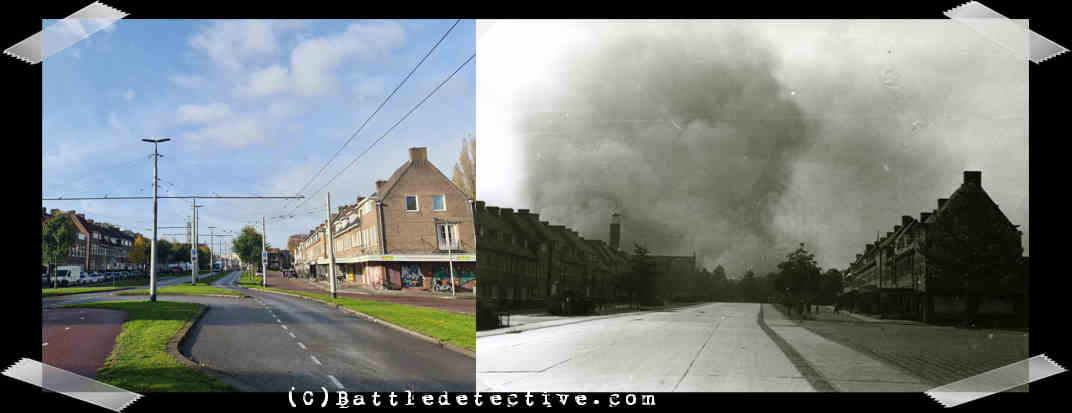 |
Arnhem, September 19th 1944
Smoke from burning buildings at
the Arnhem road bridge rises up
behind houses on De Wittlaan. At
this time the resistance of British
troops at the northern bridge ramp
has almost come to an end. |
 |
Arnhem, September 19th 1944
Luftwaffe personnel is digging a
position for their 20 millimeter
anti-aircraft gun Walstraat.
The gun crew’s field of fire down
the street is in the direction of
the Arnhem road bridge leading us to
believe they were deployed in an
anti-personnel role. |
 |
Arnhem, September 19th 1944
British paratroopers of 10th
Parachute Battalion appear to have
been ambushed as they had reached a
distance marker on Amsterdamseweg.
The effect of German 20mm cannon
fire can be seen on the marker and
the bodies. |
.jpg) |
Oosterbeek, September 20th 1944
Kriegsberichter Höppner photographed
the actions of a Flak30 20
millimeter anti-aircraft gun from
Flak-Brigade Swoboda on the grounds
of the "De Leeren Doedel" inn on the
corner of Dreyense Weg and
Amsterdamse Weg; the latter running
underneath the flight path of Royal
Air Force Stirling bombers and
Dakota cargo planes resupplying the
Airborne forces in the Arnhem area. |
.jpg) |
Oosterbeek, September 20th 1944
The crew has traversed its gun
and fires at a lone Dakota flying
towards LZ "L". Four days later the
nearby inn was raided and destroyed
by Allied bombers because of the
flak coming from this location. |
.jpg) |
Oosterbeek,September 25th 1944
A German officer, in long coat on
the right, directs a group of
grenadiers on Weverstraat in the
direction of the British perimeter
around the Hartenstein hotel.
|
 |
Oosterbeek,September 25th 1944
German grenadiers take cover behind
a Sturmgeschütz self-propelled gun
which fires down Weverstraat on
houses still defended by British
paratroopers.
"Then-"photo by German Propaganda-Kompanie
"Kriegsberichter" Leutnant
Seuffert who arrived in the
Oosterbeek perimeter during the
final days of the battle.
|
.jpg) |
Oosterbeek,September 25th 1944
The same group of grenadiers is now
ordered to move forward by another
officer. They advance behind the
cover of a StuG self-propelled gun
(note empty shells on the road in
the foreground) into Van Eeghenweg. |
.jpg) |
Arnhem, September 21st 1944
Photo taken by German Army "Kriegsberichter"
Seeger, near the Musis Sacrum
building right after the Battle of
Arnhem. Two British Prisoners of War
and their Kriegsmarine guards have
been picked up by an SS Grenadier
driving a captured British airborne
jeep |
.jpg) |
Arnhem, September 21st 1944
The jeep, which the Germans
called "Willy's Kleinwagen".
belonged to the Air Landing Light
Regiment (Royal Artillery) and is
likely to have towed an M1A1 75
millimeter Pack Howitzer. |
.jpg) |
Arnhem, September 21st 1944
"Kriegberichter" Seeger
walked around the jeep and
photographed its occupants with a
local cigar shop in the background.
The driver pushed a potato masher
stick grenade into the rifle clasp
in front of him and has a captured
British Mk V Sten gun on the hood of
the jeep. |
.jpg) |
Arnhem, September 21st 1944
On the cigar shop's wall a
letter "F" for "Funker"
(signalman) is painted indicating
the nearest German radio-equipped
command post. |
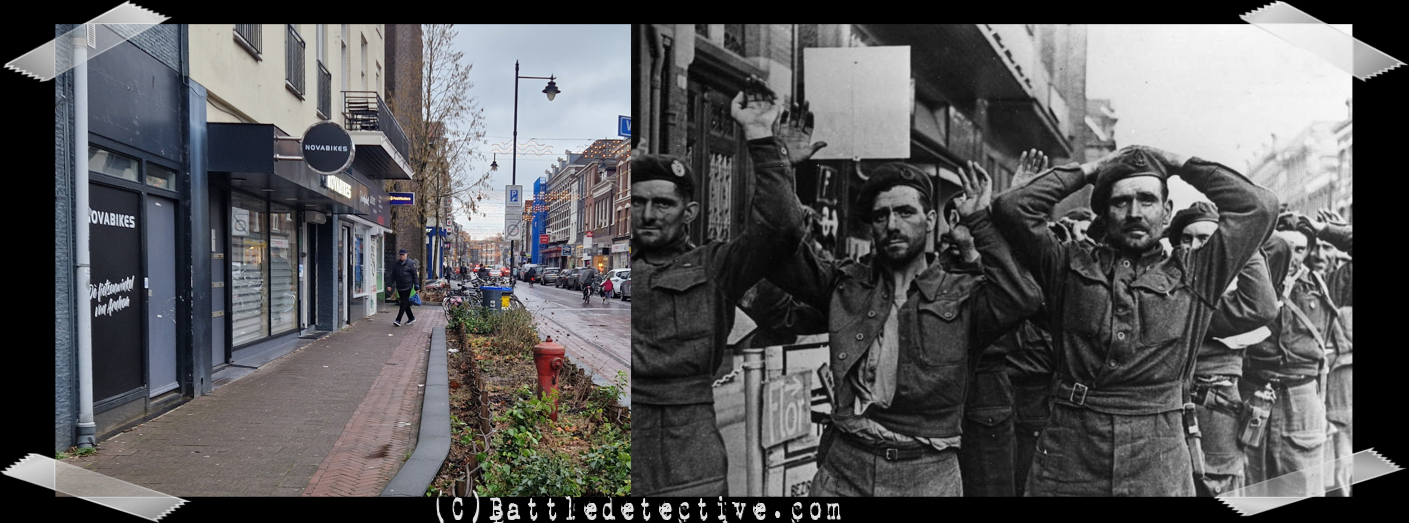 |
Arnhem, September 21st 1944
Almost at the same location
Kriegsberichter Höppner took
this photo of surrendering British
defenders of Arnhem bridge. The
unwounded POW's were marched off to
Velp, and from there to POW camps in
Germany in lorries. The wounded
POW's were taken to the St
Elisabeths or Municipal Hospitals or
to the German hospital in the Willem
III Barracks in Apeldoorn; See
Battle
Study # 33. |
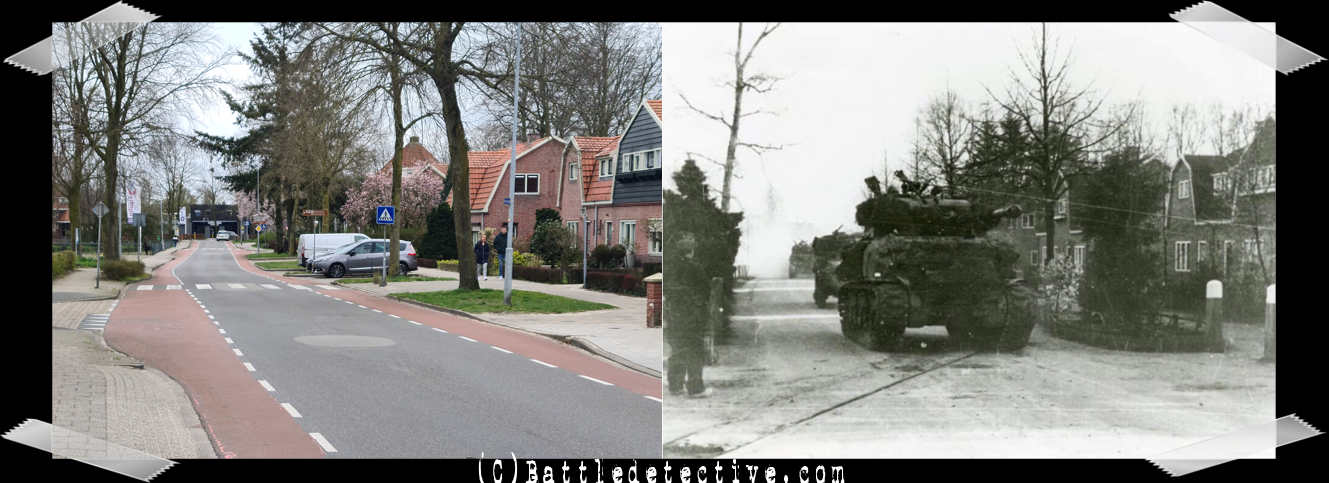 |
Aalten, March 30th 1945
After advancing from positions in
the area of Bocholt in Germany,
Grenadier and Irish Guards captured
Aalten. Here an M4 Sherman "Firefly"
tank is entering the town on
Poltstraat at the junction of
today's Tramstraat. |
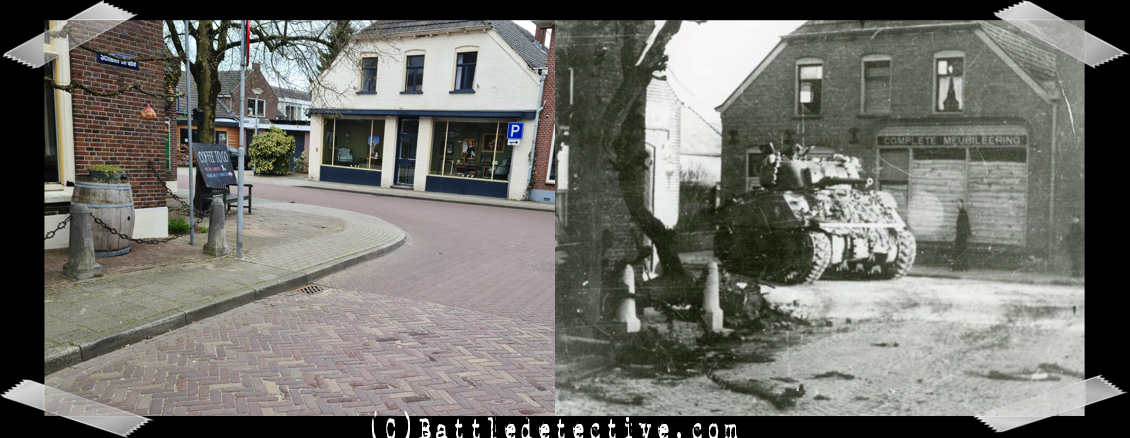 |
Aalten, March 30th 1945
a British M4 Sherman tank rushed
down Haartsestraat and is seen here
at the junction with Prinsenstraat
and the Schiller café on the left
corner. |
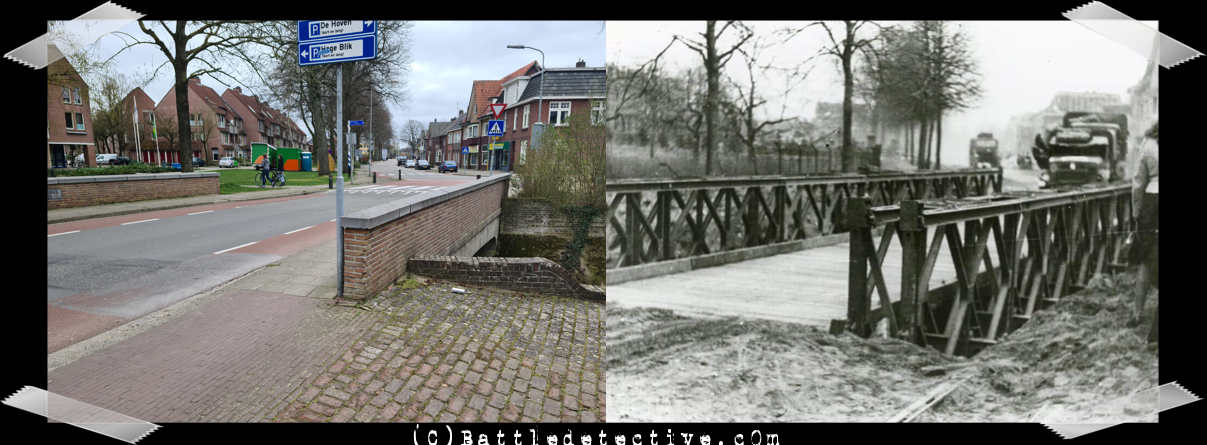 |
Aalten, March 30th 1945
British trucks enter the town on
Dijkstraat across a Bailey bridge
built across the river Schlinge.
German troops had demolished most
bridges in Aalten earlier that
month. "Now-"photo shows the stone
bridge which was rebuilt in 1949. |
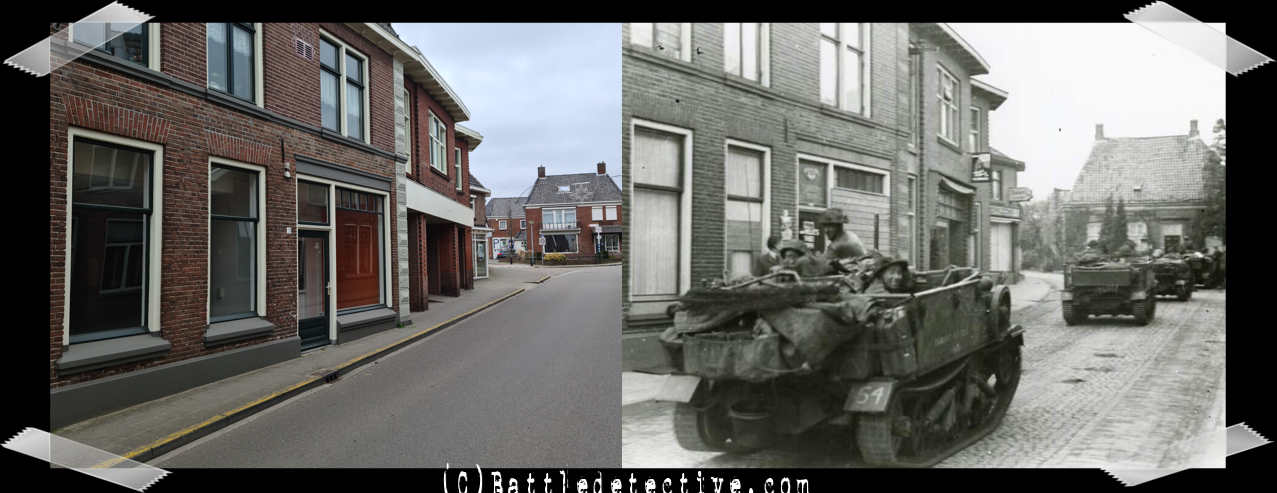 |
Aalten, March 30th 1945
British Bren Carriers rush down
Lichtenvoordsestraatweg to the
center of town. Note boarded up
shops; most likely because of damage
done during the March 24th Allied
bombing raid on factories in Aalten. |
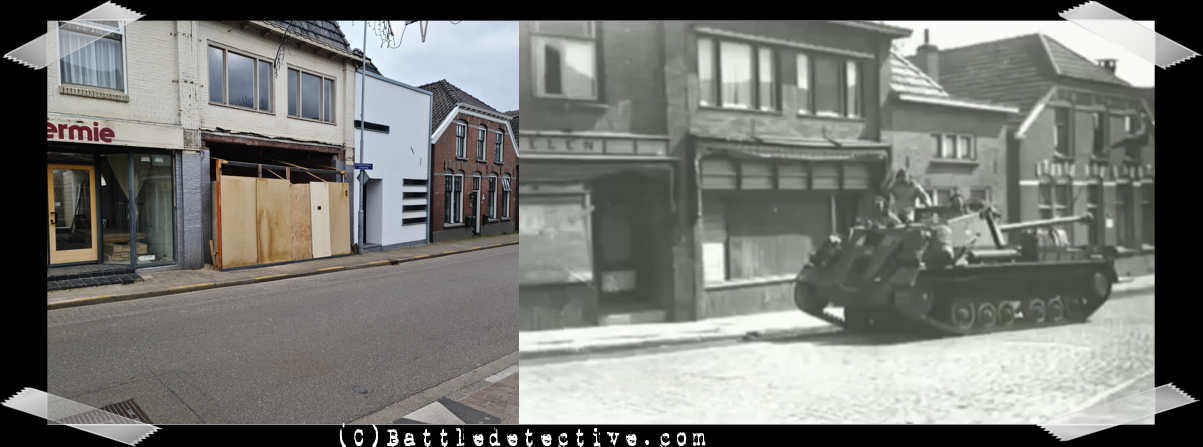 |
Aalten, March 30th 1945
Seen from just across the street
a British Self Propelled 17pdr,
Valentine, Mk I, Archer drives down
Lichtenvoordsestraatweg. |
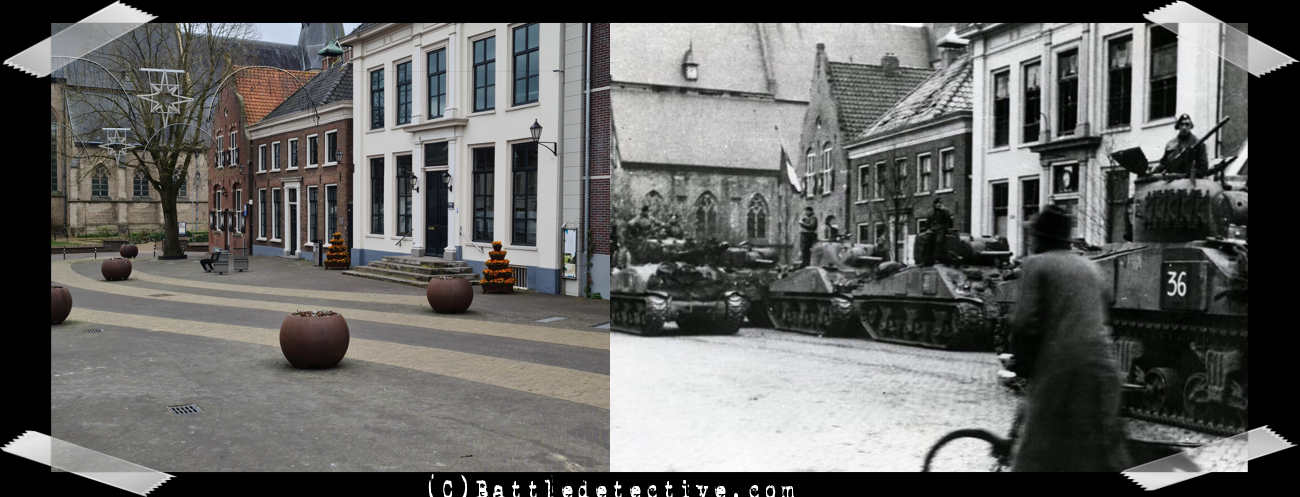 |
Aalten, March 30th 1945
Sherman tanks of the British
30th Corps have reached Markt; the
central square of the town. |
 |
Aalten, March 30th 1945
Armed local Dutch resistance
fighters escort German soldiers
taken Prisoner of War away from
Markt. |
.jpg) |
Zevenaar, April 3rd 1945
A German "Sprengkommando"
ohas detonated an explosive charge
under the crossroads of
Grietsestraat and Arnhemseweg
causing a large hole on what is now
the Raadhuisplein square. On
the left we see a Canadian soldier
inspecting the damage. |
.jpg) |
Zevenaar, April 3rd 1945
Local workmen take a break from
work to pose in at the crater in the
crossroads of Grietsestraat and
Arnhemseweg in the center of
Zevenaar. It is the
construction crew's job to repair
the roadway as this is on the route
to Arnhem coming in from the East
(Germany). |
.jpg) |
Zevenaar, April 3rd 1945
German "Sprengkommando"
engineers demolished the crossroads
in an attempt to block the Canadian
advance into the Netherlands. |
.jpg) |
Zevenaar, April 3rd 1945
The intent was to create a road
block in the route of advance of the
Canadian 1st Army entering the East
of the Netherlands from Germany in
the direction of Arnhem. |
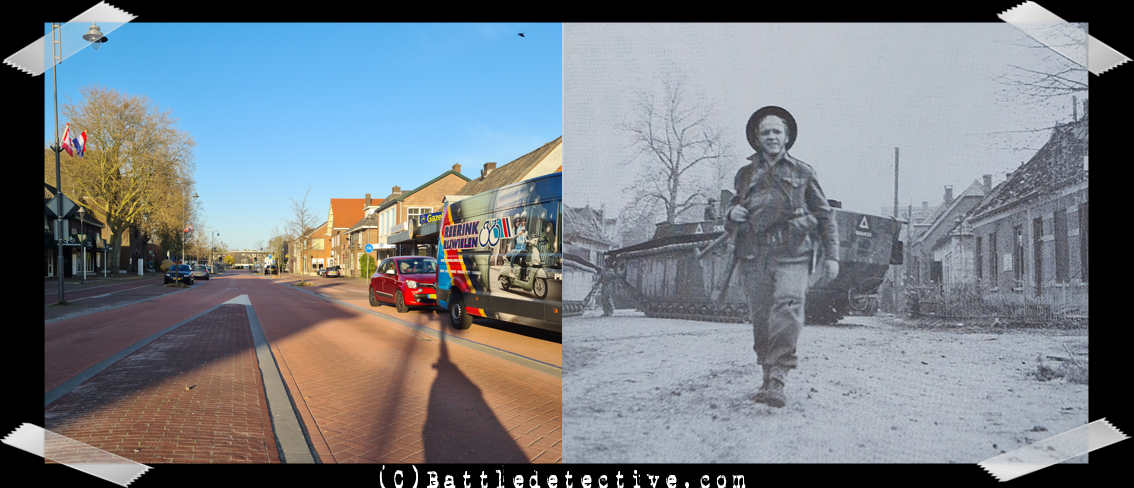 |
Westervoort, April 13th 1945
"Buffalo" Armored Tracked
Vehicles stand ready on
Hamersestraat as an infantryman
marches in the direction of the
railway overpass. On the left is the
building of Christian Interests "Rohoboth".
Note Dutch red-white-and-blue, Maple
Leaf and Union Jack flags flying on
the lamp post in the "Now-"photo
commemorating the liberation of
Westervoort 76 years before this
photo was taken. |
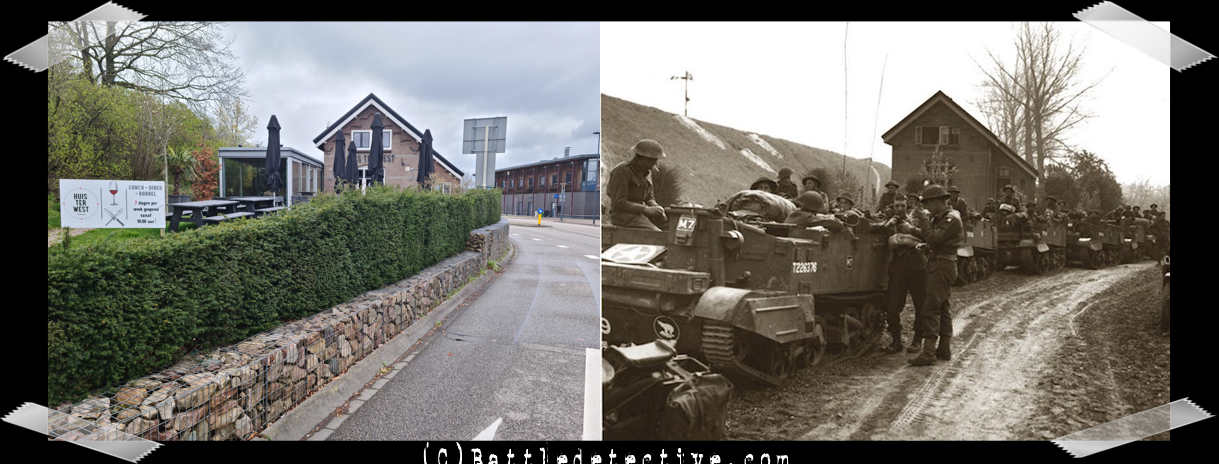 |
Westervoort, April 13th 1945
Mortar carriers of the 2nd
Battalion, Essex Regiment, 56th
Brigade, 49th British Infantry
Division (West Riding) wait for
orders to cross the river IJssel and
advance towards Arnhem. Note
the divisional logo of the “Polar
Bears” on the carrier in the
foreground. |
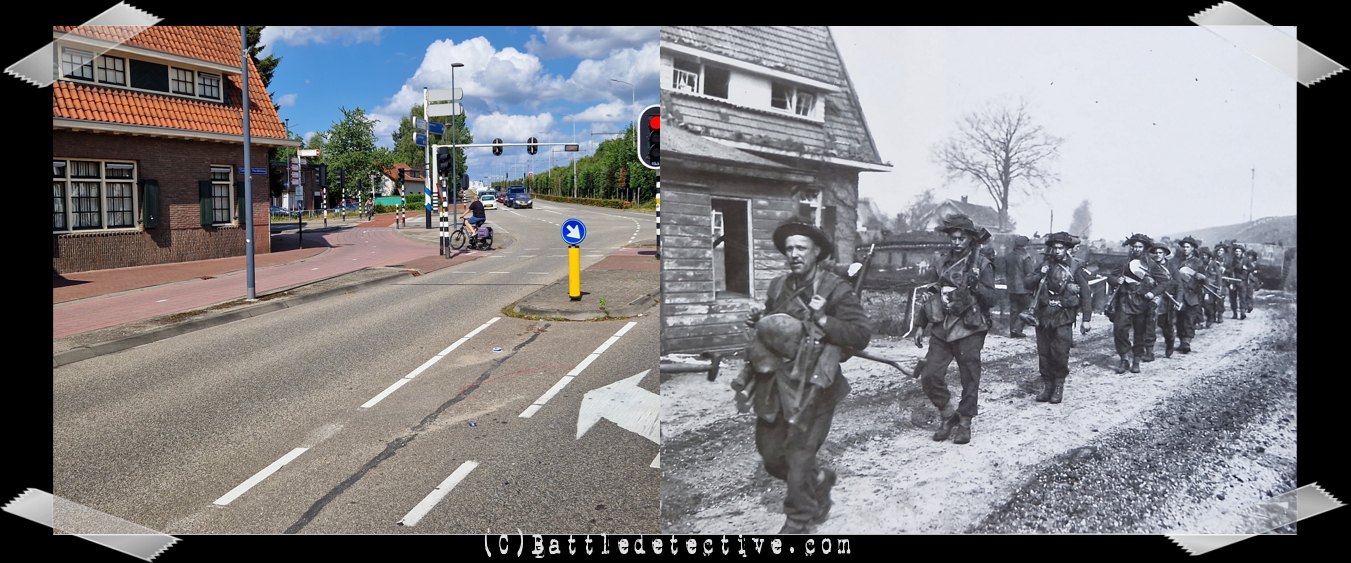 |
Westervoort, April 13th 1945
Troops of the British 49th
Division move into Westervoort in
preparation of the Canadian II
Corps’ Operation “Quick Anger” to
cross the river IJssel with the aim
of taking Arnhem. |
 |
Westervoort, April 13th 1945
More British troops enter
Westervoort in preparation of “Quick
Anger” to cross the river IJssel
with the aim of taking Arnhem. Here
they can be seen moving from Brugweg
into Dorpstraat. |
.jpg) |
Westervoort, April 13th 1945
"Buffalo" Amphibious Vehicles,
Tracked (LVT) move forward to cross
the river IJssel as both the railway
and road bridges across this river
have been blown up again; this time
by the Germans. In May 1940 the
Dutch defenders of these bridges
blew them up in an attempt to stop
the Germans from invading their
country. |
.jpg) |
Westervoort, April 13th 1945
More British vehicle move forward
toward the river IJssel, including
mortar carriers and halftracks. The
embankment on the left is the raised
railway line from Germany to Arnhem. |
 |
Westervoort, April 13th 1945
Buffalos and their crews wait
for their turn to advance west
towards the river IJssel and the
city of Arnhem. On May 10th 1940,
invading Nazi troops used an armored
train on the elevated railway line
seen here, to be stopped by Dutch
defenders of Fort Westervoort up
ahead. |
.jpg) |
Westervoort, April 13th 1945 British
troops of 56th Brigade backing up
Bren Carriers on to Buffalo IV
amphibious vehicles of the Canadian
Ontario Regiment before the initial
assault carried out by Brigadier R.
H. Senior’s 56th British Brigade,
which was to cross the IJssel river
at night.
|
.jpg) |
Westervoort, April 13th 194
5
This is on Brugstraat leading to
the dual road and railway bridge
which was destroyed by the Germans. |
 |
Westervoort, April 13th 1945
British artillery spotters of the
49th Infantry Division relay fire
missions on targets in Arnhem from
their position dug in the river
IJssel dyke in Westervoort. They are
in support of the 2nd Battalion The
South Wales Borderers in the second
wave across the river. |
 |
Arnhem, April 13th 1945
British infantry of the 49th
Infantry Division dismount from a
Buffalo amphibious vehicle on the
north bank of the river IJssel south
of Arnhem during the second wave
across the river during Operation
“Quick Anger”. The men made the
crossing under heavy artillery fire
support. Once across they quickly
advanced into Arnhem. |
 |
Arnhem, April 13th 1945
British infantry of the 49th Division have just crossed the IJssel River
in amphibious "Buffalo" tracked
vehicles .They move toward the ferry
landing road and on to Arnhem.
|
 |
Arnhem, April 1945
The northern IJssel river bank
secure in British hands and trucks
are driving passed traffic signs
along what is now the N325 highway. |
 |
Arnhem, April 14th 1945
During Operation "Anger"
(sometimes called "the Second Battle
of Arnhem") British soldiers of the
49th Division move
forward under cover of a Bren gun
team on almost the same location as
the SS-men in the photo taken in
September in the previous year.
|
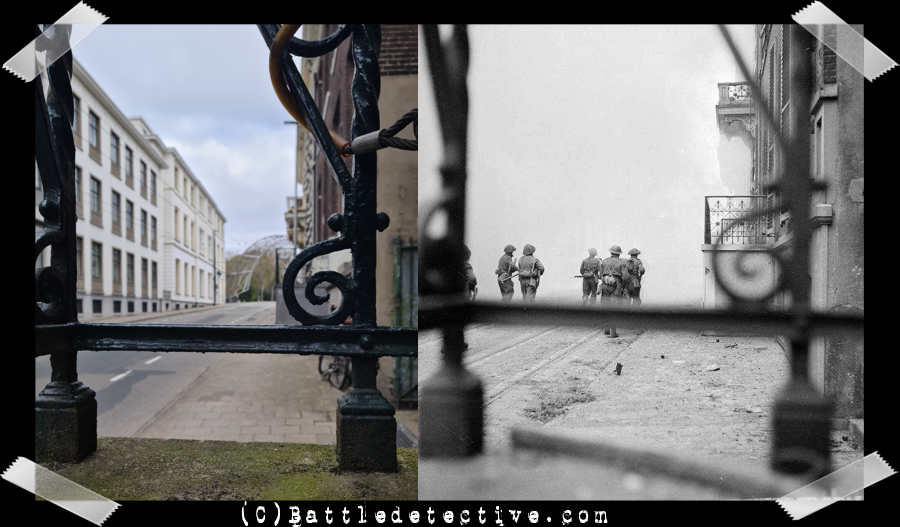 |
Arnhem, April 14th 1945
We found the "Then-"photo in a
post-war newspaper about the
liberation of Arnhem in the Gelders
Archive and had never seen it
before. The location is about the
same as the previous, often
published, photo on Utrechtsestraat
in Arnhem
|
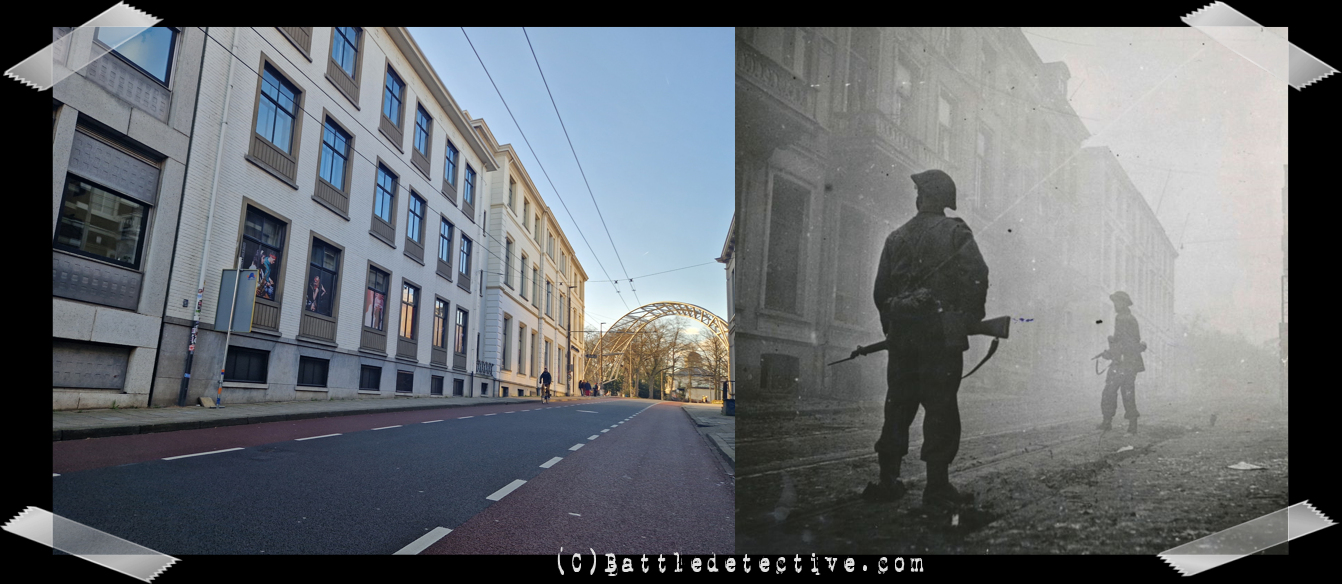 |
Arnhem, April 14th 1945
Infantrymen of the 49th (West
Riding) Infantry Division advance
forward on Utrechtseweg with fixed
bayonets and under cover of a smoke
screen. |
 |
Arnhem, April 14th 1945
British troops march German
POW's in western direction on
Utrechtseweg across from the museum.
Compare this photo with the one
taken at the same spot on 19SEP1944
with British POW's. |
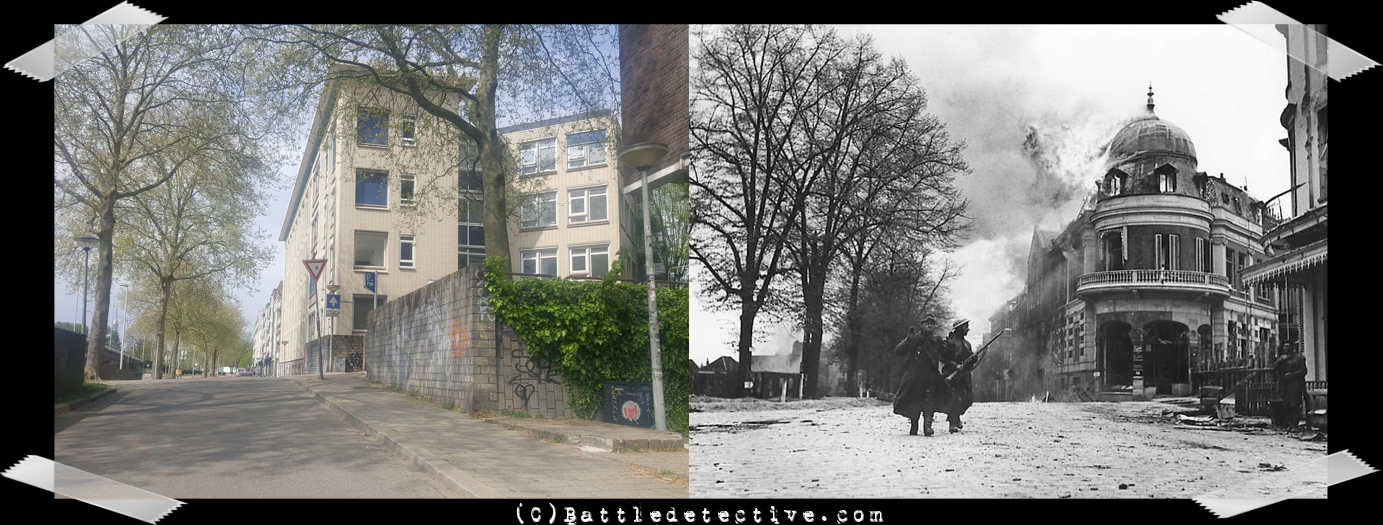 |
Arnhem, April 14th 1945
a British soldier escorts a
German POW at the corner of Oude
Kraan and Bergstraat. The city was
already evacuated after the first
Battle of Arnhem in September 1944
and there were no firefighting teams
present. This whole block burned
down and was rebuilt in the modern
square style of today. |
 |
Arnhem, April 14th 1945
A 6 pounder anti-tank gun crew
of the British Polar Bear division
takes position in a shop window on
Willemsplein.
Today the building accommodates a
branch office of the ING Bank. This
scene is recreated in a
diorama in the
Arnhem War Museum. |
 |
Arnhem, spring 1945
After the Battle of Arnhem in
September 1944, German troops have
fortified the high ground of the
northern Rhine river bank. Here on
the corner of Utrechtseweg and
Zwarteweg we see an improvized wall
of tree trunks and wooden boards;
possibly doors from the nearby
houses abandoned by its owners. On
the right is the Elisabeths Gasthuis
hospital. |
 |
Ede, April 17th 1945
Infantry of the 11th Royal Scots
Fusiliers searching houses on
Arnhemseweg. This is only a few
hundred yards west of the Drop Zone
used by 1st British Airborne
Division for Operation Market Garden
in September 1944. |
 |
Oosterbeek, September 21st
1944
Men of Nos. 15 and 16 Platoons,
C Company of 1st Battalion, The
Border Regiment, dug in along both
sides of Van Lennepweg waiting to
repulse an enemy attack on the
western edge of the Oosterbeek
Perimeter.
When this photo was taken, the enemy
was only 100 yards from this
location.
|
 |
Oosterbeek, September
1944
A lone wicker basket with long
awaited supplies lands in the lawn
in front of the Hartenstein Hotel on
Utrechtse Weg in Oosterbeek. The
Hartenstein was the 1st
Airborne Divisional HQ during the
Battle of Arnhem.
In 1946 the Airborne Monument
was unveiled on this lawn. |
 |
Oosterbeek, September
1944
A British soldier aims his U.S.
made .30 calibre M1 carbine from the
second floor balcony of the
Hartenstein Hotel. The hotel served
as Headquarters of the British 1st
Airborne Division during the Battle
of Arnhem. Today it is home to the
Airborne Museum. |
 |
Oosterbeek, September
1944
The same "Then-"photo but a
comparison taken after the reopening
of the museum in June 2020. It is
believed that the carbine belonged
to an American operator of an
inter-Allied radio set and that the
soldier in the "Then-"photo is
Sgt-Major Watt of HQ, B Squadron,
1st Wing, Glider Pilot Regiment, |
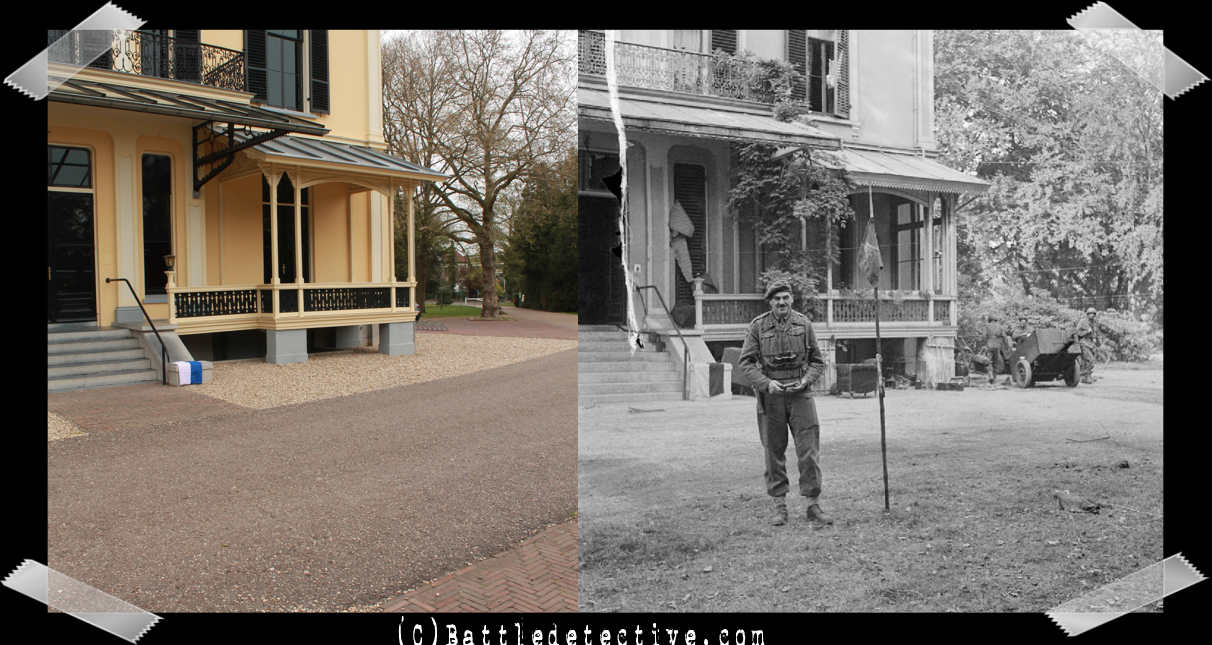 |
Oosterbeek, September
1944
General Roy E. Urquhart,
commanding officer of the 1st
British Airborne Division posing
with the division guidon at the back
of the Hartenstein Hotel; the
divisional headquarters. He is
holding a flashlight presumably
because of the dark conditions in
the cellar of the hotel where the
staff housed.
Note also the white and blue flag on
the steps telling divisional Signals
is located inside the building. |
 |
Oosterbeek, September
1944
A team of stretcher bearers
carrying away a wounded British para
behind the Hartenstein hotel. |
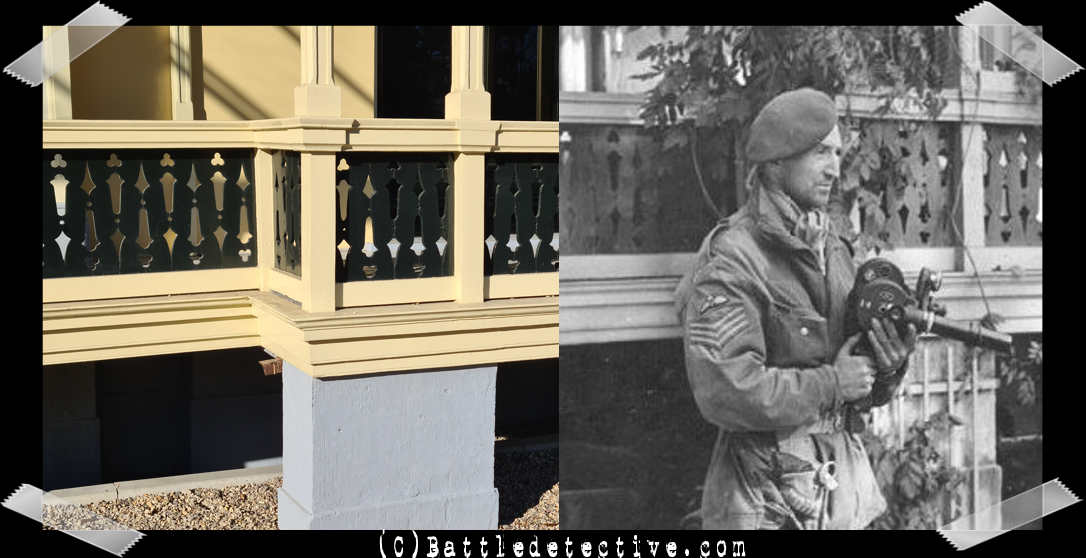 |
Oosterbeek, September
1944
Sergeant Gordon "Jock" Walker, film
camera operator of the British Army
Film and Photographic Unit
"embedded" with the 1st Airborne
Division during the Battle of Arnhem,
pictured outside the Hartenstein
Hotel, Oosterbeek, some day between
September 17th and 25th 1944. |
 |
Oosterbeek, September
1944
Debris and broken furniture on
the back lawn shortly after the
withdrawal of the British
paratroopers on September 26th 1944. |
 |
Oosterbeek, September
1944
April 2019: The restoration of
the front of the Hartenstein is
done. The building of the Airborne
Museum in Oosterbeek is now as it
was on September 16th 1944. |
 |
Oosterbeek, September
1944
Closer to the Hartenstein,
British defensive positions of slit
trenches and sand bags are visible.
Note also the damage to the
building. |
.jpg) |
Oosterbeek, September
1944
A close study of the front of
the Hartenstein shows damage caused
by artillery and small arms fire
which can still be seen after the
2019 restoration. |
|
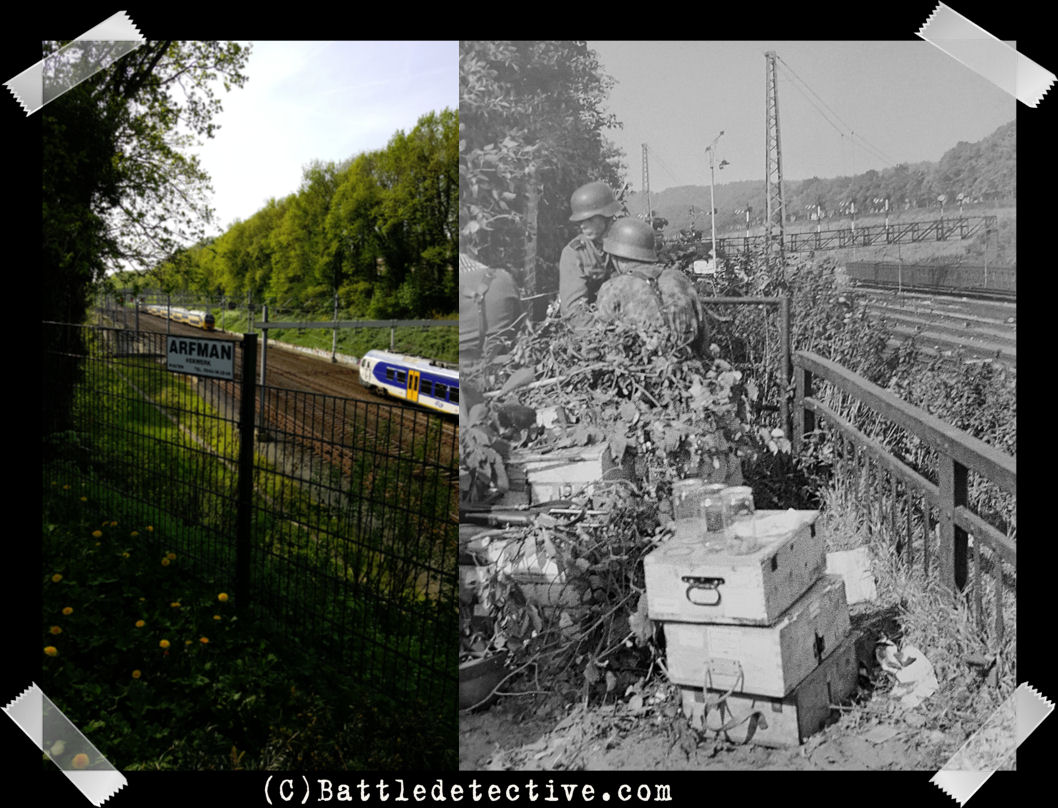 |
Arnhem, September
19th 1944
SS men take positions east of the Arnhem
central railway station on
Oranje Straat. Earlier this day
British paratroopers have
surrendered in large numbers and now
the Germans are strengthening their
positions in the city. This is the
high ground next to the railway
yards. |
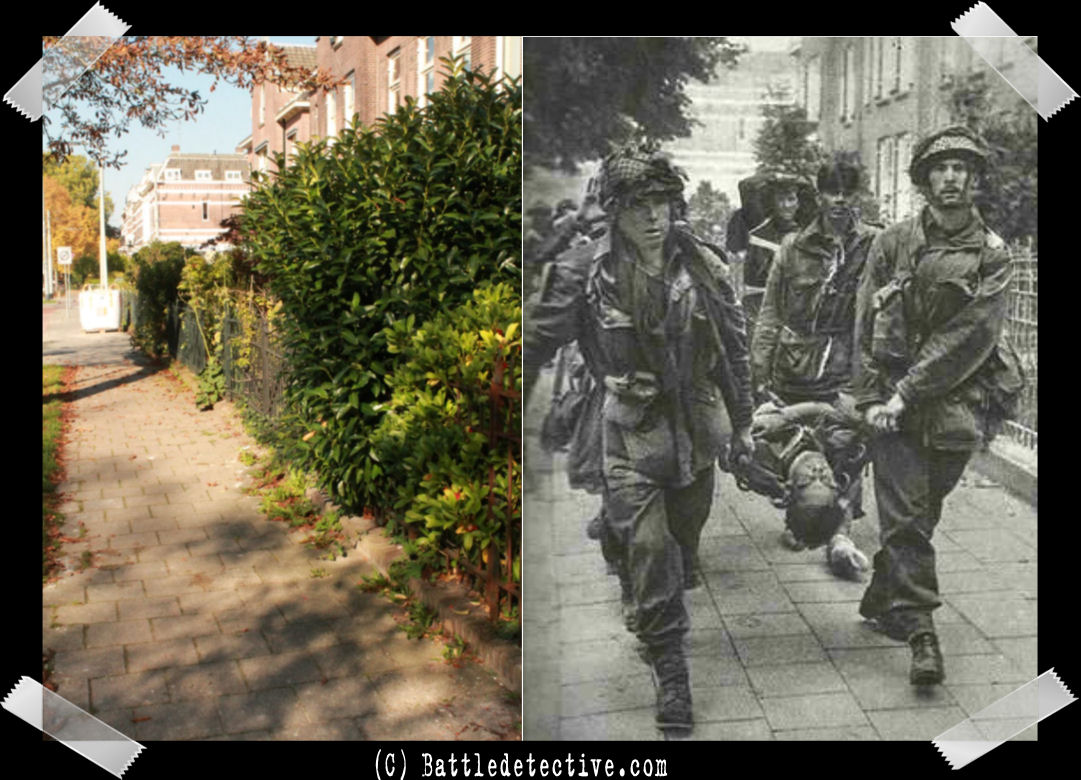 |
Arnhem, September 20th
1944
British Airborne defenders of the
Van Limburg Stirum school near the
northern ramp of Arnhem bridge,
surrendered after a German tank and
self-propelled gun had set the
building on fire. As prisoners of
war they were led away from the
bridge into Johan van
Oldenbarneveldt Straat, photographed
by German propaganda journalists. |
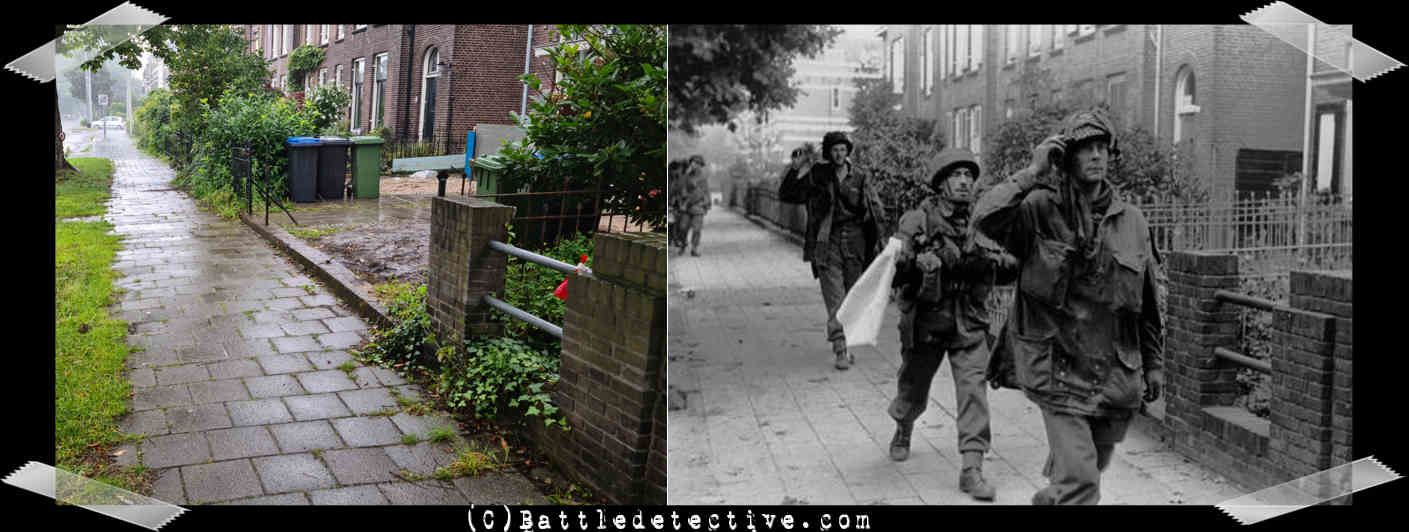 |
Arnhem, September 20th
1944
More British airborne men are
photographed surrendering while
waving a white flag on Van
Oldenbarneveldt Straat. |
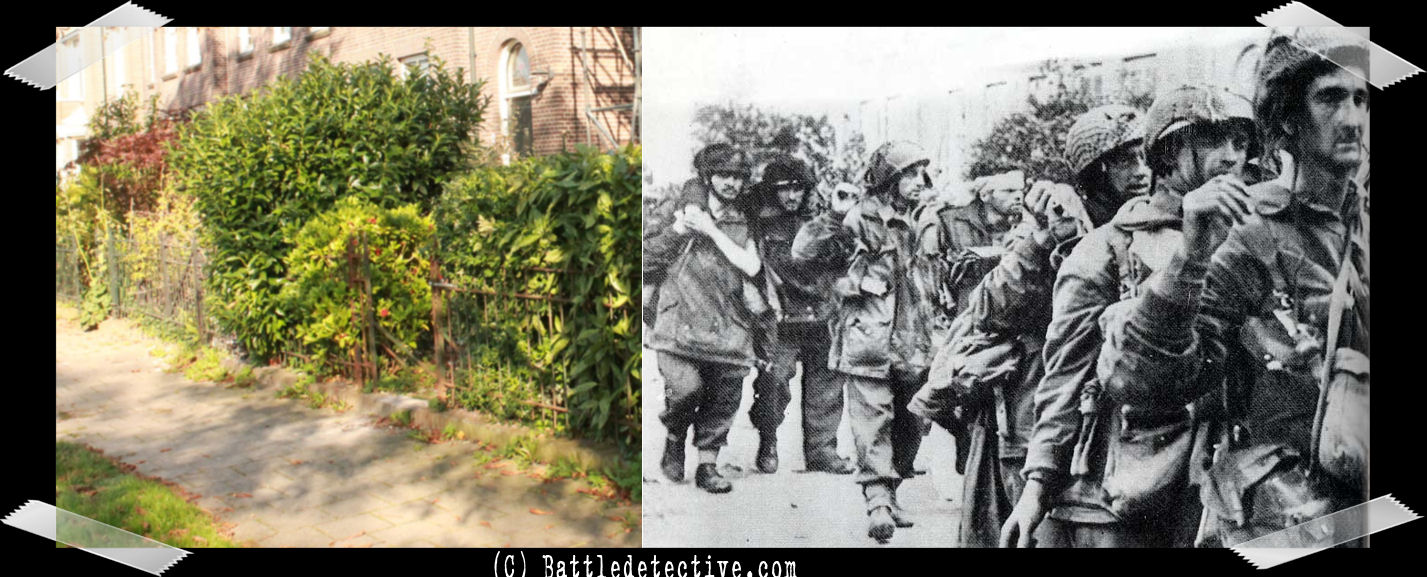 |
Arnhem, September 20th
1944
Glider pilots, sappers of the 1st
Parachute Squadron Royal Engineers
and parachute infantrymen of "C"
Company 3rd Battalion are led away
past No.'s 11 and 13 on Johan van
Oldenbarneveldt Straat. |
 |
Arnhem, September 20th
1944
Royal engineers Sergeant Norman
Swift, Sapper Charles Grier and
Sapper Dick Robb walk passed a
building that today houses a
kindergarten. |
 |
Arnhem, September 20th
1944
The prisoners were then led into the
yard of a timber company at No. 15.
The photograph shows Lieutenant
Wright and Sapper George Needham of
"A" Troop supporting Sapper Papworth. |
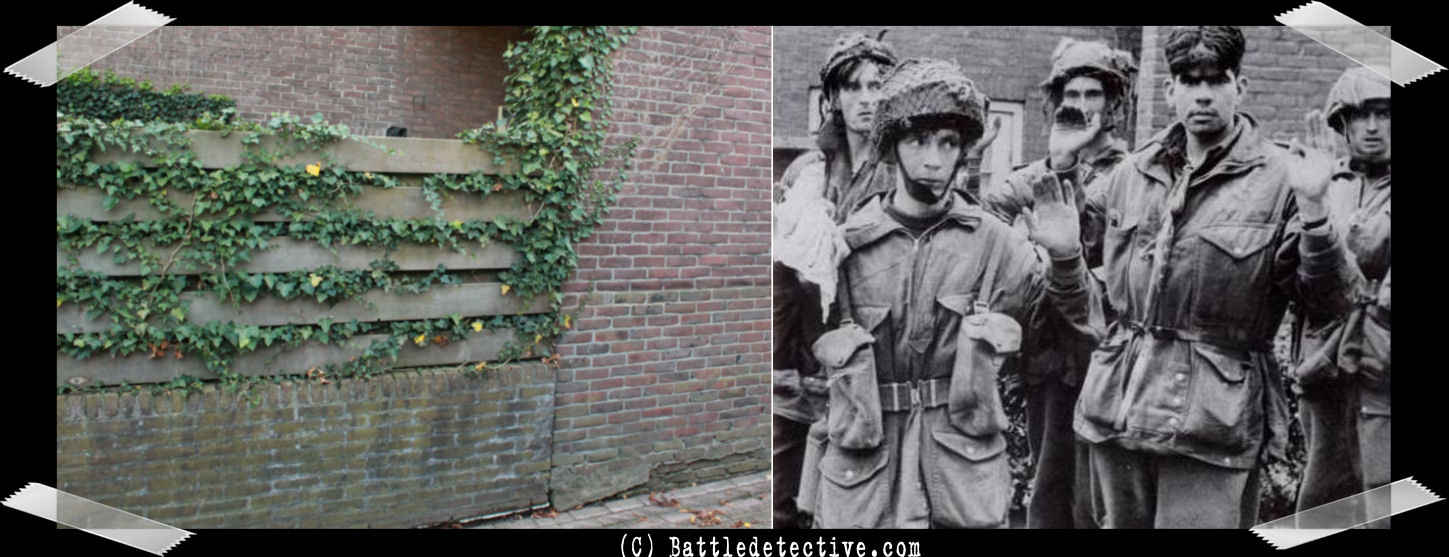 |
Arnhem, September 20th
1944
The POW's look dazed when lined up
by their captors. German
photographer Pirath took this image
of Lance-Corporal Swainson, Sapper
Booth, Privates Moran and Withers
and Corporal Weir. |
 |
Arnhem, September 20th
1944
British prisoners of war in the yard
of the Klugkist timber company on
Johan van Oldenbarneveldt Straat.
There is a parking lot of an
apartment building there today. |
 |
Arnhem, September 20th
1944
Royal Engineers Sappers Grier and
Robb, documented by German
photographer Kutzner, in an iconic
image of the British defeat at
Arnhem. |
.jpg) |
Arnhem, September 20th
1944
The same group of men of 3rd
Battalion and Royal Engineers taken
prisoner after the fall of the Van
Limburg Stirum School in the series
of photographs shot by the German
Luftwaffe war correspondent Helmuth
Pirath. Colorized by Nick Beech. |
 |
Arnhem, September 20th
1944
Grenadiers and crew members of
Kampfgruppe "Knaust" have dismounted
from theirtanks in the Rijnwijk
neighborhood near Arnhem bridge
waiting for the surrendered British
paras to leave the area. |
.jpg) |
Arnhem, September 20th
1944
Kpfw IIIs of Panzerkompanie
Mielke on Nieuwe Kade with the
Arnhem bridge in the background. The
PzKpfw III Ausf M on the right was
parked in the driveway of Jos Pe
printing firm. |
.jpg) |
Arnhem, September 20th
1944
A crew member of one of the PzKpfw
III tanks of Panzerkompanie Mielke
poses behind his vehicle on the
corner of Nieuwe Kade and
Badhuisstraat. The Arnhem road
bridge is just around the corner to
the right and the tank is parked
behind the cover of the Jos Pé
printing company. |
.jpg) |
Arnhem, September 20th
1944
After the war the large window
has been bricked shut. These last 4
photos were taken with the camera of
crew member Karl-Heinz Kracht who is
seen here eating from his mess kit. |
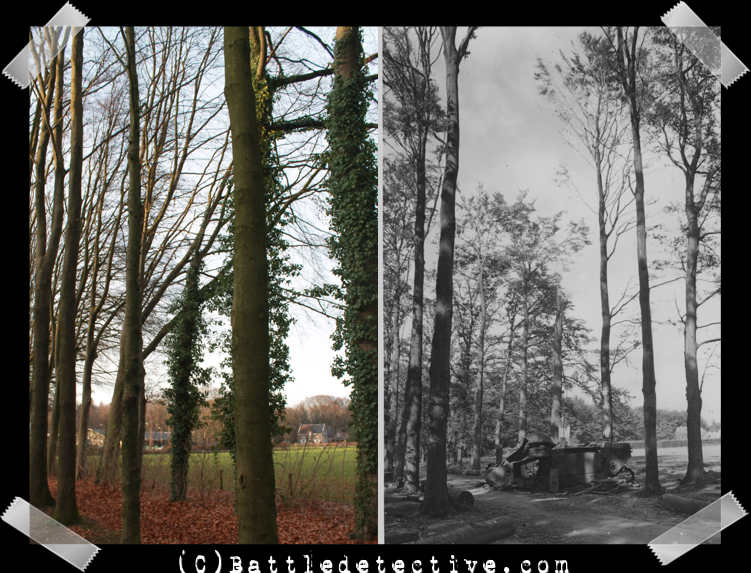 |
Oosterbeek, late September 1944
A knocked out captured French Char B
tank concerted into a flame throwing
“Flammwagen auf Panzerkampfwagen
B-2(f)”. of Panzer-Kompanie 224,
on Sonnenberglaan. This German unit
was stationed in Arnhem during
Operation Market Garden, losing six
tanks to anti-tank weaponry when
they were sent to attack the
Oosterbeek perimeter on
20–21SEP1944. This vehicle was
knocked out by a British 17 pounder
anti-tank gun after it came into
this area from the north. |
 |
Oosterbeek, late
September 1944
A German "StuG" sits on
Benedendorpsweg in Oosterbeek. It was
knocked out by one of the British
anti-tank guns manned by John
Baskeyfield on 20SEP1944 which
earned him the Victoria Cross
posthumously. |
 |
Oosterbeek, late
September 1944
This photo was taken across the
road from the Old Church on the
corner of Benedendorpsweg and
Weverstraat looking west toward
Rozensteeg. It shows a British
anti-tank gun left behind after the
battle; most likely a 6 pounder. |
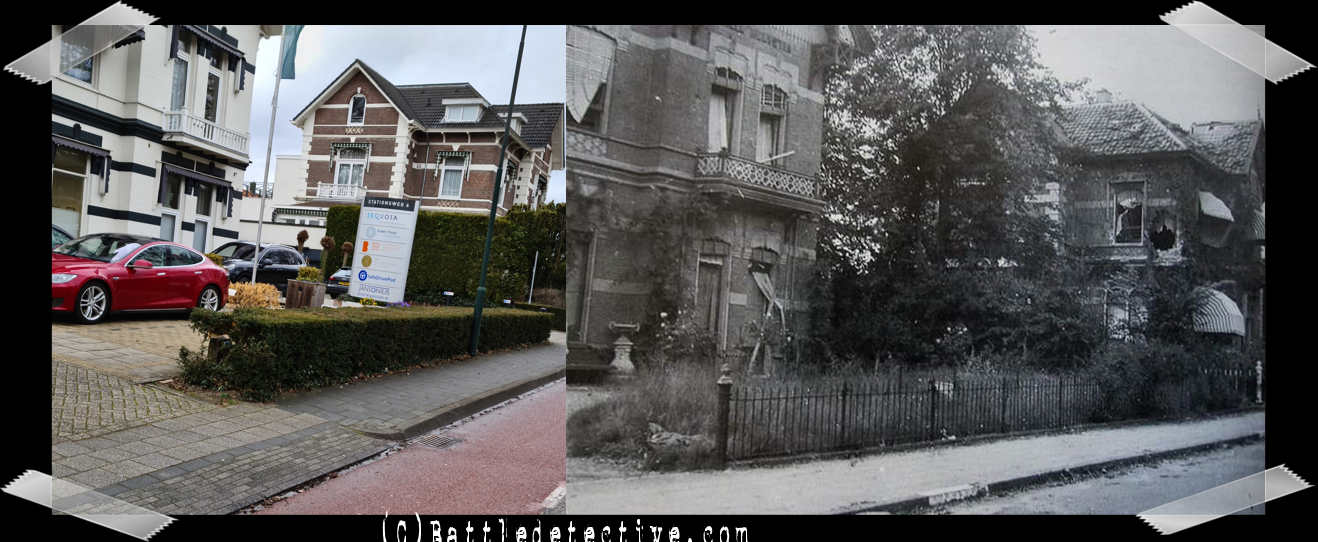 |
Oosterbeek, late
September 1944
Damaged houses on Stationsweg.
The house on the left is No.6 and is
close to the crossroads where in the
Schoonoord and Vreewijk buildings
the British Dressing Stations
were located. This also marked the
eastern boundary of the perimeter. |
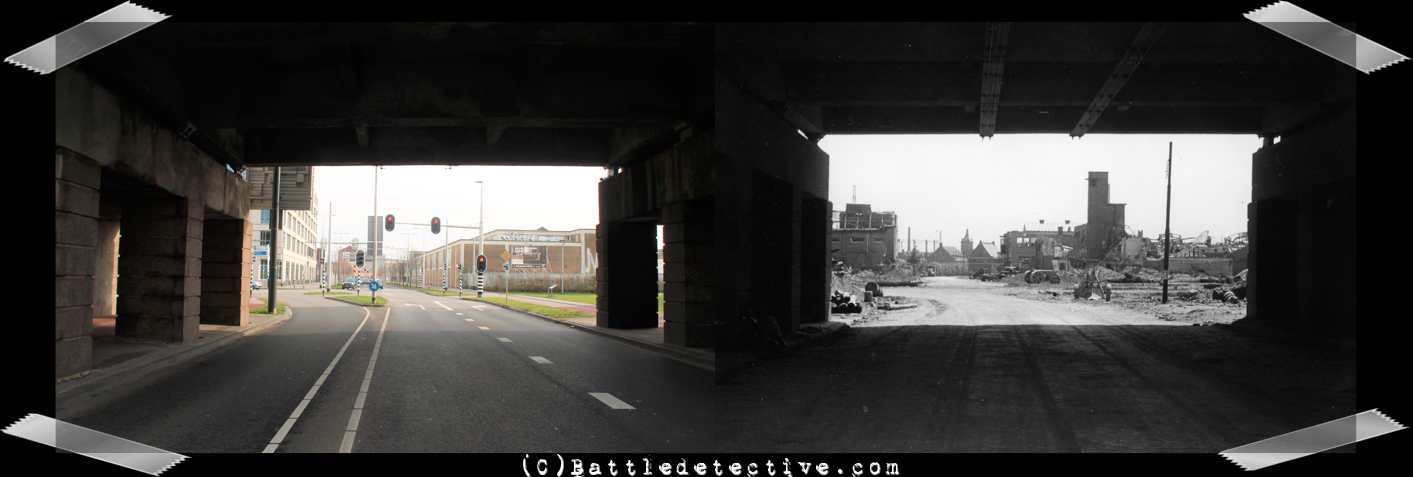 |
Arnhem, late
September 1944
Photo taken after the battle of
Arnhem looking east into
Westervoortsedijk through the Arnhem
road bridge.
On the right in both the Then and
the Now photo's are the remnants of
milk plants. |
 |
Arnhem, September
21st 1944
After the British paratroopers
at Arnhem bridge have surrendered,
German troops rush south to attack
the British at Nijmegen. No traffic
circle today but wide double lanes
on Nijmeegse Weg. |
 |
Arnhem, September
21st 1944
German troops of what is assumed
to be "Kampfgruppe Knaust". The
German "Arnhem" sign with several
arrows painted across it, was on the
spot where the electric trolley bus
lane is today. |
.jpg) |
Arnhem, Late September
1944
In between the north-east
ramp of the Rhine road bridge and
Eusebiussingel are the ruins of the
Van Limburg Stirum School defended
by Royal Engineers of the 1st
Parachute Squadron's "A" Troop. |
.jpg) |
Arnhem, Late September
1944
After the end of World War Two
the entire city section around the
bridge, named "John Frost Bridge"
today, was redesigned and newly
developed making a precise Now &
Then comparison a difficult one. |
.jpg) |
Arnhem, Late September
1944
Another photo of the carnage
around the Van Limburg School on the
north west ramp of the Arnhem road
bridge after the battle. The ramp
has no buildings on it today and is
converted into a tranquil park. |
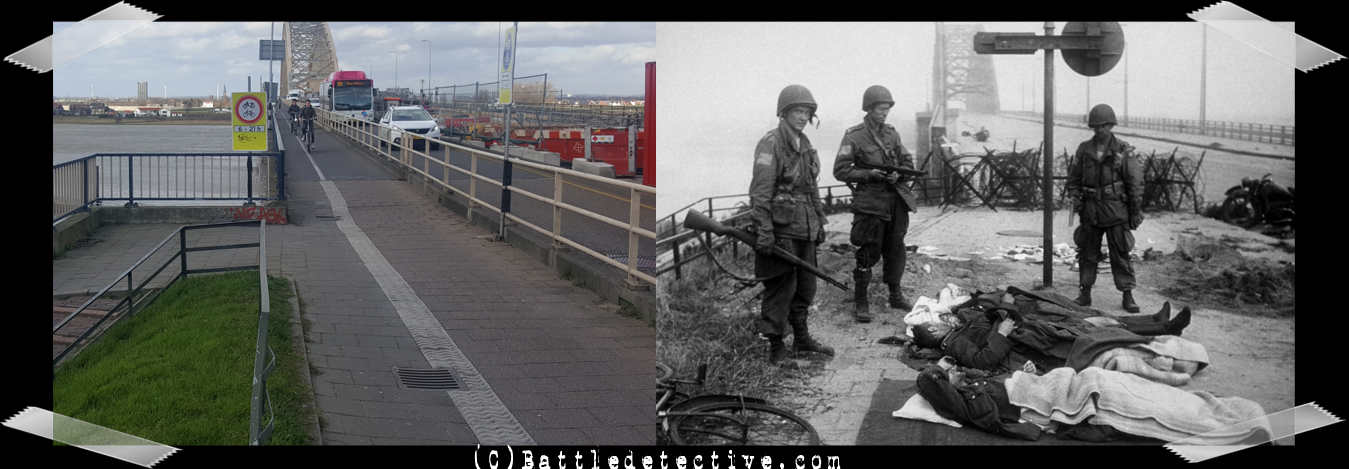 |
Nijmegen, September 20th 1944
On the Southern ramp of the road
bridge across the Waal river,
American paratroopers of the 505th
Parachute Infantry Regiment look
down on wounded German soldiers who
moments before this photo was taken,
were there adversaries during the
battle for the bridge. . |
 |
Nijmegen, September 27th 1944
British paras who have escaped
from the Oosterbeek perimeter cheer
relieved becasue they have survived
the Battle of Arnhem. This picture
is a still from a British newsreel. |
.jpg) |
Nijmegen, September 27th 1944
Paras, some of them identified
as members of the Reconnaissance
Squadron, sort out their weapons in
front of the Bishop Hamers
buidling; also known as the Pagoda
because of the Chinese looking
viewing platform on its roof. |
.jpg) |
Nijmegen, September 27th 1944
An unidentified Airborne Captain
jokes with other paratroopers who
have escaped the Oosterbeek
perimeter because the Captain left
without his army issued trousers and
combat boots. |
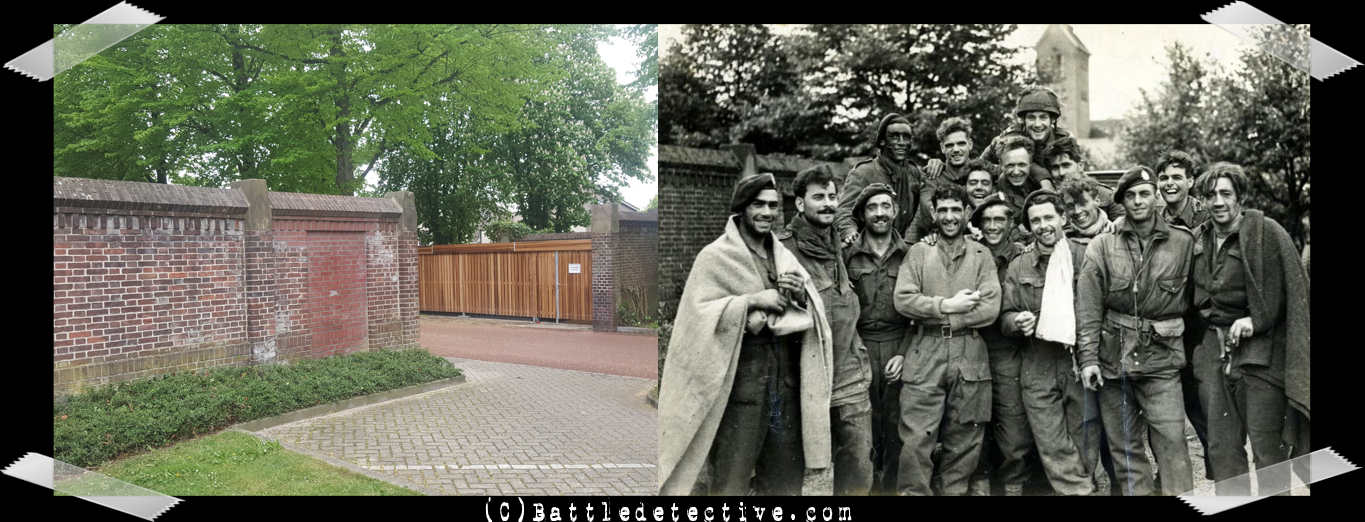 |
Nijmegen, September 27th 1944
British soldiers smile for the
camera after they have successfully
withdrawn from the Oosterbeek
perimeter. The wall in the
background is surrounding the
building which was a collection
point for soldiers who returned from
the Battle of Arnhem. |
 |
Nijmegen, September 27th 1944
Major Dick Lonsdale (left)
of Lonsdale Force, gets a light from
1LT David Polley of "C" Section
(lines) of Division Signals. They
are photographed in front of the
Roman Catholic College for female
teachers on Groesbeekseweg. |
 |
Nijmegen, October 1944
The Nijmegen road bridge
disappears in the fog but is firm in
Allied hands. An abandoned German
PAK anti-tank gun can be seen in the
foreground next to a bicycle rack
with the Heineken beer brand on it. |
 |
Nijmegen, October 1944
A Kodachrome color photo of
Nijmegen bridge from the photo album
of MAJ Allen Bedell, commanding
officer of the 307th Airborne
Engineer Battalion which took part
in the heroic Waal river crossing on
September 20th, 1944. (Photo
courtesy of Arthur Rottier from
Anhem.) |
.jpg) |
Eindhoven
September 20th, 1944
Damage to houses on August
Sniederslaan after the German
bombing raid on Eindhoven. The staff
car in the foreground was lent to
American generals Brereton of the
1st Allied Airborne Army and Ridgway
of the 18th Airborne Corps by Field
Marshal Montgomery’s staff. The
generals, curious about the
development of Operation “Market
Garden” drove to Eindhoven in
this car to be caught in the raid.
They abandoned their vehicle to head
for cover. |
.jpg) |
Eindhoven,
October 1944
American pilots of the Ninth Air
Force ride jeeps on Zeelsterstraat
to Landing Zone "W" near Son. Their
task will be to fly CG4A gliders
that are still air-worthy after the
Operation "Market Garden", back to
air bases in England.
(Photo courtesy of Arthur Rottier
from Anhem.) |
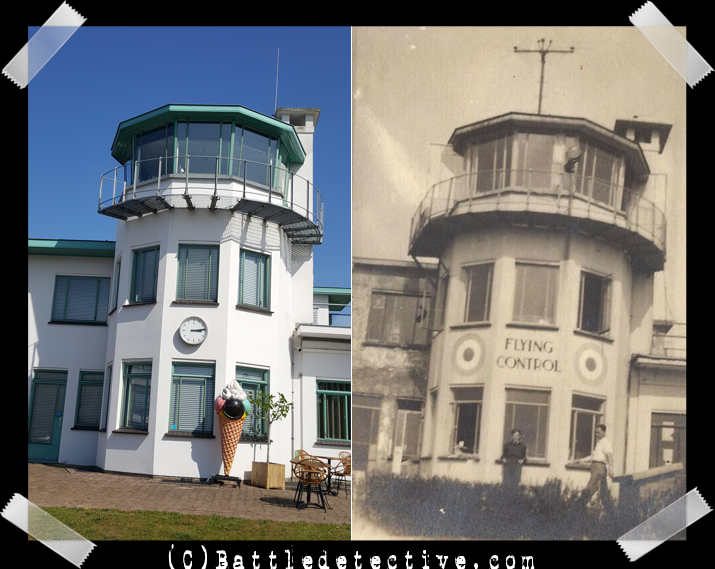 |
Eindhoven, late
1944
The control tower of the
Welschap aerodrome, built in 1935,
is now in use by the Royal Air
Force. During the German occupation,
this was the "Fliegerhorst EIndhoven"
of the Luftwaffe. The building is
now a restaurant and is located in
the center of a new residential area
in between Eindhoven and
Meerveldhoven, named "Meerhoven". |
 |
Elst, October
1944
In this day and age no photo
comparison album would be complete
without the photo of Captain Richard
Winters, commanding "E" Company of
the 506th Parachute Infantry
Regiment, posing in front of his
Command Post at the Schoonderlogt
farm on Logtse Straat in Elst.
Winters and "Easy" Company were made
world famous by the HBO TV series
"Band of Brothers" which is the
filming of historian Stephen
Ambrose's book with the same title
in 2001. |
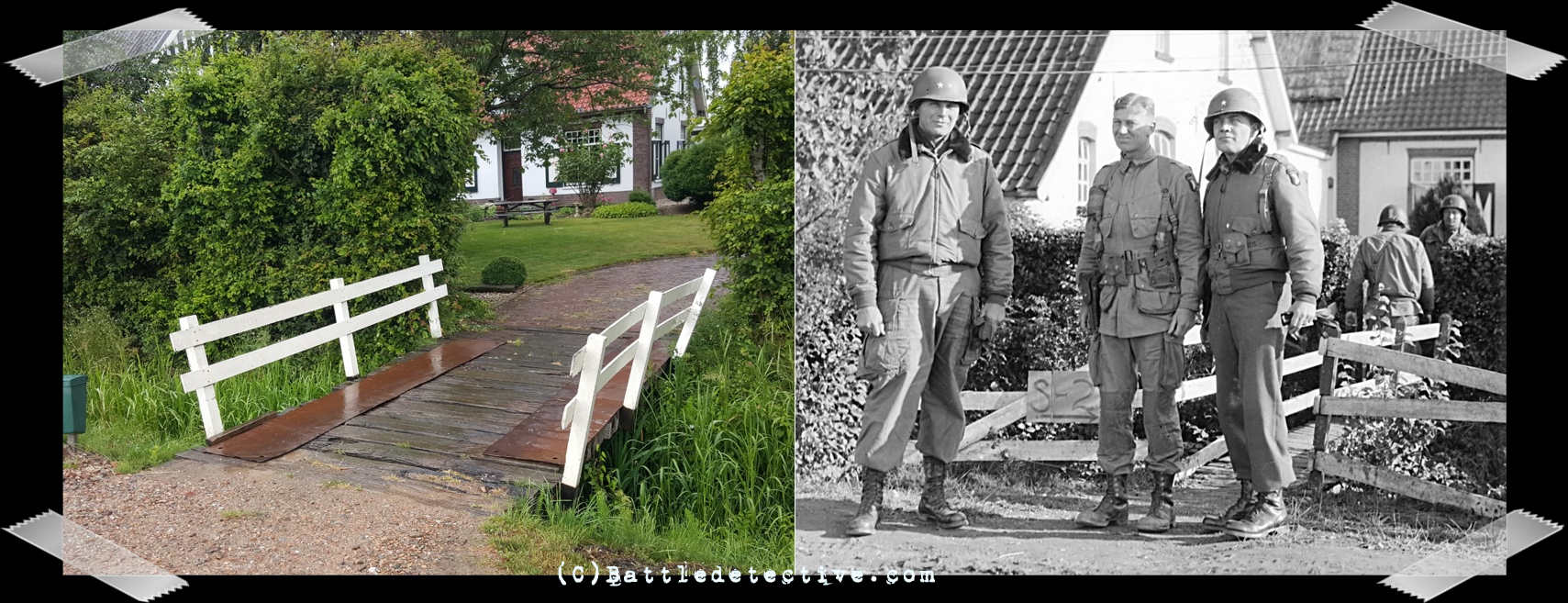 |
Elst, October
1944
On 4OCT1944, Generals Taylor and
McAuliffe visited COL Johnson at his
CP on the Eshof farm. They are seen
here while visiting the Intelligence
(S-2) section in the
farm “The Logt”, just north of the
Schoonderlogt estate in the previous
photo.
Johnson would be killed on 8OCT1944
by mortar fragments along
the dike west of Driel. |
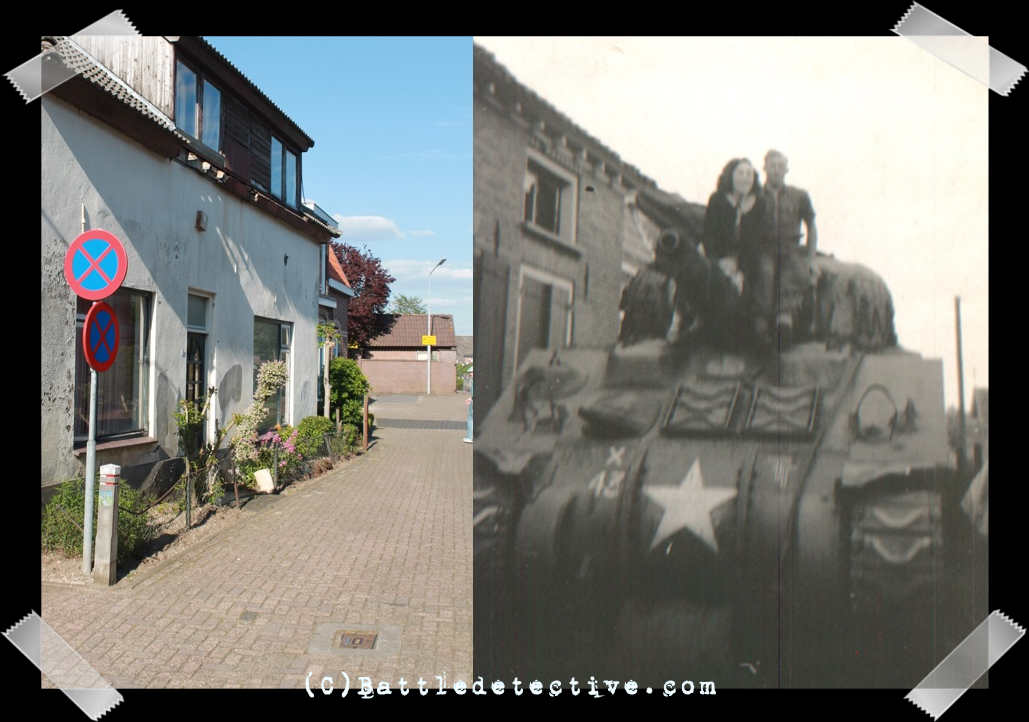 |
Valburg, Autumn 1944
A Sherman Tank of the 50th
(Northumbrian) Infantry Division is
parked close to the cemetery on
Bakker Straat in Valburg. |
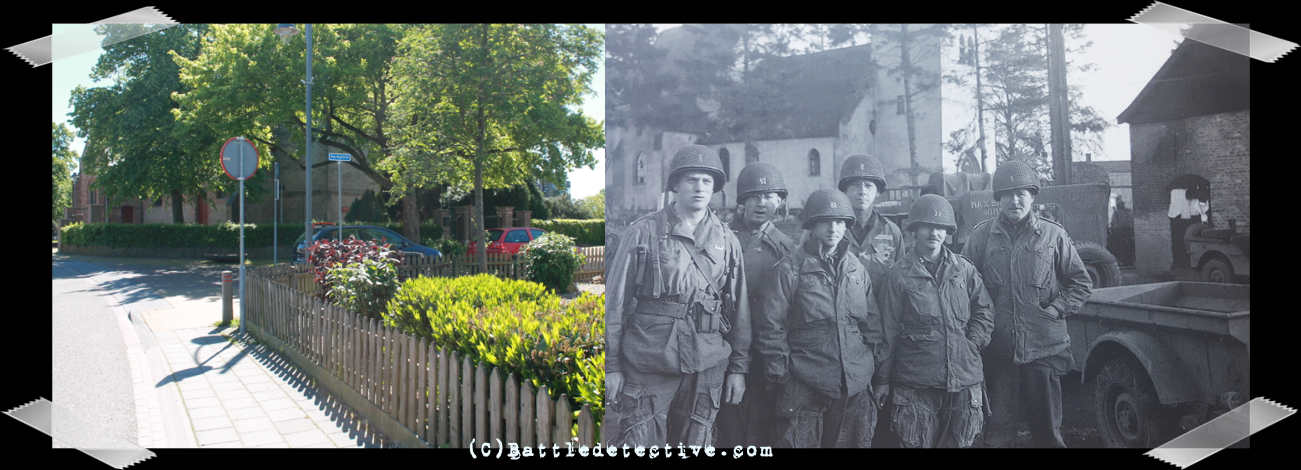 |
Valburg, Autumn
1944
It is assumed that these officers,
posing in front of the Reformed
church in Valburg are captains Joe,
Ganier and Jackson, commanding
Batteries D, E and F of the 81st
AT/AA Bn. |
.jpg) |
Valburg, Autumn
1944
Hospital ward tents of Platoon “B”
of the 50th Field Hospital set up on
the fields of Fruithof Farm of the
Speyer Family on Reethse Straat. The
50th FH was responsible for first
aid closest to the battlefield of
the 101st Airborne Division. |
.jpg) |
Valburg, Autumn
1944
A red cross panel is laid out in the
field near the hospital tents to
prevent it from being shelled or
bombed as happened to the 101st
Airborne division Clearing Station
in Nijmegen on 29OCT1944; killing 8
men. The Fruithof Farm is at right
and Sherman tanks are on Reethse
Straat at left. |
 |
Andelst, Autumn
1944
Regimental Surgeon CPT Louis R. Kent
of the American 506th Parachute
Infantry Regiment, and T/4 Paul
Miller in front of the Aid Station
in Andelst. The church gate is in
the background. |
 |
Opheusden,
October 1944
In front of a Dutch casemate along
the Linge Canal on Dalwagense Weg in
Opheusden, forward observer SGT
William J. Stone of “B” Battery,
321st Glider Field Artillery
Battalion radios coordinates to the
firing batteries by means of his
SCR-609 artillery ground radio. |
 |
Dodewaard, Autumn
1944
Two members of the 81st AT/AA Bn
pose in front of the dyke warehouse
on Waalbandijk in Dodewaard where
they are stationed. The SS-graffiti
have been painted on the wall
because of the Dutch had at that
time, destroyed road signs. The next
SS post is 12 kilometers ahead in
Tiel. In the “Now-“photo historian
Bauke Huisman of the
Betuwe War Information Center
examines the outer walls for battle
damage and possible paint residue. |
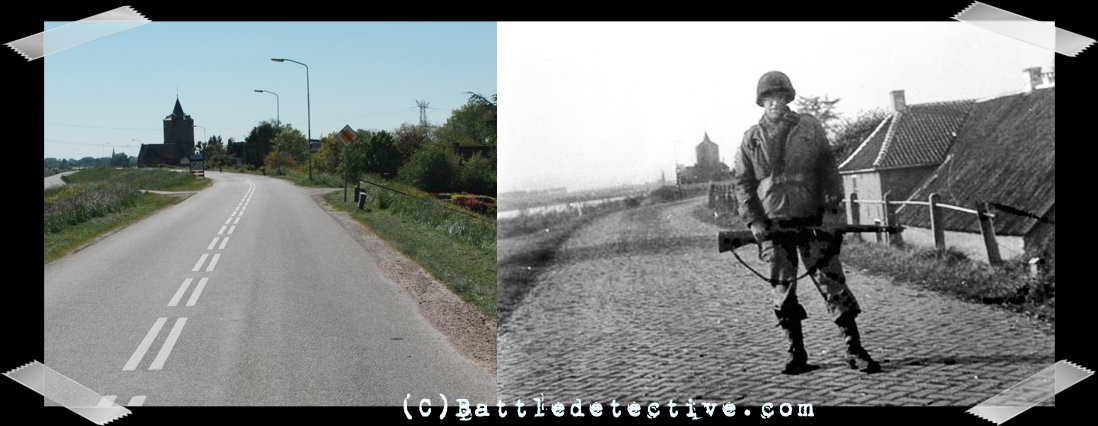 |
Dodewaard, Autumn
1944
1LT Kizenkavich on Waalbandijk in
Dodewaard a few hundred meters ahead
from the dyke warehouse. In the
background is the Reformed church of
Dodewaard. |
 |
Slijk-Ewijk,
Autumn 1944
An MP of the 101st Airborne Division
directs the car of a local doctor
along Valburgse Straat on the
junction with Akker Straat on the
right. There the Division Forward
CP, call sign “Kangaroo FWD CP” is
located. |
 |
Hemmen, Autumn 1944
On 10OCT1944 the 502nd PIR took
over the southern half of the line
held by the 327th Glider Infantry
Regiment in Opheusden. Until
15OCT1944, the Germans kept
attempting to clear the Betuwe area.
Here an American patrol crosses the
railway line between Hemmen and
Dodewaard. |
.jpg) |
Heteren, Autumn
1944
The windmill on the dike between
Randwijk and Heteren, just east of
the T-junction with Renkumse Veer
road leading to the ferry boat
across the Rhine.Al Krochka staged
this photograph of SGT Gillis, PFC
Newton and PVT’s Wilson and Turer of
“F” Company of the 501st advancing
cautiously passed the shell-damaged
windmill. |
.jpg) |
Heteren, Autumn
1944
In the field between the
windmill and the river, the Germans
rallied for an attack but were
surprised by CPT Winters and a
platoon of “E” Company of the 506th
Parachute Infantry Regiment. The
windmill was the target of a German
artillery barrage because it could
be used as an observation post.
After the war the mill was
demolished and today only its mound
remains. |
 |
Herveld, Autumn
1944
PFC’s Woodell, Lee, Mettie, CPL
Radovick and PVT Skok, a Browning
.50 caliber machine gun crew of the
907th Glider Field Artillery Bn., are
positioned in a field on
Meeuwerdense Straat in Herveld. The
farm in the background was their BN
HQ |
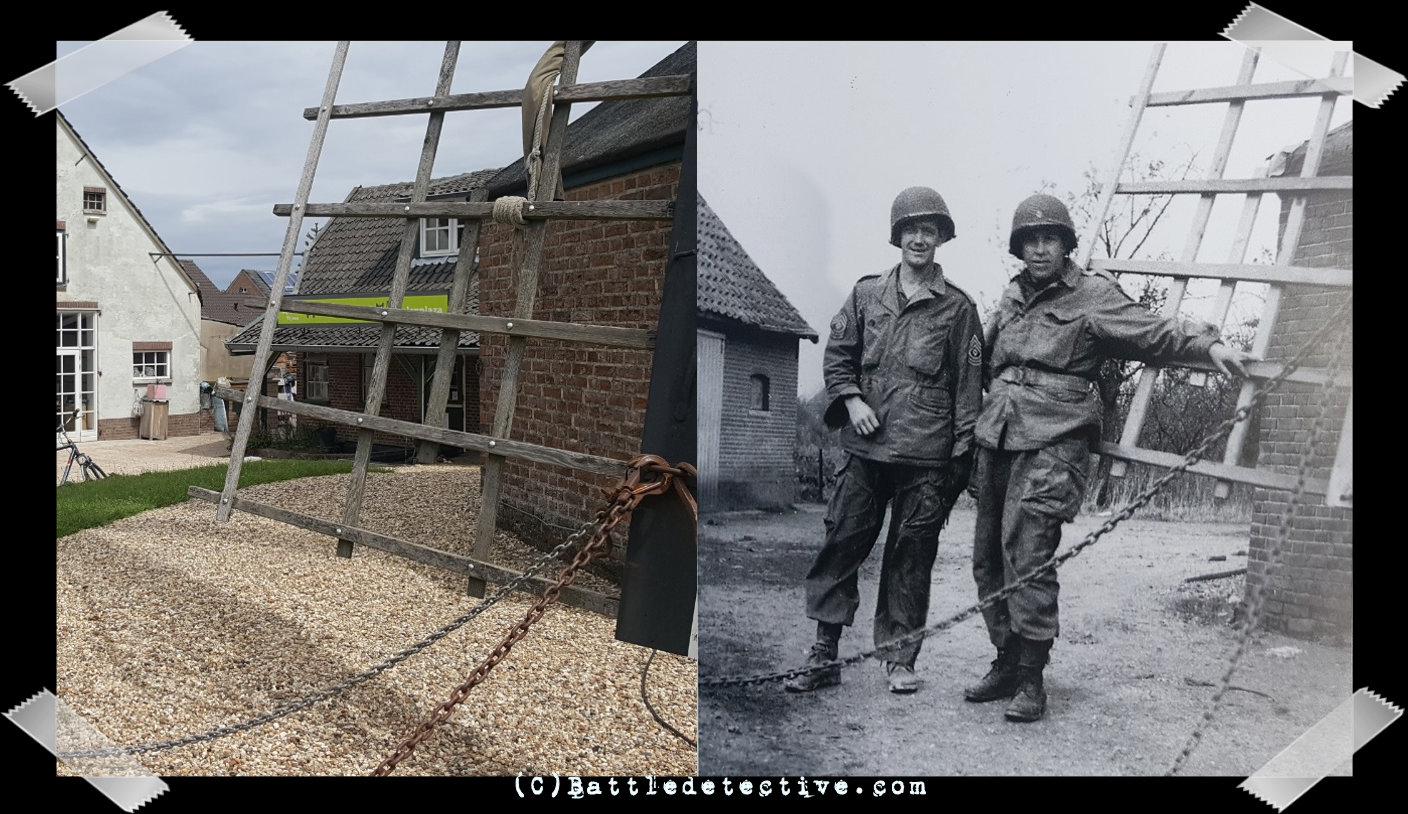 |
Herveld, Autumn
1944
1SGT Ellis and 1LT Kizenkavich
of "E" Battery 81st
Anti-Tank/Anti-Aircraft Battalion of
the 101st Airborne Division pose in
front of the windmill in Herveld.
After the war an earthen mount was
constructed around the windmill.
|
.jpg) |
Herveld, Autumn 1944
CPT Swanson of “A” Company of
the 502nd PIR found a British BSA
M20 motorbike which he used to drive
up and down to Division HQ in
Slijk-Ewijk. Here he is pictured at
the Moordakker Farm in Herveld where
“A” Company’s CP was established at
that time. |
.jpg) |
Herveld, Autumn 1944
CPT Swanson is seen here riding
his BSA motorbike off the driveway
to the Moordakkerweg road. |
 |
Oosterhout,
November 25th 1944
Men of “A” Battery, 377th
Parachute Field Artillery BN board
storm boats of the Canadian 23rd
Field Company who ferried them
across the Waal River away from
their deployment on “The Island”. |
 |
Weurt, November
25th 1944
Paratroopers of the 101st Airborne
Division board heavy trucks on
Jonkerstraat, which will take them
on an 18 hour ride to Camp Mourmelon
near Reims in Northern France. Here
they would rest and rearm until the
Nazi Ardennes Offensive on December
16th 1944. Note combat ration
wrappers discarded in the ditch in
the last minute before boarding.
|
 |
Weurt, November
25th 1944
The paratroopers ride British
trucks on the T-junction of
Jonkerstraat and Van Heemstraweg
while an American Military Policeman
directs traffic. The tea house on
the right has been demolished after
the war. |
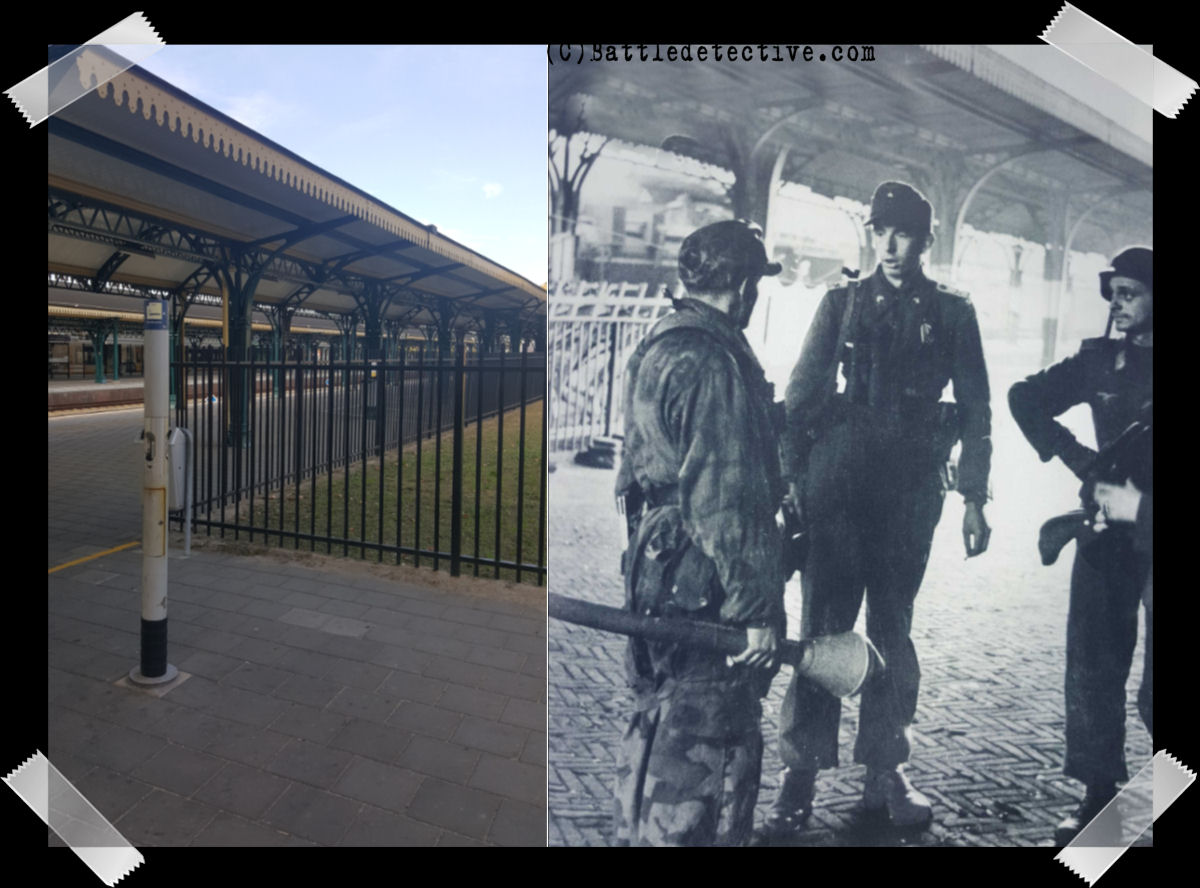 |
's-Hertogenbosch,
October 26th 1944
Photo by Kriegsberichter
Rutkowski at the railway station of
the capital city of the Dutch
province of North-Brabant. A
Fallschirmjäger with a
Panzerfaust anti-tank rocket
talks to another German soldier,
presumably of the 559th Schwere
Heeres Panzerjäger Abteilung
(heavy anti-tank brigade). Note the
cigarette in the hand of the center
soldier and the "smokers column" on
the modern day platform. |
 |
's-Hertogenbosch,
October 26th 1944
British photographer Peter
Handford shot this scene on the
corner of Vughter Straat and
Berewout Straat in front of the Van
Dartel fish shop. Local resistance
fighter Martin Suiskens brandishes a
captured German Mauser rifle while
soldiers of the Welsh Division cross
the street. |
 |
Biest-Houtakker,
October 27th 1944
During the attack on Tilburg
soldiers of 8th Battalion the Royal
Scots Fusiliers (15th Scottish
Division) take a rest next to the
road on Biestsestraat a short
distance away from the draw bridge
across the Wilhelminakanaal
waterway. |
 |
Spoordonk,
October 25th 1944
Churchill tanks with infantry of the
6th Battalion Royal Scots Fusiliers
cross the river Beerze during their
advance on Tilburg. The bridge is
too weak and a Bailey bridge had
been constructed to strengthen it.
This is the first of a series of
Now&Then diptychs showing the
advance of Scottish troops on
Tilburg during Operation “Pheasant”. |
.jpg) |
Spoordonk,
October 25th 1944
On the road from Spoordonk to
Moergestel. Just over 2 miles from
the watermill in the previous
comparison, soldiers of the Royal
Scots Fusiliers march west. |
.jpg) |
Moergestel,
October 25th 1944
Infantry of the Royal Scots
Fusiliers march west as the
commander of a Churchill tank looks
into the war correspondent's camera
lens. |
.jpg) |
Moergestel,
October 25th 1944
This photo was taken only a few
hundred yard west of yesterday's
comparison. Infantry of the Royal
Scots Fusiliers and Churchill tanks
of the 6th Guards Armoured Brigade
stand still seemingly waiting for
orders to continue their advance. |
.jpg) |
Moergestel,
October 25th 1944
Infantry of the 15th Highland
Division advance from Oirschot to
Tilburg and near the outskirts of
Moergestel on their way. On the
right, verges are being cleared of
mines; on the left side of the road
is the Draaiboompje Café. |
 |
Moergestel,
October 25th 1944
The following ten (10) Now &
Then comparisons tell a
minute-by-minute account in pictures
of the Scots Guards (part of the 6th
Guards Tank Brigade in support of
the 15th Scottish Division) during
Operation “Pheasant” reaching
Moergestel to find a bridge in the
road into town destroyed. |
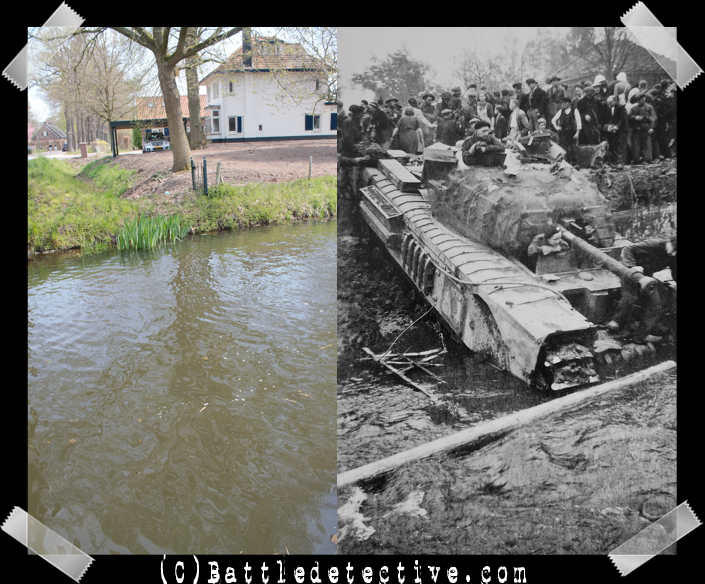 |
Moergestel,
October 25th 1944
The Churchill tank named “Montrose”,
commanded by Lieutenant Archie
Fletcher, tried to cross the river
Reusel but unfortunately it slipped
back into the creek and sank in the
mud. |
 |
Moergestel,
October 25th 1944
Despite the bridge being blown,
infantry gets across the Reusel
river by means of a make-shirt
footbridge created by local
civilians. Here villagers are seen
throwing stones and debris from the
bridge in the creek to make it more
shallow. |
 |
Moergestel,
October 25th 1944
A Scottish infantry soldier
carrying a PIAT (Projector Infantry
Anti-Tank) is helped climbing the
west bank of the Reusel river after
he crossed the makeshift footbridge. |
 |
Moergestel, October 25th 1944
A Scottish Churchill tank
equipped with a Class 30 “Scissors”
bridge arrives at the river Reusel
under a loud applause from the
gathered crowd. The tank named
“Montrose” is still bogged down in
the muddy bank on the right. |
.jpg) |
Moergestel,
October 25th 1944
The crowd watches in silence as
the scissors bridge is lowered on
the banks of the Reusel river over
the demolished bridge. A Royal
Engineers officer stands on top of
the bridge to oversee the correct
way to lay it across. |
.jpg) |
Moergestel,
October 25th 1944
The scissors bridge across the
remnants of the old Reusel river
bridge is in place and a Bren
Carrier rolls across it. A dispatch
rider with a Sten gun slung on his
back, waits his turn to cross. |
.jpg) |
Moergestel,
October 25th 1944
Another Bren Carrier drives over the
scissors bridge across the Reusel
river.
A dispatch rider with a Sten gun
slung on his back is directing
traffic; perhaps the man waiting in
yesterday’s Then-photo. |
 |
Moergestel,
October 25th 1944
Another Bren Carrier drives over
the scissors bridge across the
Reusel river.
Note white marker poles for
navigating across the narrow steel
bridge. |
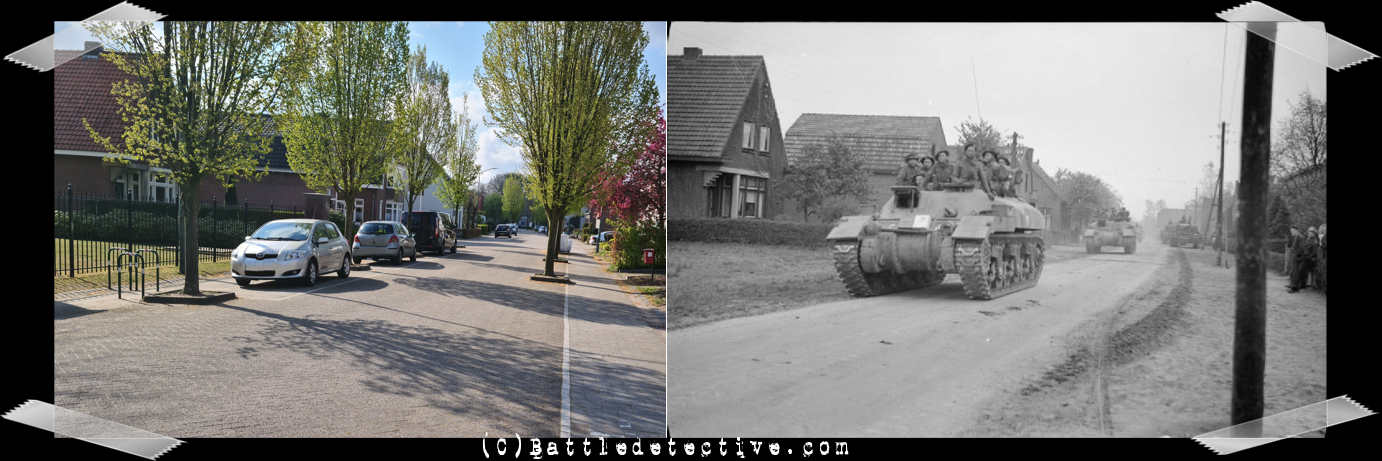 |
Moergestel,
October 25th 1944
Finally across the river Reusel,
the Scots fan out in western
direction. On Oisterwijkseweg
Kangaroos (armored personnel
carriers) dash forward towards the
objective; the city of Tilburg. |
 |
Esch, late October
1944
Allied troops were already on
Postel Straat in the village of Esch
when German troops blew up the
nearby bridge on 24OCT1944.
When the fighting had died down a
Bailey bridge was constructed. For
the 75th anniversary of the
Liberation of Esch in 2019 a
temporary plywood cover over the
bridge’s sides gave the new bridge
the impression of a Bailey bridge. |
 |
Baarle-Nassau, late October
1944
Polish MP's give directions in front
of the village pump and the town
hall. Baarle Nassau, just across the
Dutch border, was liberated on
October 28th, 1944. |
 |
Westkapelle,
November 1st 1944
British Commandos who have just
landed on the beach about a mile
behind the cameraman, advance inland
on Zuidstraat through Westkapelle
which was bombed by the Allies a
month before Operation "Infatuate
II" |
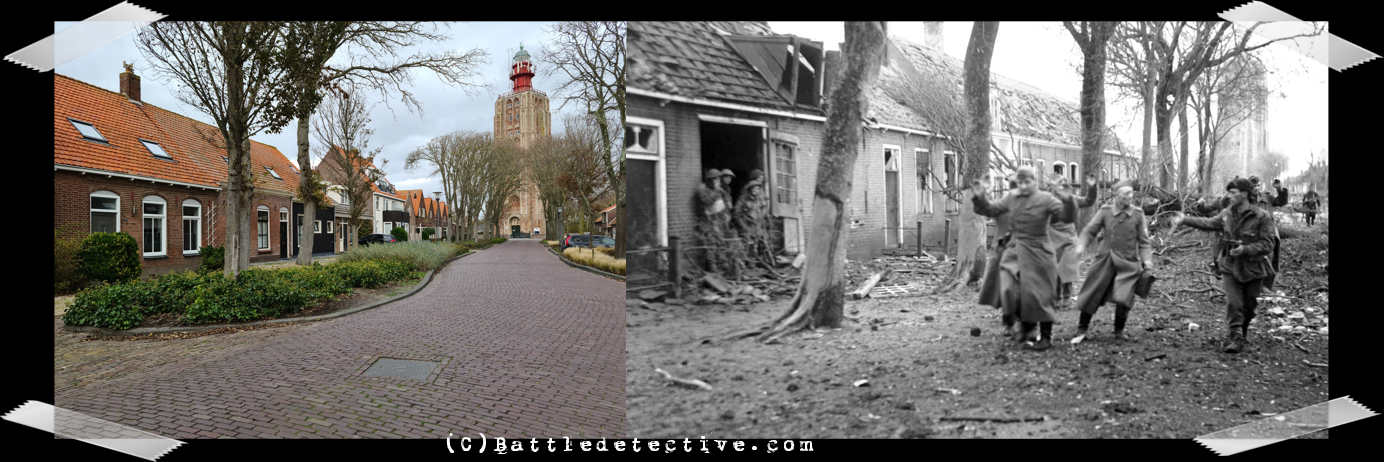 |
Westkapelle,
November 1st 1944
German Prisoners of War are
escorted to the beach during
operations to clear the Scheldt
estuary for naval traffic to the
port of Antwerp. Note the light
house in the background. |
.jpg) |
Wageningen, May
5th 1945
In Hotel "De Wereld" the
instrument of surrender of all
German military forces in the
Netherlands is presented to their
commander, Generaloberst der
Infanterie, Johannes Blaskowitz, by
Canadian commander in chief General
Foulkes. |
.jpg) |
Wageningen, May
5th 1945
Another photo taken during the
meeting with Gierman military
leaders in the Netherlands, with a
change of seats around the table
compared with the previous image.
The room is named the Grand Capitulation
Lounge
today. |
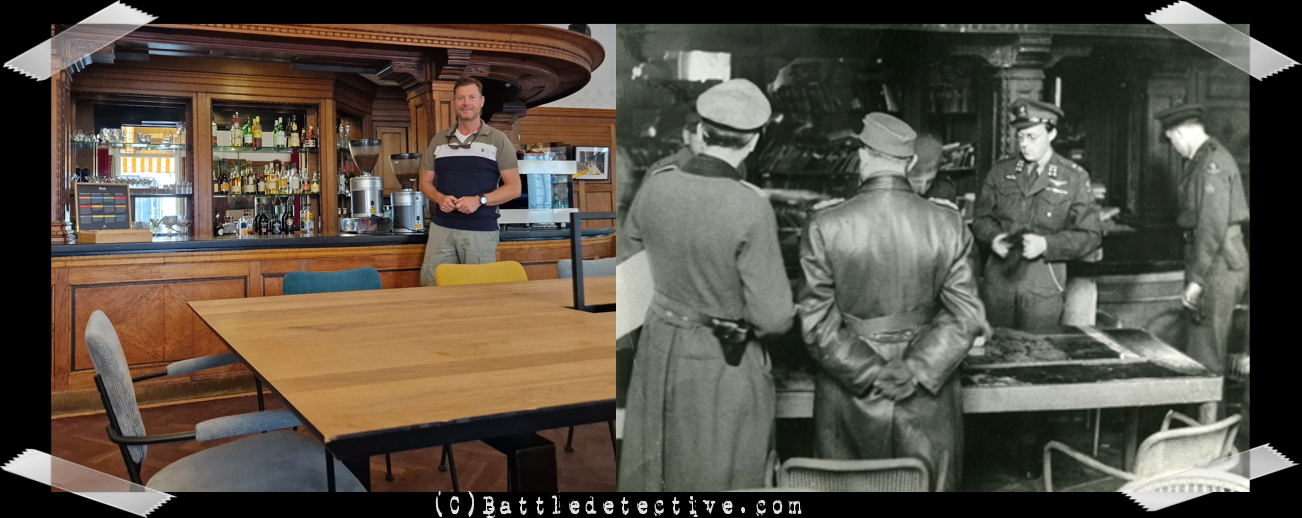 |
Wageningen, May
5th 1945
German Generaloberst Blaskowitz
(left) has just signed the surrender
orders and military-technical
attachments to execute for the
Netherlands, Foulke’s Area of
Responsibility, the overall German
surrender signed a day before in
Germany on Lüneburger Heath. |
 |
Wageningen,
Spring 1945 On Hoogstraat,
British trucks are ready to move to
the hamlet of Nude outside of town
to be loaded with food and
humanitarian aid supplies for the
needy Dutch civilians in the west of
the Netherlands. |
.jpg) |
Apeldoorn, Spring
1945
At the Woeste Hoeve Inn near
Apeldoorn British jeeps are parked
outside the inn which, judging from
the signs near the doorway, is now
in use as an Allied Command Post. |
.jpg) |
Apeldoorn, Spring
1945
Woeste Hoeve is remembered
for an incident when, during the
night of 6 March 1945, Dutch
resistance fighters shot Nazi Chief
of Police, SS General Hanns Rauter.
In Case
File #16 the post-war
identification of one of the victims
of the Nazi retaliation is
described. |
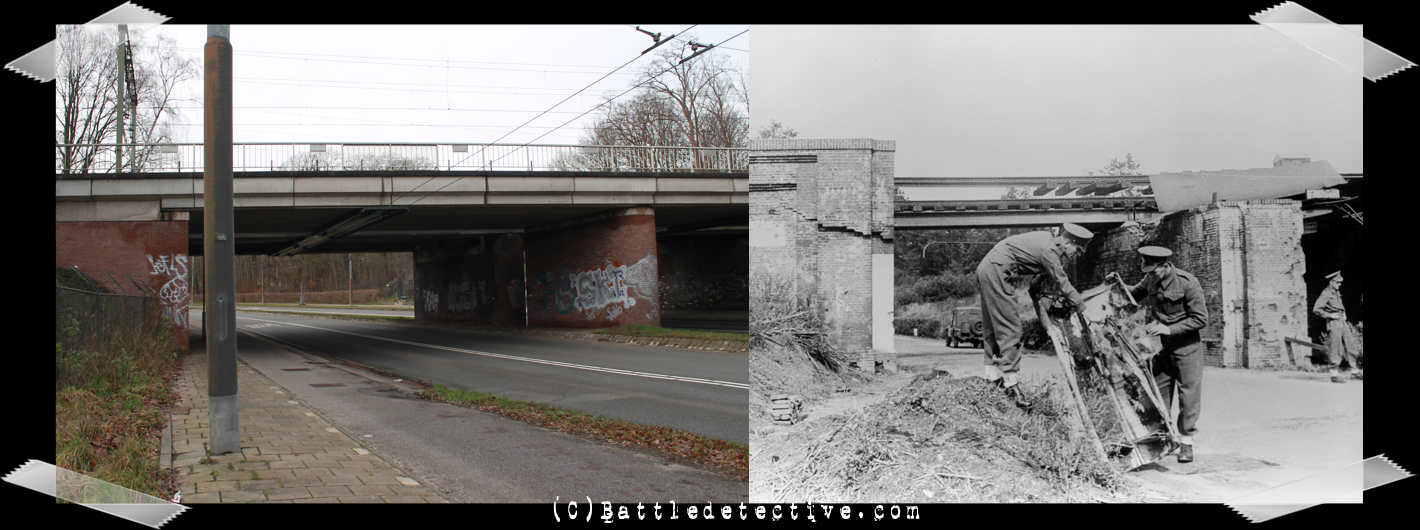 |
Arnhem, Spring
1945
After the battle two British
Military Policemen examine a "C"
type drop container used for aerial
resupply of the encircled Airborne
soldiers in the Oosterbeek
perimeter. At the other end of the
rail road underpass the fence works
around the KEMA compound can be
seen. |
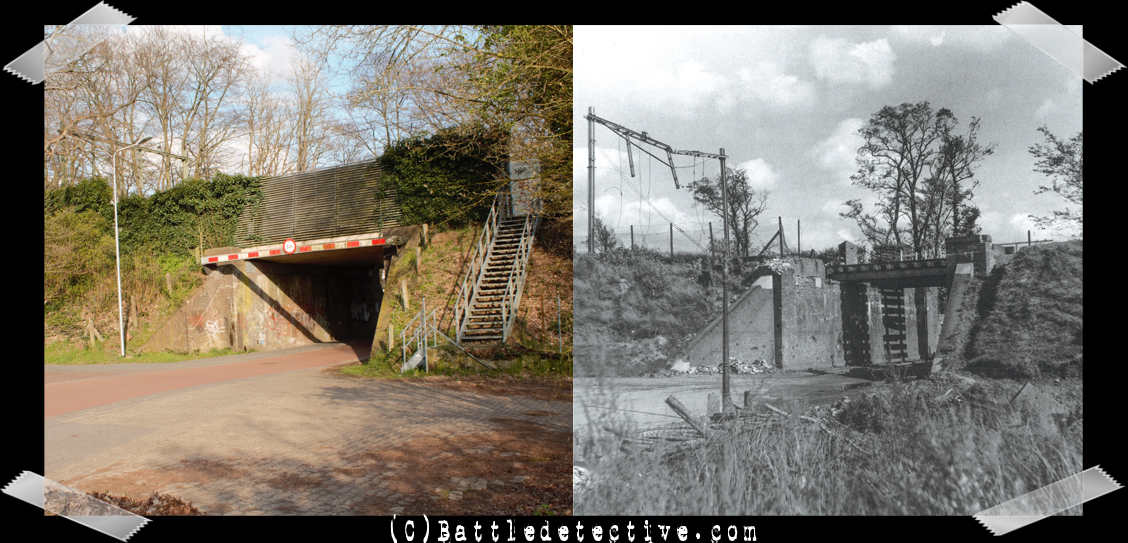 |
Oosterbeek, Spring
1945
The bullet-riddled railway
underpass on Klingelbeelseweg. This
is the route Lt-Col John Frost and
his 2nd BN took to get to Arnhem
Bridge. To the right the embankment
leads to the railway bridge which
was blown up by the Germans when the
first British paratroopers where on
it. To the left is the Oosterbeek
Laag railway station. |
 |
Arnhem, Spring
1945
"The spoils of war".
Tunnel under the railway on
Beeldhouwerstraat with Nazi gas mask
canisters, a "Panzerfaust" anti-tank
weapon, potato masher stick
grenades, an MG42 machine gun and a
hand-painted warning sign. |
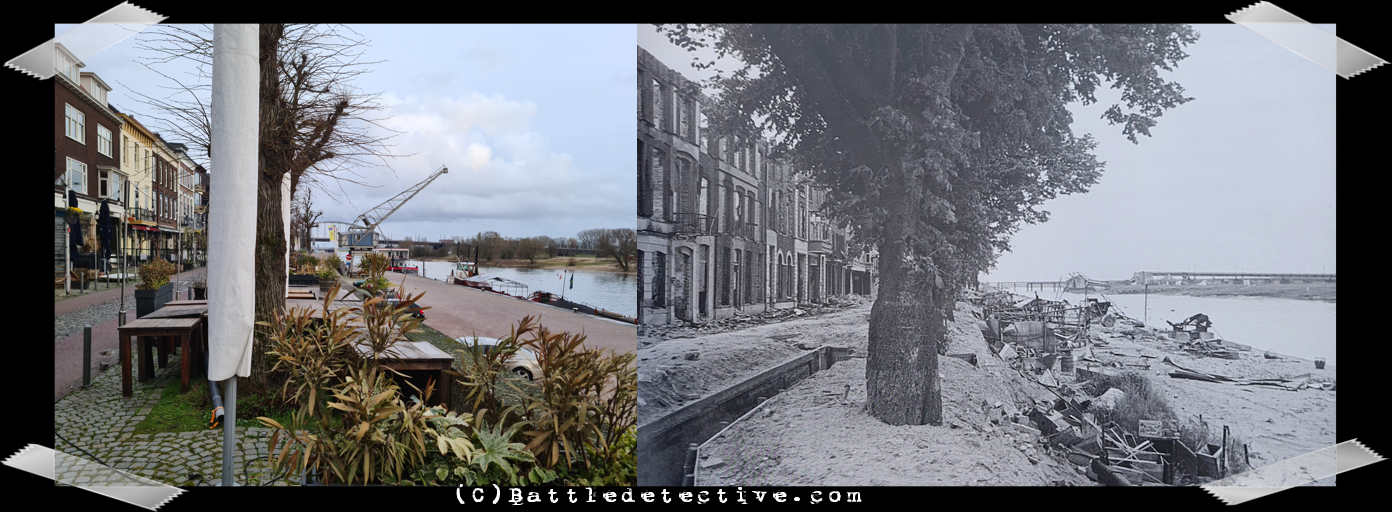 |
Arnhem, Spring
1945
On Rijnkade, the promenade on the
northern bank of the river, German
trenches dug after the Battle of
Arnhem in September 1944 can be seen
as well as the temporary Bailey
bridge across the river where the
road bridge had been destroyed by
Allied bombers. |
.jpg) |
Arnhem, 1945
A British Airborne soldier has
returned to Arnhem in April 1945 and
looks in the direction of the bridge
or rather, where it used to be as it
was destroyed by US Air Corps
bombers on October 7th, 1944. Note
bridge tower room on the right side
of the road where the Germans
positioned a anti-aircraft gun. |
.jpg) |
Arnhem, 1945
Almost the same location as the
previous one. The British Airborne
soldier and the cameraman have
turned 180 degrees and now look down
the road bridge ramp at the top of
the stairs near the Van Limburg
Stirum School. |
 |
Arnhem, 1945
Presumably the same paratrooper
looks at the field grave of an "Unbekannter
englischer Soldat"; German for
Unknown English soldier near the Van
Limburg Stirum School. |
.jpg) |
Arnhem, Spring 1945
At the Rhine river bridge
looking north.
On 07OCT1944, this bridge was
destroyed by US Army Air Forces.
The buildings in the city were
bombarded by the Allies over the
next few months and suffered further
during the Liberation of Arnhem in
April 1945. |
.jpg) |
Arnhem, Spring 1945
After the liberation of Arnhem from
12 - 16 April 1945, the cameraman
who took this photograph found the
Rhine river bridge destroyed and
German trenches still intact in the
floodplains south of the city. |
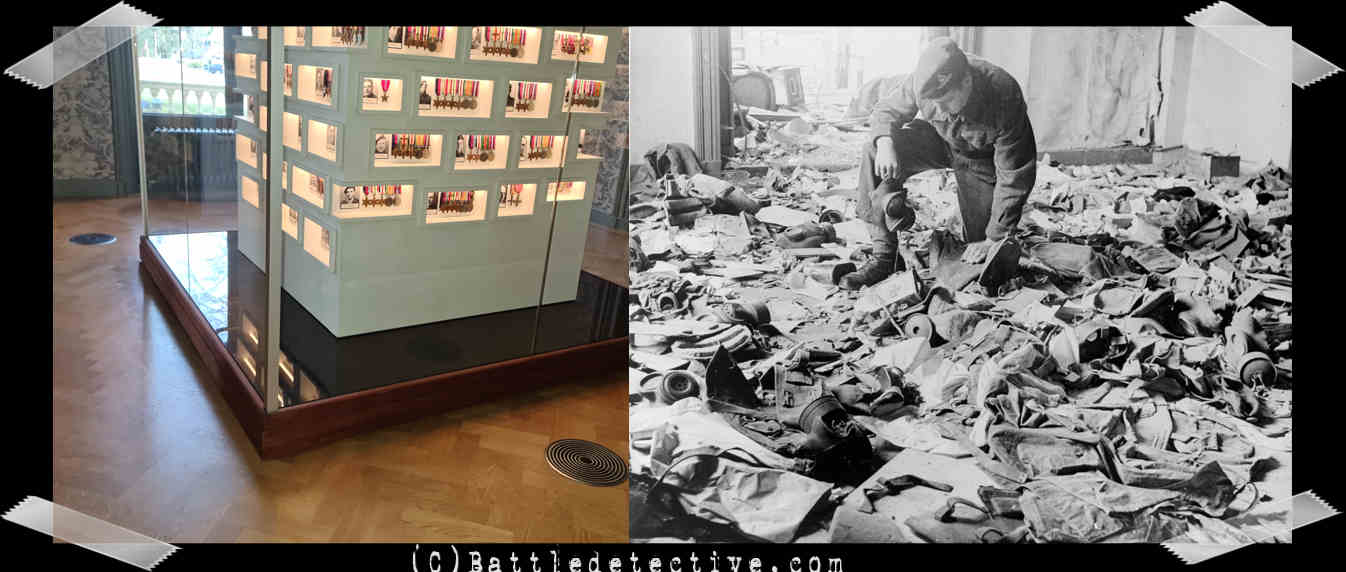 |
Oosterbeek, Spring 1945
A British soldier inspects
discarded equipment in a room in the
Hartenstein Hotel. We counted
several MkII light respirators and
their bags, helmets, Medical
Research Council (MRC) Body Armour
and assorted web equipment. Today
this room is used for changing
exhibitions. Here, medals of Allied
participants of the Battle of Arnhem
are on display. |
.jpg) |
Arnhem, 1945
On top of the Airborneplein,
looking in the direction of the
Arnhem road bridge Wrecks of
the vehicles of Hauptsturmführer
Victor Eberhard Gräbner’s SS
Reconnaissance Unit who tried to
cross the bridge into Arnhem on
September 18th 1944 is still
littering thee roundabout. |
.jpg) |
Arnhem, 1945
On Nijmeegseweg, the northern
ramp, looking in the direction of
the void where the Arnhem road
bridge was. “Now-“photo taken at
first light on a Sunday morning. |
.jpg) |
Arnhem, 1945
Òn Nijmeegeseweg on the northern
ramp of the Arnhem road bridge,
looking in the direction of the
center of the city with the
destroyed tower of the Eusebius
Church in the background. |
 |
Arnhem,
Spring 1945
The signs of Nazi occupation have
been removed as traffic and tactical
signs of the Canadian Army are fixed
to lamp posts and trees on
Velperbinnensingel. Note the sign
with "This is Holland. Remember! The
Dutch are our Allies". |
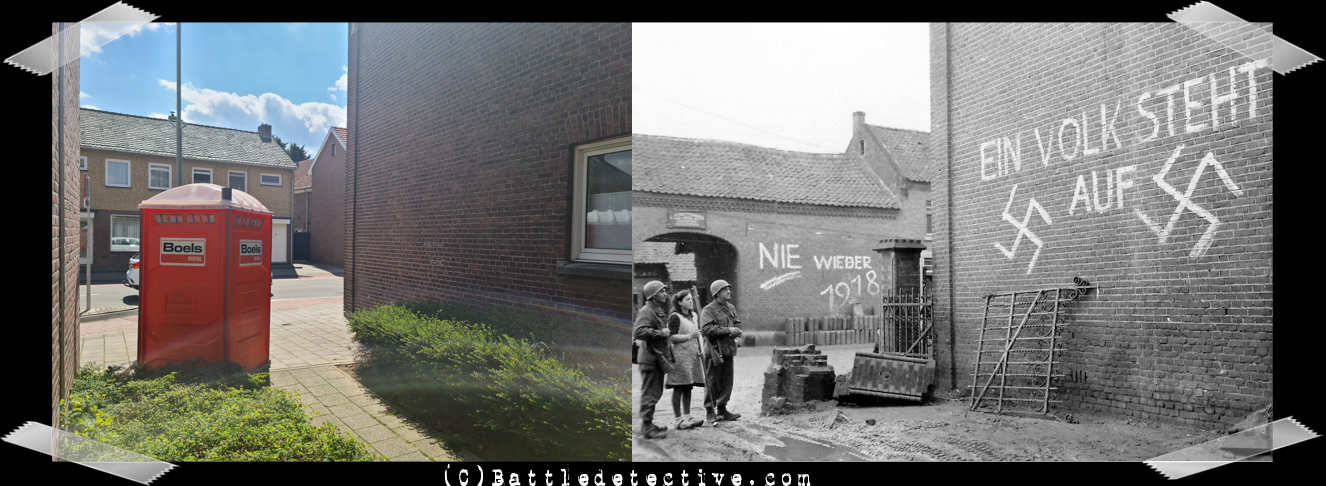 |
Echt early 1945
A woman and two American soldiers
look at Nazi graffiti: "Never 1918
again" and "A people rises". Echt is
situated in the narrowest part of
Limburg where the distance between
the Belgian frontier in the west and
the eastern border with Germany is
only 14 kilometers. These slogans
were clearly meant to inspire Nazis
traveling from Belgium back into the
Heimat. |
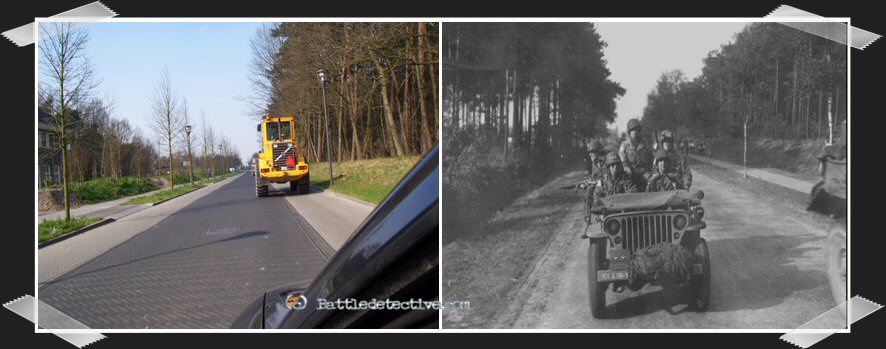 |
Son, September
17th 1944
General Taylor and his staff race in
Southern direction to Son down the
road from the Drop Zone. |
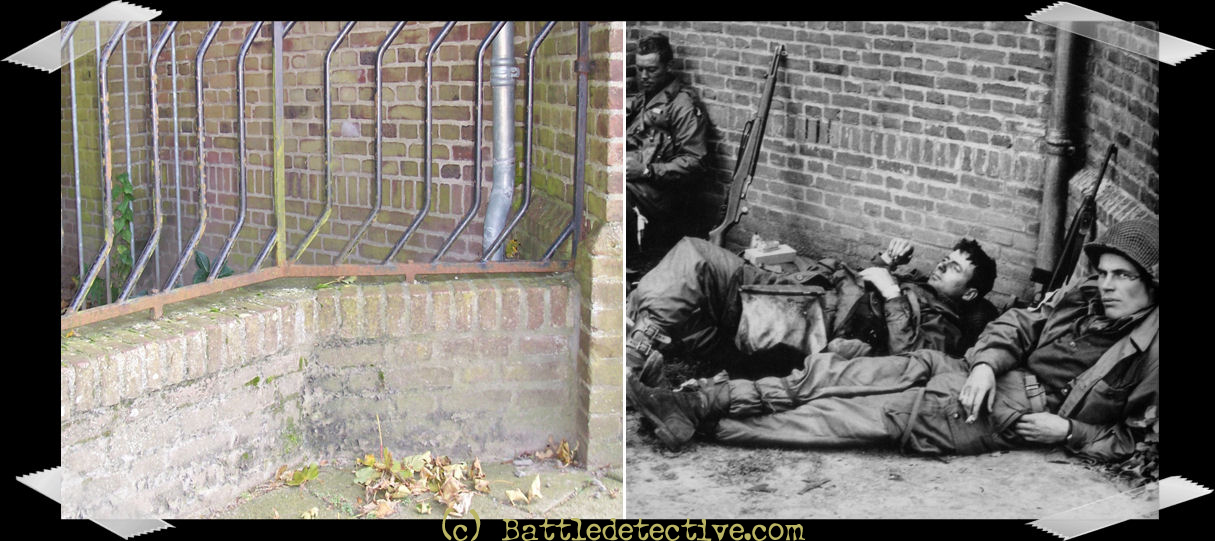 |
Eindhoven,
September 18th 1944
Lieutenants Williams, Schroeder and
Haley of HQ/506th take a break at
the foot of the Vlokhoven Church.
Note fragments of slate from the
roof tiles on the ground, shot down
by troopers aiming at the steeple
for suspected snipers. |
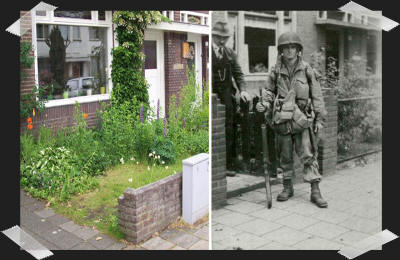 |
Eindhoven,
September 18th 1944
A paratrooper of the 506th poses for
the camera on Frankrijk Straat.
Mister Kluijtmans watches the scene
over the rims of his glasses. |
 |
Eindhoven,
September 18th 1944
Curious citizens take a look at the
German 88mm gun that paratroops of
"F"-Co./506th have just taken out on
the junction of Frankrijk Straat,
Woenselse Straat and Klooster Dreef. |
 |
Eindhoven,
September 18th 1944
After the link-up with the British
XXX Corps, paratroopers of the 506th
Regiment and American glider pilots
hitch a ride on an armored vehicle
on Frankrijk Straat. |
 |
Eindhoven,
September 18th 1944
A paratroop lieutenant takes 5
on a bench in front of No. 9
Frankrijk Straat. |
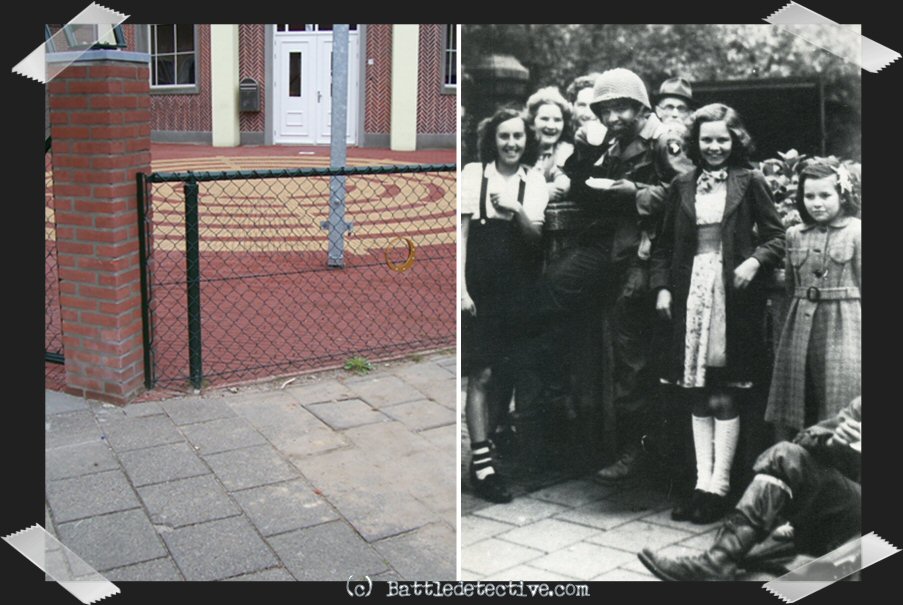 |
Eindhoven,
September 18th 1944
Annie Molteni (with striped
socks) and the Van den Broek sisters
offer paratroopers a cup of coffee
at the entrance gate of the Frater
School on Frankrijk Straat. The
school is now an Islamic elementary
school. Note Arabic half moon
ornament in today's school fence. |
 |
Eindhoven,
September 18th 1944
Annie Molteni and Lenie van den
Broek 'lead' a lieutenant of the
506th down Frankrijk Straat. |
 |
Eindhoven,
September 18th 1944
This picture is taken on Frankrijk
Straat; just a few hundred yards
South of the two German 88mm guns
that "F"-Co./506th destroyed on
Klooster Dreef (see specific
Case File
# 2). In the photo we see
Colonel Robert F. Sink, the
Commanding Officer of the 506th
Parachute Infantry Regiment, walking
towards the center of Eindhoven. |
 |
Eindhoven,
September 18th 1944
This picture is taken on Frankrijk
Straat; just a few hundred yards
South of the two German 88mm guns
that "F"-Co./506th destroyed on
Klooster Dreef (see specific Case
File # 2). In the photo we see
Colonel Robert F. Sink, the
Commanding Officer of the 506th
Parachute Infantry Regiment, walking
towards the center of Eindhoven. |
 |
Eindhoven,
September 18th 1944
Under the watchful eyes of
liberated citizens, paratroopers of
the 506th Parachute Infantry
Regiment escort German Prisoners of
War south to the midtown area on
Klooster Dreef. We have identified
one of the
German soldiers who was wounded a
few hundred yards up this street. |
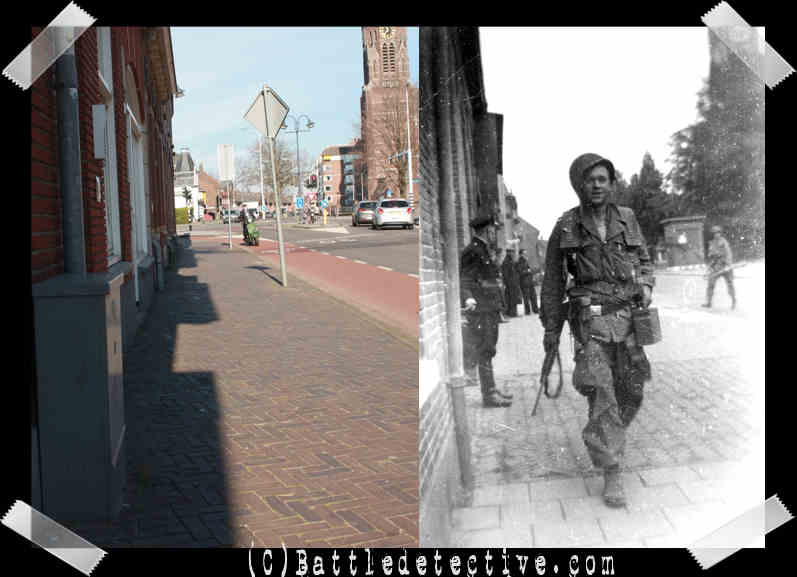 |
Eindhoven,
September 18th 1944
A paratrooper of the 506th
Parachute Infantry Regiment walks
south in the direction of the center
of the city; where the bridges
across the Dommel river are. He is
armed with an M1 Carbine and carries
a can of .30 caliber machine gun
ammunition. He wears a German belt
and pistol holster which he must
have ‘liberated’ after engagements
with German soldiers in Son or
Woensel. |
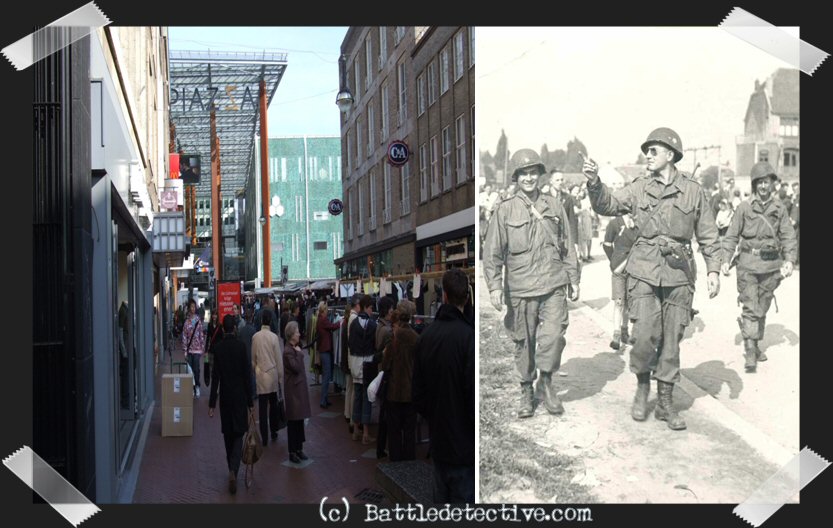 |
Eindhoven,
September 18th 1944
Major Oliver Horton, Commanding
Officer of 3rd Bn and Captain
Harwick of "H"-Co./506th walk South
on Demer. Demer was almost a vacant
lot in 1944 as a result of an R.A.F.-bombing
raid on the nearby Philips Factory
on December 6th 1942.
|
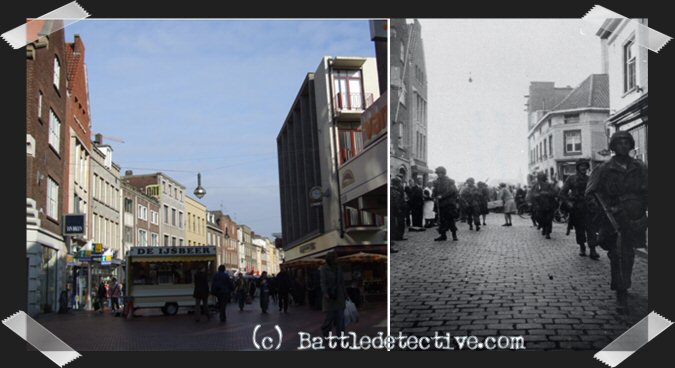 |
Eindhoven,
September 18th 1944
A bit further South someone took
this picture of a group of
paratroopers. In the "Now-"picture
only the two buildings on the left
have survived the 1942 bombing and
the city's modernization. |
 |
Eindhoven,
September 18th 1944
Paratroopers of the 506th Parachute
Inf. Regt. move towards the bridges
across the Dommel River on Ten Hage
Straat. |
 |
Eindhoven,
September 18th 1944
A paratrooper takes five on the
steps of No. 11 Ten Hage Straat. |
 |
Eindhoven,
September 18th 1944
Paratroopers of the 506th
Parachute Infantry Regiment move
south passed the Sint Catharina kerk
(Saint Catharine’s Church) and the
Peek & Cloppenburg clothing store
toward the Dommel river bridge a few
hundred yards ahead. |
 |
Eindhoven,
September 18th 1944
This, of course, is a classic!
Paratroopers of "HQ"- Co./506th
Regiment take five in front of the
Catharina Church in the center of
Eindhoven. |
 |
Eindhoven,
September 18th 1944
Troops of the 506th Regiment use a
pram to haul their equipment on
Keizers Gracht. |
 |
Eindhoven,
September 18th 1944
Four paratroopers of the 3rd
Battalion of the 506th Parachute
Infantry Regiment pose for the
camera in front of their M19191 A6
.30 caliber machinegun position on
the lawn of the Van Abbe Museum. The
sign on the right points to the
nearest air raid shelter. The
machinegun is positioned to cover
one of the Dommel river bridges
which is just to the left of the
picture. |
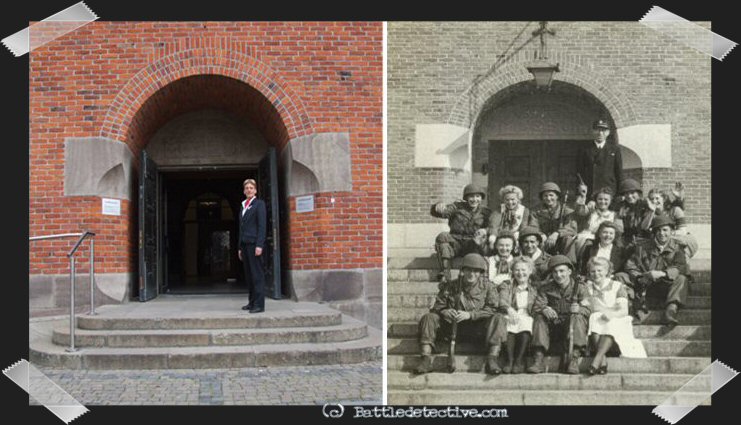 |
Eindhoven,
September 18th 1944
Paratroopers of the 506th take time
to pose with nurses on the steps of
the Van Abbe Museum. Note the
uniformed museum guard in the back
of the 1944 photo. Today's guard
posed for our comparison picture. |
 |
Eindhoven,
September 18th 1944
An officer of "HQ"-Co./506th with
his radio operator near the harbor
in Eindhoven. We used an even older
picture for comparison this time.
The aerial photograph shows where
the picture is taken near one of the
bridges that were the objectives of
the 101st in Operation Market
Garden. |
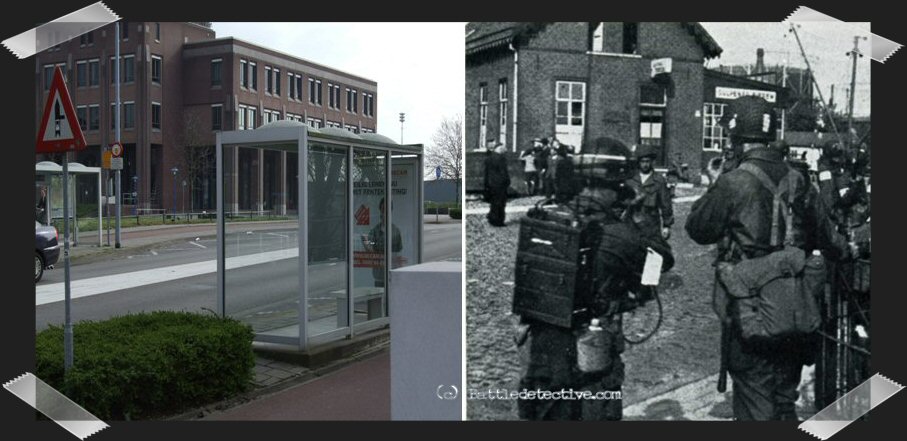 |
Eindhoven,
September 18th 1944
This is the Then & Now comparison
picture of the photos described
above. The Eindhoven Canal harbor
has no industrial function anymore
and the regional Electricity Company
now has its office building on the
site of the café in the "Then-"
pictures. |
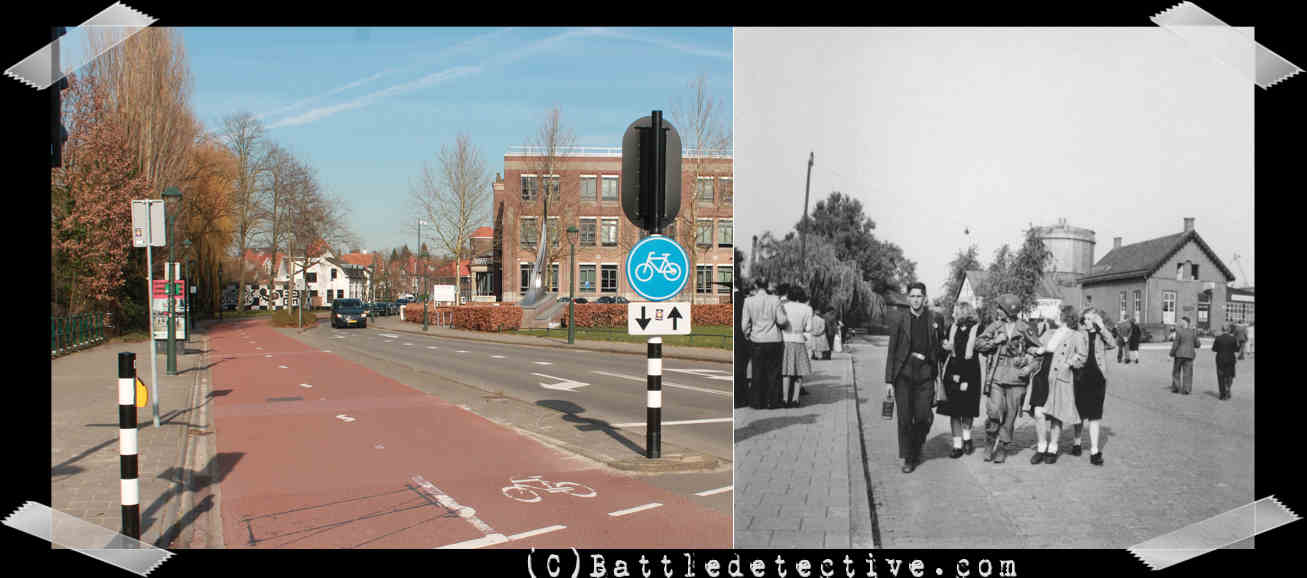 |
Eindhoven,
September 18th 1944
A paratrooper of the 2nd Battalion
of the 506th Parachute Infantry
Regiment is flanked by three lovely
ladies from Eindhoven and has a
resistance fighter, who is armed
with a German K98 Mauser rifle,
carry his .30 caliber machine gun
ammunition can. This is near the
Dommel river bridge on
Nachtegaallaan. |
 |
Eindhoven,
September 18th 1944
Two paratroopers of the 506th
Parachute Infantry Regiment are
pictured near the Dommel river
bridge on the corner of Bleekstraat,
Kanaalstraat, Nachtegaallaan and
Kanaaldijk-Zuid. The soldier on the
right appears to be an officiers
with his binoculars and map case. |
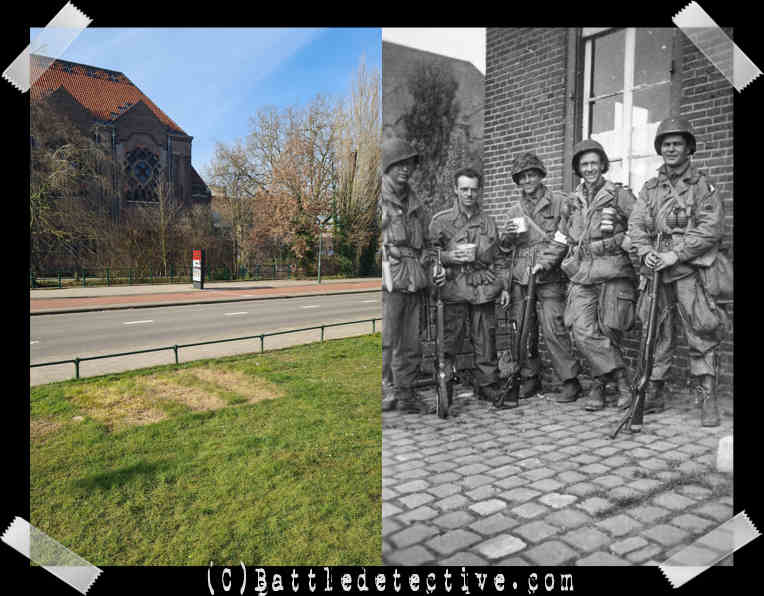 |
Eindhoven,
September 18th 1944
Private First Class Eugene
“Gene” Elbert Gilbreath from
Atlanta, Missouri (left) and four
other paratroopers of Headquarters
Company, 2nd Battalion, 506th
Parachute Infantry Regiment are
resting near the Dommel river bridge
on the corner of Bleekstraat,
Kanaalstraat, Nachtegaallaan and
Kanaaldijk-Zuid. This bridge was not
nearly as large as the Waal river
bridge at Nijmegen and the Rhine
river bridge at Arnhem, but
nonetheless vital in the chain of
waterway crossings along the Main
Supply Route of British XXXth Corps
in Operation “Market Garden”. |
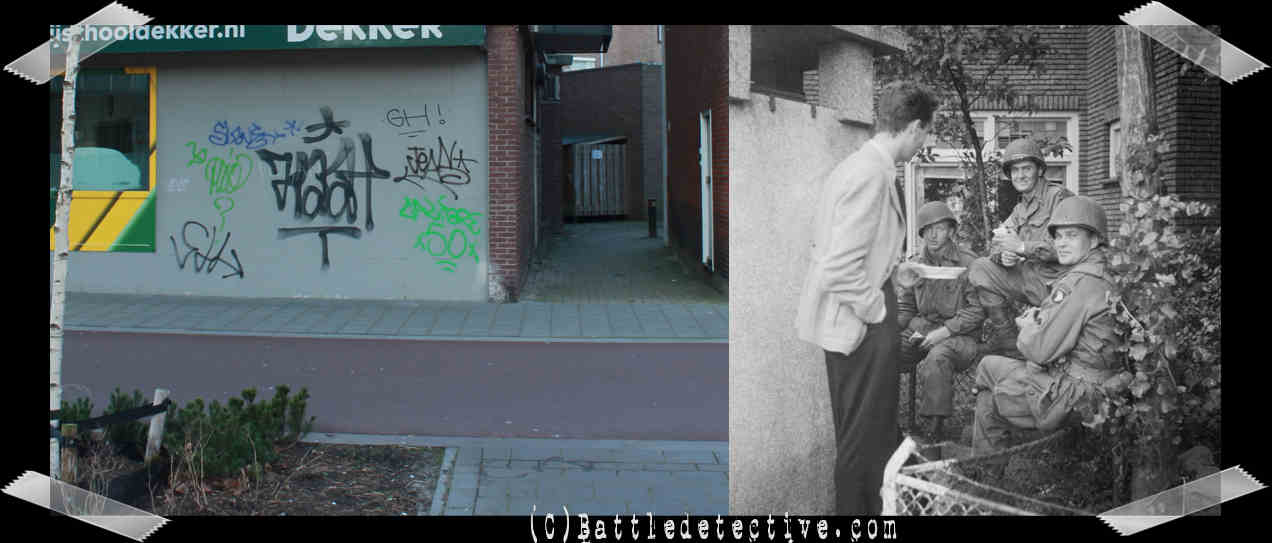 |
Eindhoven,
September 18th 1944
PFC Gene Gilbreath and two of
his buddies of HQ CO, 2nd BN of the
506th PIR on Hertogstraat. The
location of this photo was a
challenge but the mysterious
structure on the left of the photo
provided a solid lead. We found it
on
an image of the block where the
nearby AB Theater used to be. |
 |
Eindhoven,
September 18th 1944
Captain Clarence Hester,
S3-(Operations) Officer of 3rd Bn/506th
inspects the troops on Geldropseweg
on his Cushman 53 Airborne Scooter.
The bicycle stands in for the
Cushman Scooter. |
 |
Eindhoven,
September 18th 1944
Again Captain Clarence Hester. He is
on the same spot as in the previous
photograph, only the photographer
has changed position. The symbol on
today's bicycle lane seems to
indicate the spot of the Cushman
Scooter in 1944! |
 |
Eindhoven,
September 18th 1944
Paratroopers of "E"-Co./506th
Regiment discuss tactics on Vestdijk.
|
 |
Eindhoven,
September 18th 1944
A member of the Eindhoven Police
Dept. summons civilians to stay
indoors because not all German
soldiers have surrendered yet. A
trooper of the 506th rides along on
Grote Berg. |
 |
Eindhoven,
September 18th 1944
Three pictures of paratroopers in
the center of Eindhoven. All
photographs have the Philips
"Light-tower" in the background; a
duration test lab for light bulbs.
The trooper in the photograph on the
right carries the "Radio Set
SCR-300-A BC-1000-A". |
 |
Eindhoven,
September 18th 1944
Paratroopers pose with a motorcycle
on Emma Singel, near the Philips
"Light-tower". |
 |
Eindhoven,
September 18th 1944
Two photographs taken just moments
after each other by Eindhoven
photographer A. van Beurden on
Stratums Eind. The Dutch priest is
Deken ("deacon") Maas and the US
priest is Father McGettigan,
Chaplain of the 506th Regiment. |
 |
Eindhoven,
September 18th 1944
A Sky Soldier is lifted on the
shoulders of happy citizens on
Stratums Eind. |
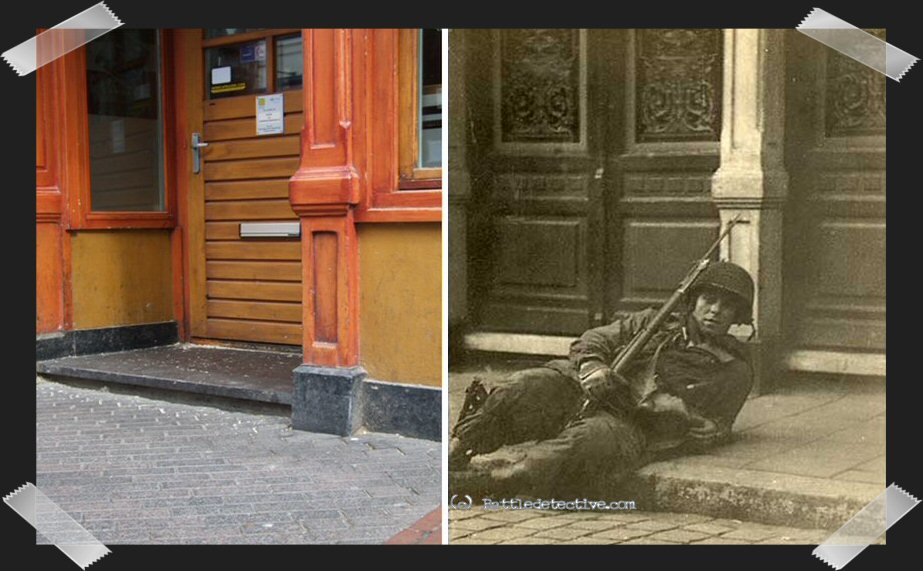 |
Eindhoven,
September 18th 1944
A paratroopers takes five on
Stratums Eind; bayonet fixed. |
 |
Eindhoven,
September 18th 1944
Almost the same position as the
previous picture but taken from the
first floor of the Hoppenbrouwers
Family across the street. This is
Café "Fenix" in 1944 or "The Krazy
Kangaroo" today. |
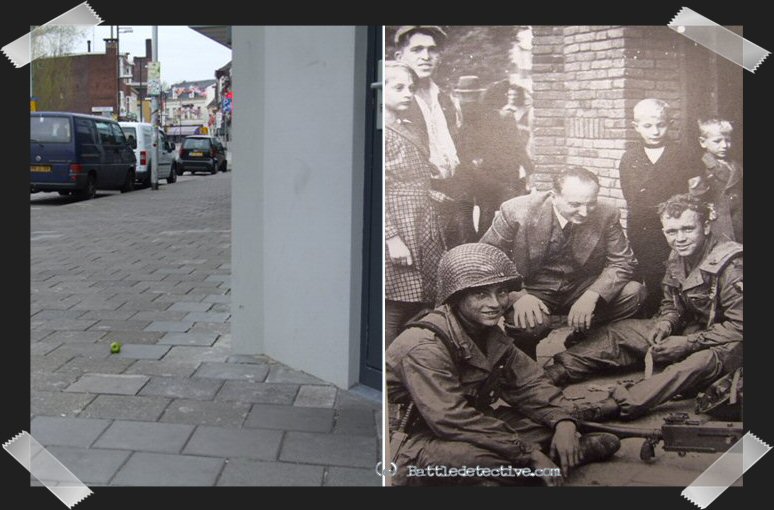 |
Eindhoven,
September 18th 1944
A .30 caliber machine gun crew takes
position near one of the bridges
across the Dommel River on Stratums
Eind. This is Café "Dijk 9" today.
The trooper in front is Harold C.
Boye of "A"-Co./506th who was Killed
in Action a few weeks after this
photograph was taken. |
.jpg) |
Eindhoven,
September 18th 1944
"A Bridge Not Too Far". The
bridges across the Dommel river in
the center of the city of Eindhoven
where the southern-most waterway
crossings to be captured by Allied
airborne units during Operation
"Market Garden". |
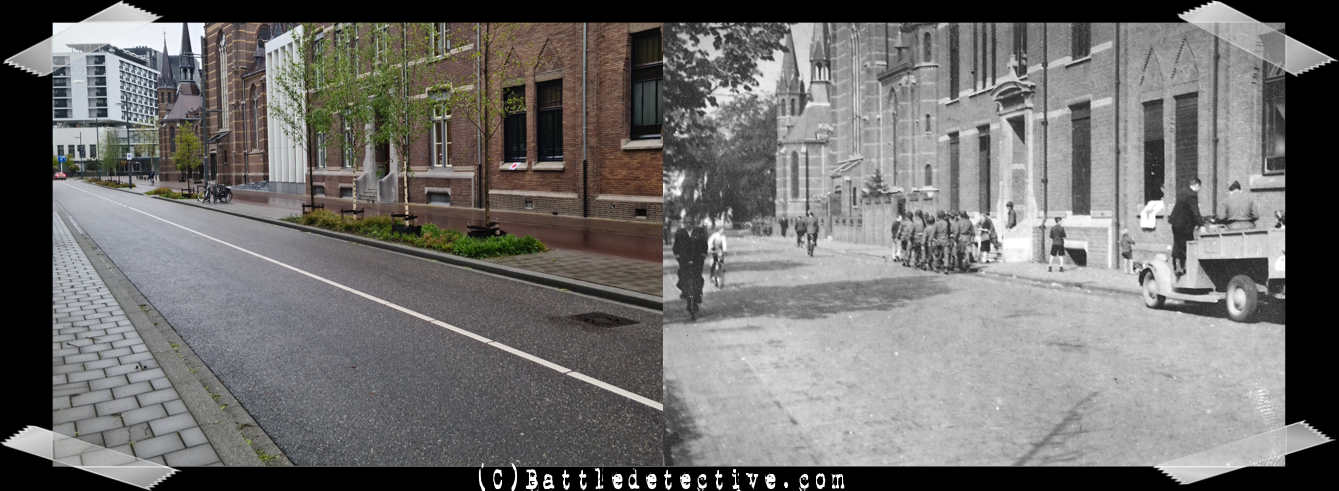 |
Eindhoven,
September 18th 1944
Paratroopers take up defensive
positions near the Dommel river
bridge on the intersection of
Kanaalstraat, Bleekstraat,
Nachtegaallaan and Kanaaldijk-Zuid.
In the monastery a Red Cross flag in
the window indicates the presence of
an aid station. |
.jpg) |
Eindhoven,
September 18th 1944
Paratroopers take up defensive
positions near the Dommel river
bridge in the south western corner
of the intersection at a café. The
porch has been removed after the
war. |
.jpg) |
Eindhoven,
September 18th 1944
Paratroopers of the 506th
Parachute Infantry Regiment take up
defensive positions near the Dommel
river bridge on the intersection of
Kanaalstraat, Bleekstraat,
Nachtegaallaan and Kanaaldijk-Zuid. |
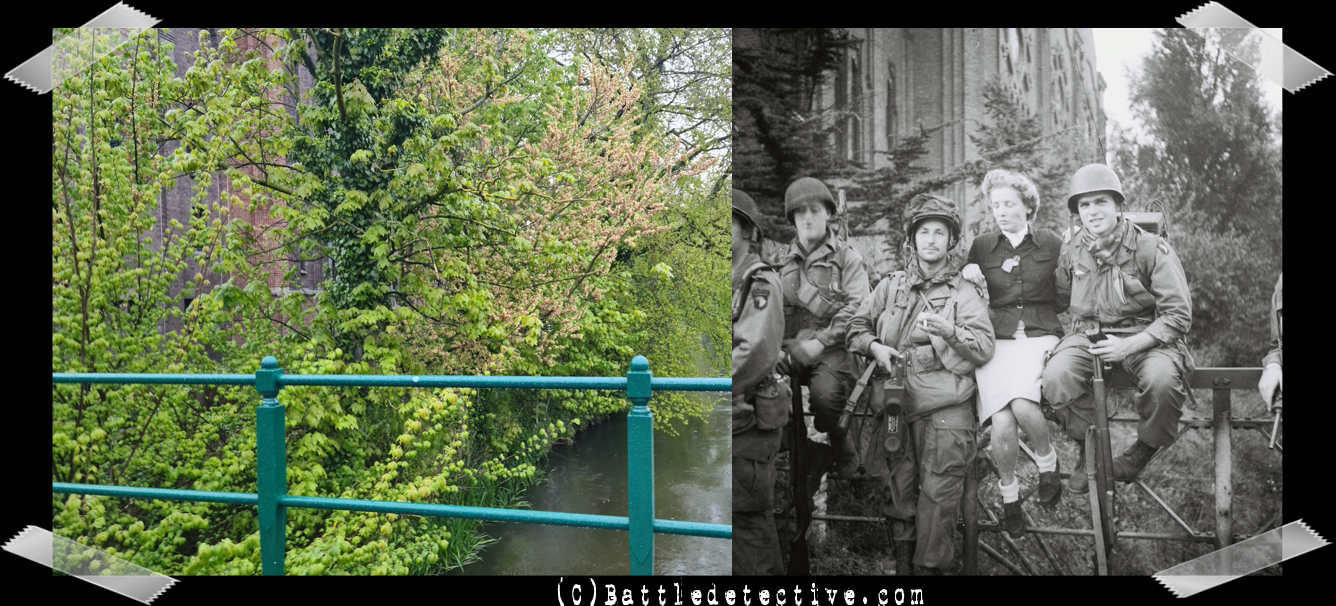 |
Eindhoven,
September 18th 1944
A local lady from Eindhoven is
sitting on the Dommel river bridge’s
railing flanked on her left by a
paratrooper with an SCR-300-A
BC-1000-A radio on his back and a
sky soldier on her right who holds a
BC-611 (SCR-536) "Handie-Talkie" in
his hand. |
 |
Eindhoven,
September 18th 1944
Eindhoven citizens flock around a
paratrooper armed with a .30 calibre
M1 Carbine in front of the
Mariënhage convent. The civilian on
the left got an American invasion
flag as a souvenir which he pinned
on his coat. |
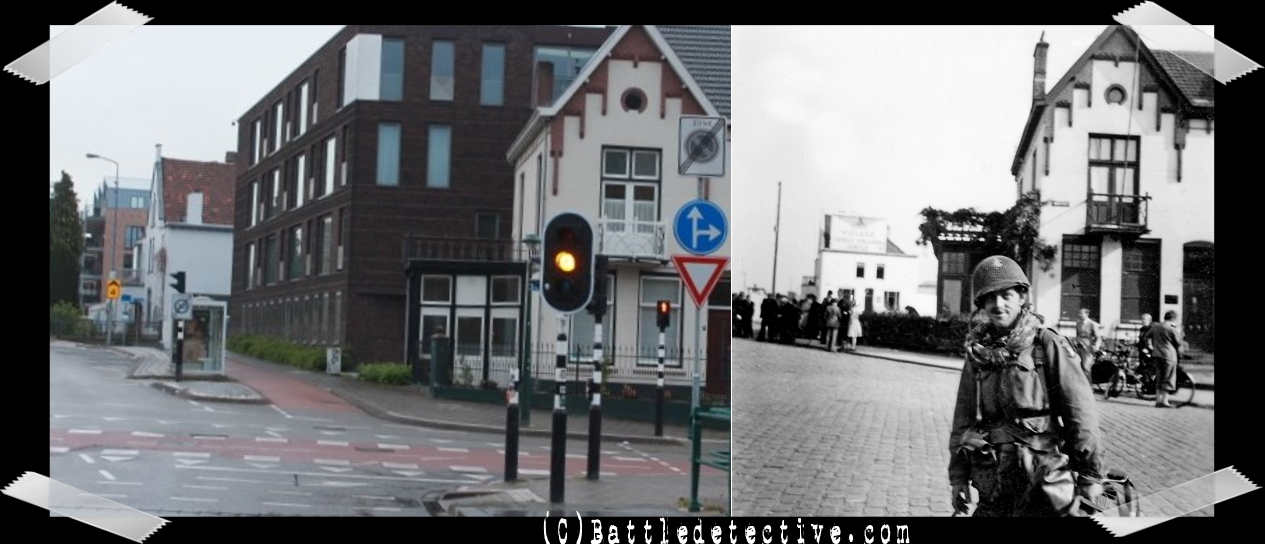 |
Eindhoven,
September 18th 1944
Lt. Thomas A. Rhodes Jr. of "F"
Company of the 506th Parachute
Infantry Regiment is photographed on
the Dommel river bridge. He is
wearing a scarf made from parachute
fabric. |
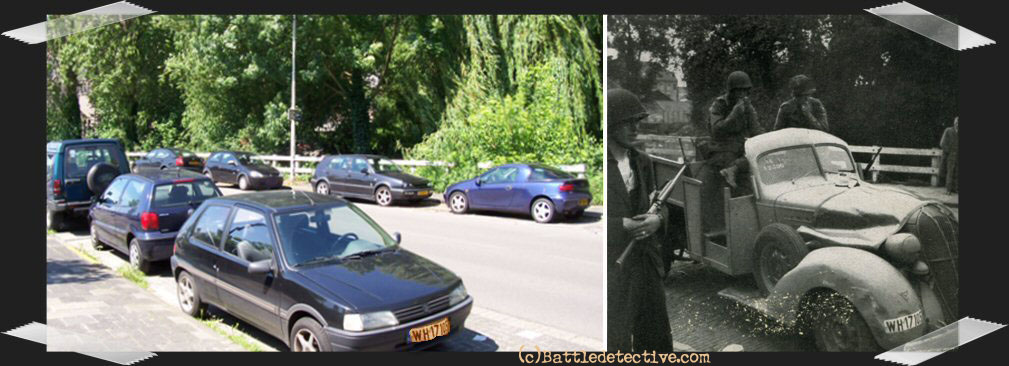 |
Eindhoven,
September 18th 1944
Two paratroopers of "C"-Co./506th in
a captured German "Umbauwagen",
pick-up truck. This is on Nagtegaal
Laan. |
 |
Eindhoven,
September 18th 1944
The same street with troopers of 3rd
Bn./506th, who attract quite a crowd
of liberated citizens. |
 |
Eindhoven,
September 19th 1944
The next day the Umbauwagen was used
to transport one of the heavy
weapons platoons of the 506th. This
is on 't Hofke. |
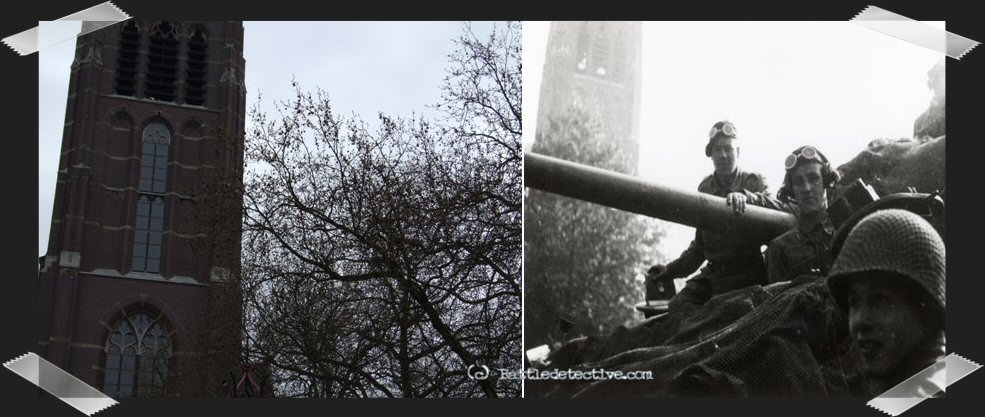 |
Eindhoven,
September 18th 1944
No British tanks anymore, no
paratroopers, but the St Joris
Church tower still stands on
Stratumse Dijk. |
 |
Eindhoven,
September 18th 1944
Another .30 caliber machine gun crew
has taken position in the front yard
of the house of the Roman Catholic
Priest of the St. Joris Church on
Saint Joris Straat. |
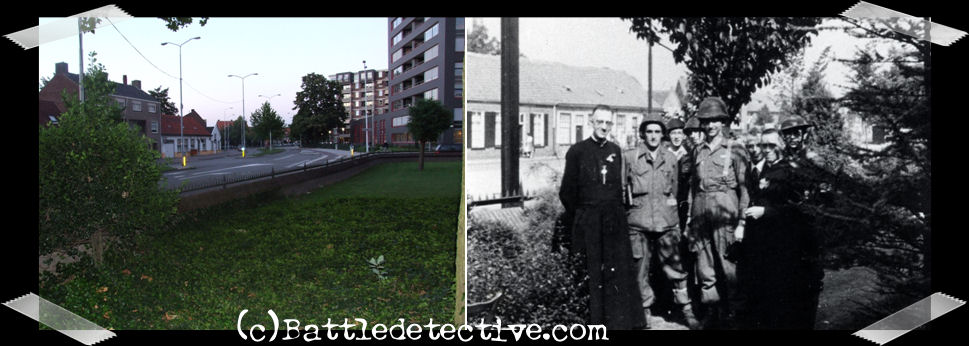 |
Eindhoven,
September 18th 1944
Paratroopers pose with priests and
Dutch resistance fighters in the
front yard of the Parish House on
St. Joris Straat. |
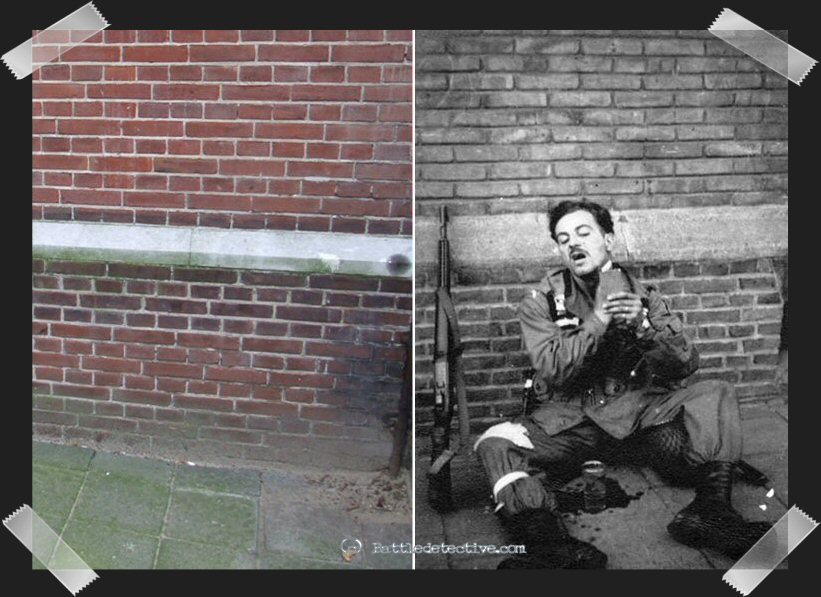 |
"UNDER
INVESTIGATION"
Eindhoven, September 18th 1944
This picture is still "Under
Investigation". When taking the
comparison picture of the .30
caliber machine gun crew near the
St. Joris Church, we made the
working hypothesis that this is the
same wall used as background by this
shaving paratrooper. |
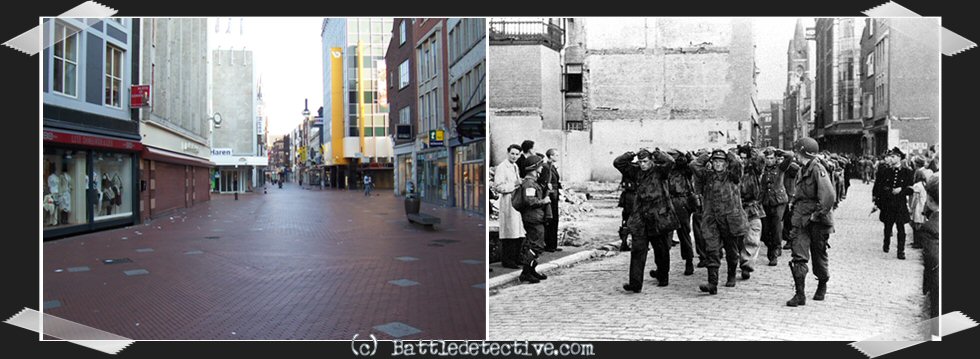 |
Eindhoven,
September 18th 1944
Paratroopers of the 506th Parachute
Inf. Regt. assisted by members of
the Eindhoven Police Dept. escort
German P.O.W.s in Northern direction
on Demer. |
 |
Eindhoven,
September 18th, 1944
A large crowd has gathered in front
of the Eindhoven Police Headquarters
on Groote Berg as resistance workers
round up Nazi sympathizers. |
 |
Eindhoven,
September 18th 1944
The crowd watches collaborators
being brought in by members of the
PAN resistance group on Hagenkamp
Weg. |
 |
Eindhoven,
September 18th, 1944
Eindhoven Boy Scouts are put to use
in 'guarding' Nazi sympathizers
locked up in the Don Bosco School. |
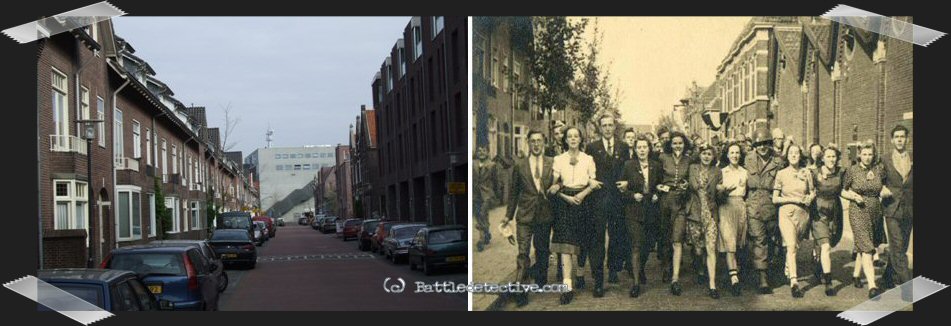 |
Eindhoven,
September 18th 1944
A paratrooper and his new best
friends on Tram Straat. |
 |
Eindhoven,
September 18th 1944
Spontaneous celebration by the
people of Eindhoven on Markt. |
 |
Eindhoven,
September 19th 1944
Troopers of 3rd Bn./506th march
towards Welschap Air Base on a
combat patrol, aimed at expanding
the perimeter around Eindhoven. |
 |
Eindhoven,
September 19th 1944
Another picture showing 3rd Bn
marching by.
This picture is taken from the
rooftop of the Eindhoven Police
Headquarters. The building has
changed dramatically over the years. |
 |
Eindhoven,
September 19th 1944
Water-pump station at the rail road
depot, demolished by German sabotage
units, seen from the Dommel Bridge
on Park Laan. |
 |
Eindhoven,
September 19th, 1944
Paratroops hitch a ride on a British
tank on Wal. |
 |
Son, September
19th 1944
Another view of the knocked-out
Panther tank on the South side of
the Wilhelmina Canal. |
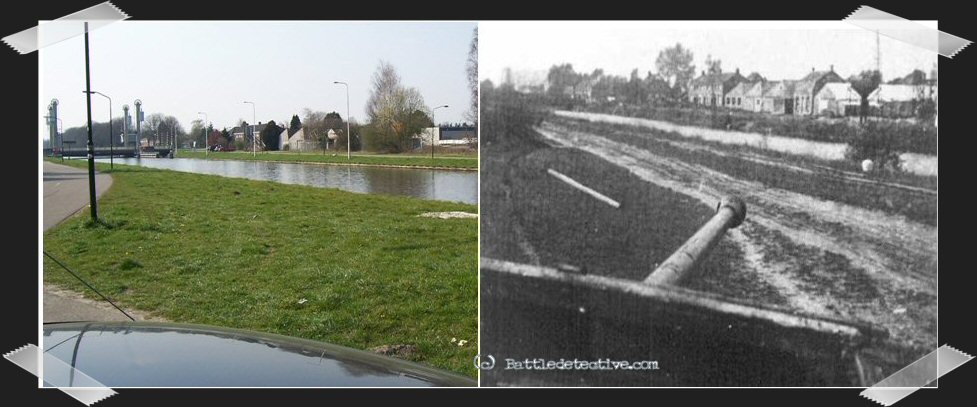 |
Son, September
19th 1944
A Panther tank of German
Panzerbrigade 107 has reached the
Wilhelmina Canal near the repaired
bridge of Son. It is knocked out by
artillery of the 101st Airborne
Division. |
 |
Dinther, September 17th 1944
After landing on Drop Zone "A-1",
L.t. Col. Harry W.O. Kinnard's 1st
Bn./501st moved through the town of
Heeswijk en route to Veghel. |
 |
Dinther,
September 17th 1944
Paratroopers of 1st. Bn./501st move
through Dinther's Main Street. |
 |
Dinther,
September 17th 1944
Paratroopers of 11st. Bn./501st
guard German POW's in the yard in
front of the Saint Willibrord Chruch.
The battalion had been misdropped at
the nearby Heeswijk castle and
marched through the towns of
Heeswijk and Dinther towards their
objective Veghel. |
 |
Heeswijk,
September 17th 1944
Advancing to their objectives in
Veghel, Lt. Col. Kinnard's troopers
of 1st Battallion of the 501st pass
the town hall of Heeswijk. |
 |
Heeswijk,
September 17th 1944
Here paratroopers of 1st Bn/501 move
through School Straat near the house
named "Hogenhof". This was the main
road to Veghel. A new parallel road
now runs behind these houses. |
 |
Veghel, September
17th 1944
Paratroopers enter Veghel on Nieuw
Straat or Deken van Miert Straat
today. |
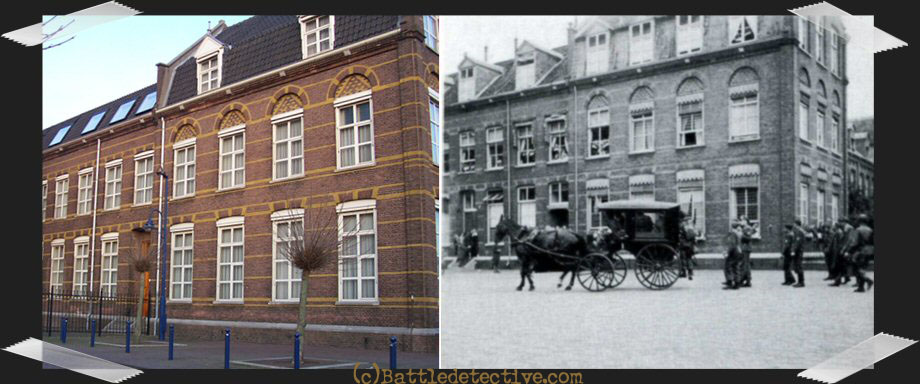 |
Veghel, September
17th 1944
German prisoners of war pass the
nunnery in Veghel to bring a dead
soldier in a hearse to the cemetery. |
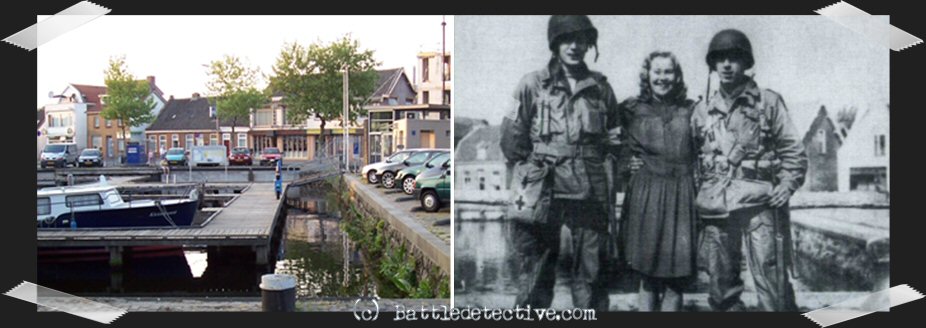 |
Veghel, September
17th 1944
Medic William A. France, Greetje de
Wit of Veghel and Private Leonard
Cinquanta pose at the harbor. |
 |
Veghel, September
20th 1944
Soldiers of the 326th Airborne
Engineers pass a burned-out GMC
truck on Hoog Straat in Veghel. |
 |
Veghel, September
1944
The harbor in Veghel. The 101st
Airborne Division Headquarters was
in the CHV building on on the far
right. |
 |
Veghel, September
1944
Damage to the Fransiscan nuns
convent from German mortar shelling. |
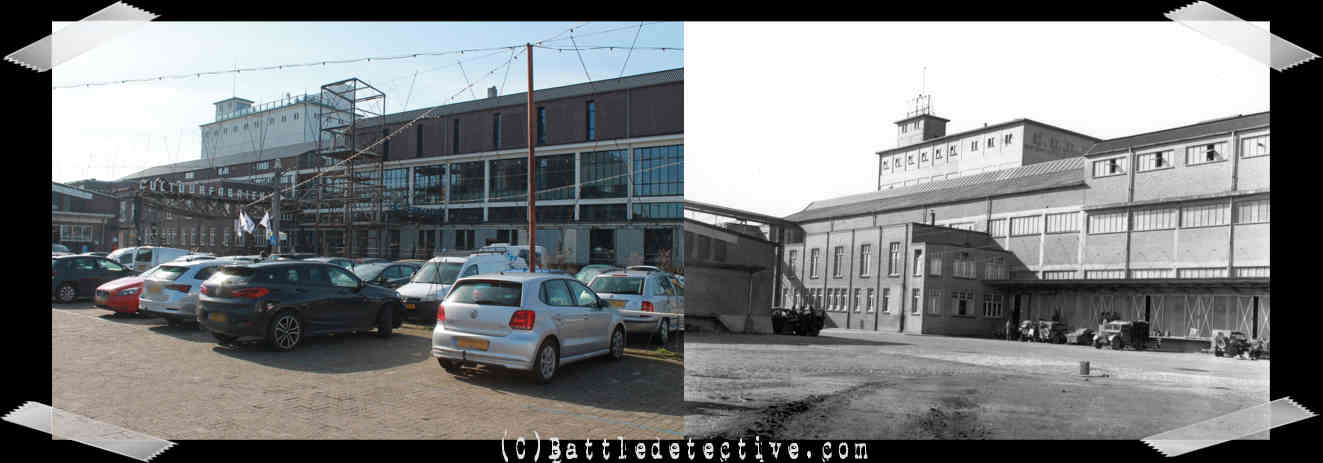 |
Veghel, September
24th 1944
Shortly before the Germans cut
"Hell's Highway" at Koevering, the
101st Airborne Divisional HQ had
moved to Veghel in the cattle feed
warehouse close to the harbor.
Division HQ stayed here until
4OCT1944 when the division moved to
“The Island”. |
 |
Oosterbeek,
September 21st 1944
Royal Electrical and Mechanical
Engineers of the 1st British
Airborne Division cook a meal near
the tennis courts behind Hotel
Hartenstein The courts served as a
POW cage for about 200 German
prisoners. After the war, REME
veterans donated the bench at this
same spot. |
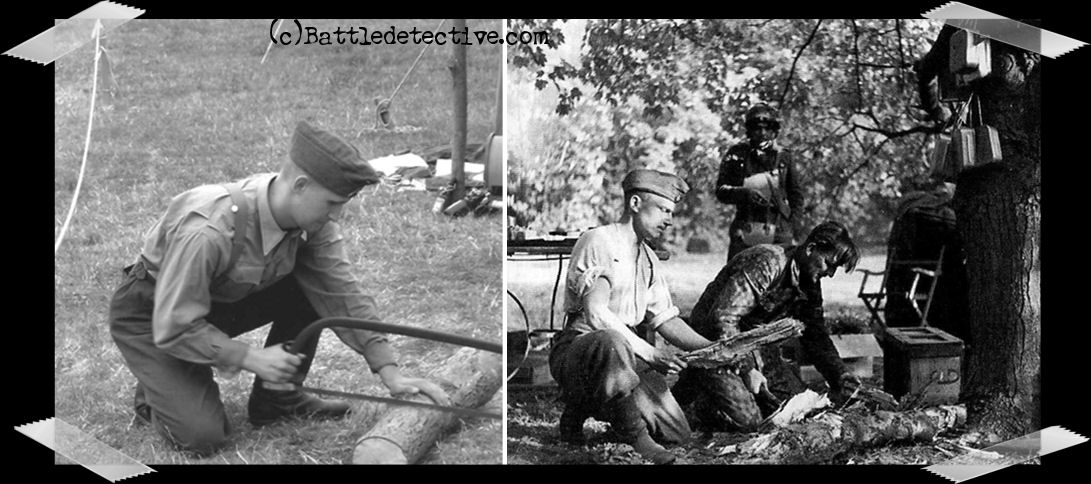 |
Oosterbeek,
September 21st 1944
German POW's saw fire wood at the
Hartenstein tennis court, guarded by
a glider pilot. We took the
"Now-photo" at the War and Peace
show in Beltring, England in 2005.
We believe the Nazi-reenactor was
unaware of his resemblance to a POW
in 1944. |
 |
Oosterbeek,
September 1944
German infantrymen move forward
toward British positions on the
corner of Dam and Wever Straat. They
then take paratroopers of the 11th
Bn. prisoner who are marched away in
front of the same house. The
"Now-photo" shows battledetectives
Tom and Ivo on the same location in
period gear and transportation. |
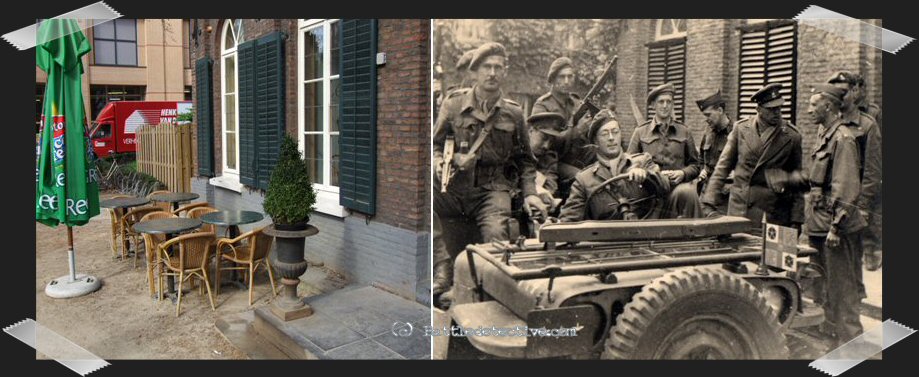 |
Eindhoven,
September 23rd 1944
Prince Bernhard of The Netherlands
visits Eindhoven shortly after the
city's liberation and is seen here
with his staff leaving the
Ravensdonck Hotel. |
 |
Eindhoven,
September 1944
The Partizanen Actie Nederland
marches on Bilderdijk Laan. The PAN
was an underground resistance group,
but could operate freely after the
liberation. From that day on, the
organization saw its ranks grow. |
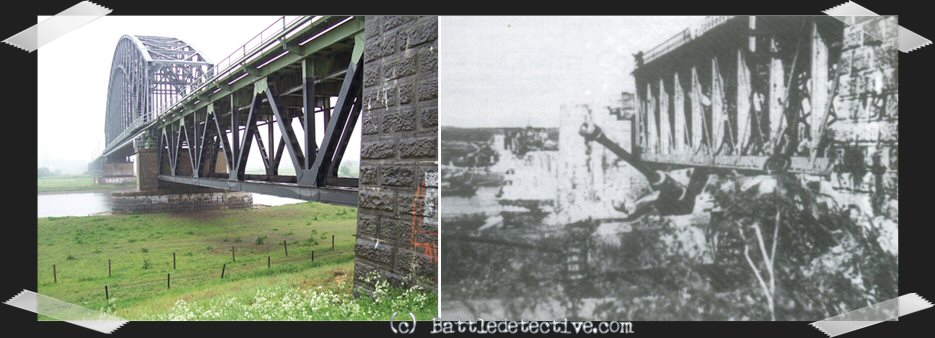 |
Driel, October
5th 1944
Radio Operator Frank Carpenter of "C"Co./501st
Regiment knocked out a German tank
underneath the railwaybridge using a
British anti-tank gun. Note the
railway bridge in the rear which was
blown up by the Germans on September
17th 1944, when British paratroopers
where already on it. |
 |
Driel, October
5th 1944
The same knocked-out tank seen from
a different angle. |
 |
Zetten, October
1944
Troops of the 101st move South from
Indoornik in the direction of
Andelst. |
 |
Zetten, October
1944
Detail of the previous picture,
showing the road sign and the
electrical power house. Note the
sign saying: "Dangerous. Post no
bills on this building" and the
poster in our
"Same-Place-Different-Situation-"comparison.
|
 |
Opheusden,
October 1944
Soldiers of the 506th move along the
railway tracks near the Opheusden
Railway Station. |
 |
Oirschot, October
2nd, 1944
Because German spotters were
suspected in the church steeple,
British artillery fired incendiary
shell into the Oirschot church,
setting it on fire. |
 |
Oirschot, October
23rd, 1944
Scottish troops move into Oirschot
through Rijkesluis Straat. |
 |
Oirschot, October
23rd, 1944
Scottish troops are welcomed by
citizens at the corner of Gasthuis
Straat and Rijkesluis Straat. |
 |
Oirschot, October
23rd, 1944
Finally! Allied military vehicles in
Rijkesluis Straat. Today, Oirschot
is close to a large military
facility and olive green trucks are
still a common sight in town |
 |
Utrecht, May, 7th
1945
Although the German armed forces in
The Netherlands had officially
surrendered on May 5, 1945, some
Nazi fanatics took shots at
civillians and British troops in
Bren carriers celebrating the
liberation in Utrecht on May 7.
Dutch resistance fighters return
fire with Sten guns.
|
|
|


